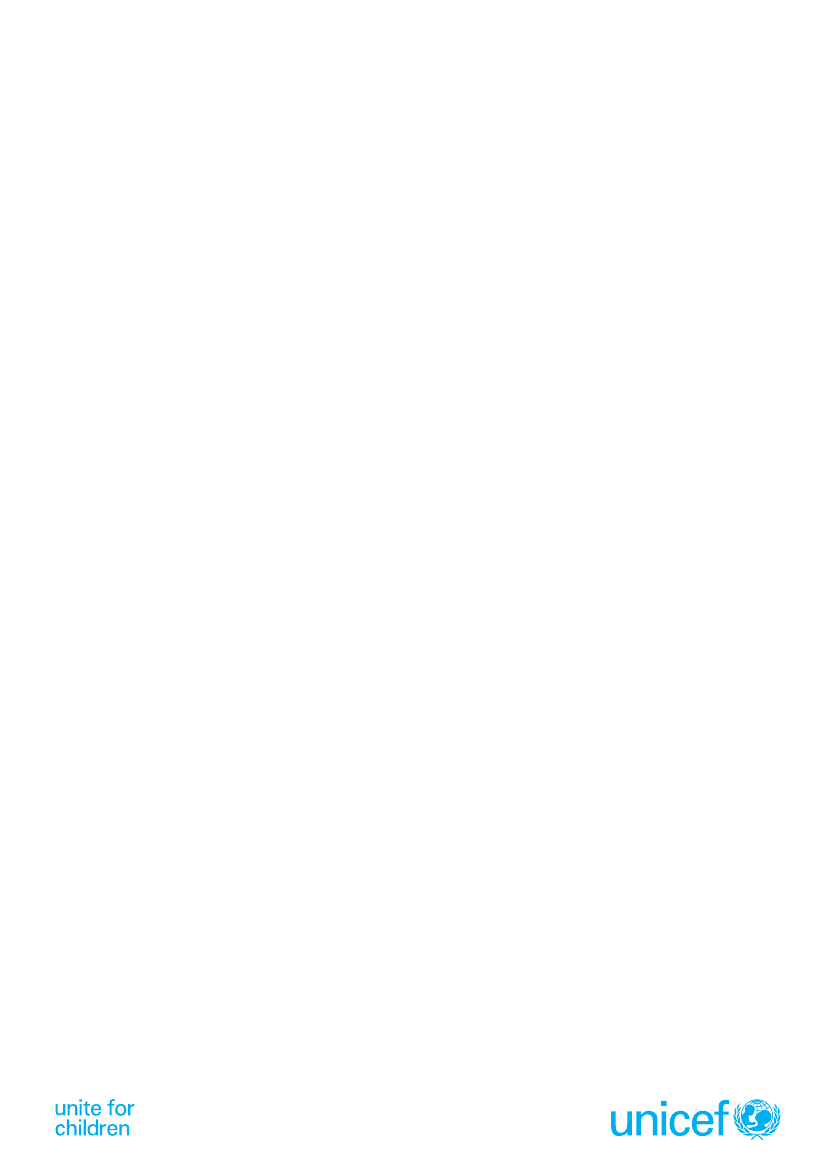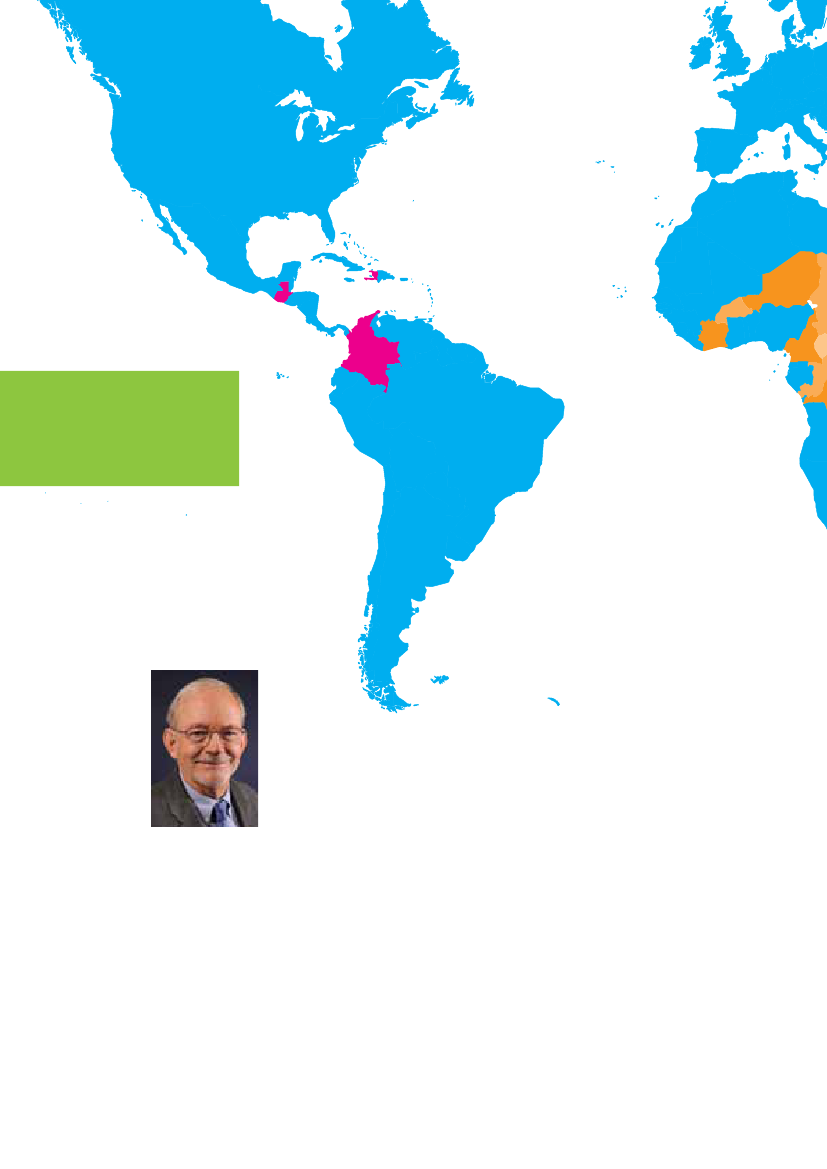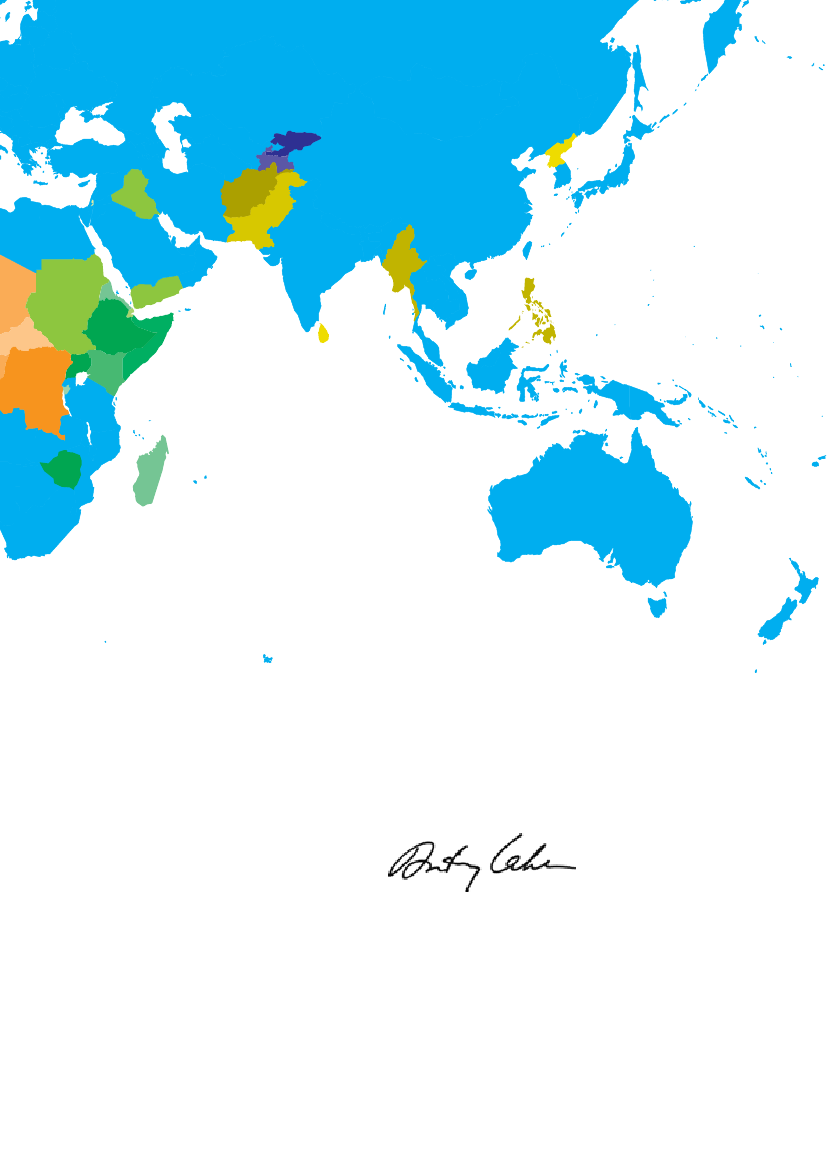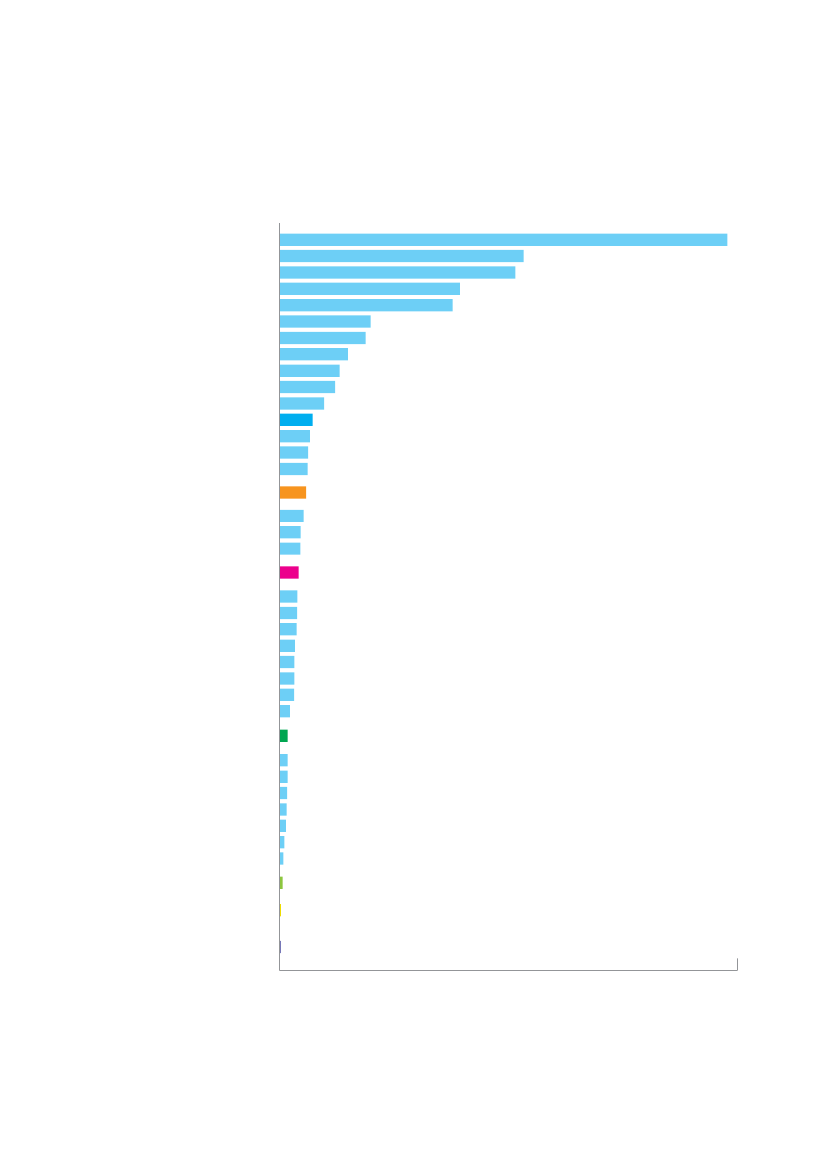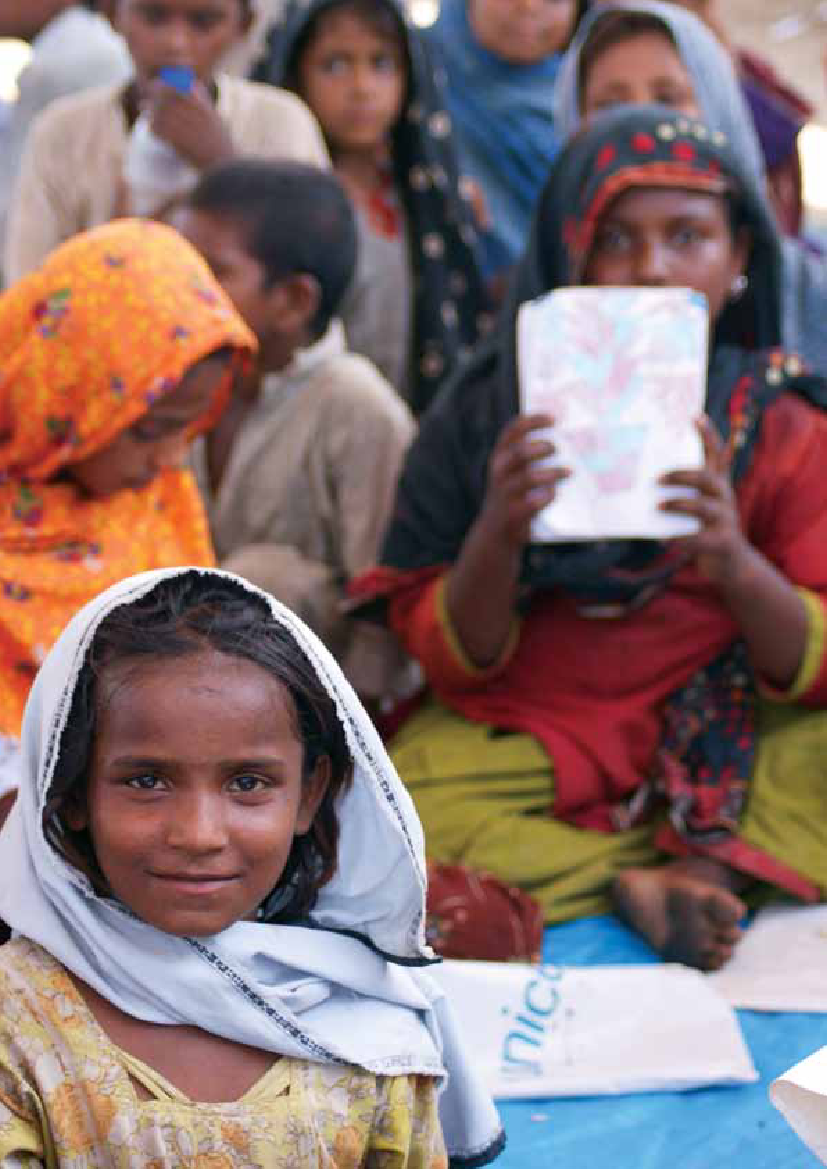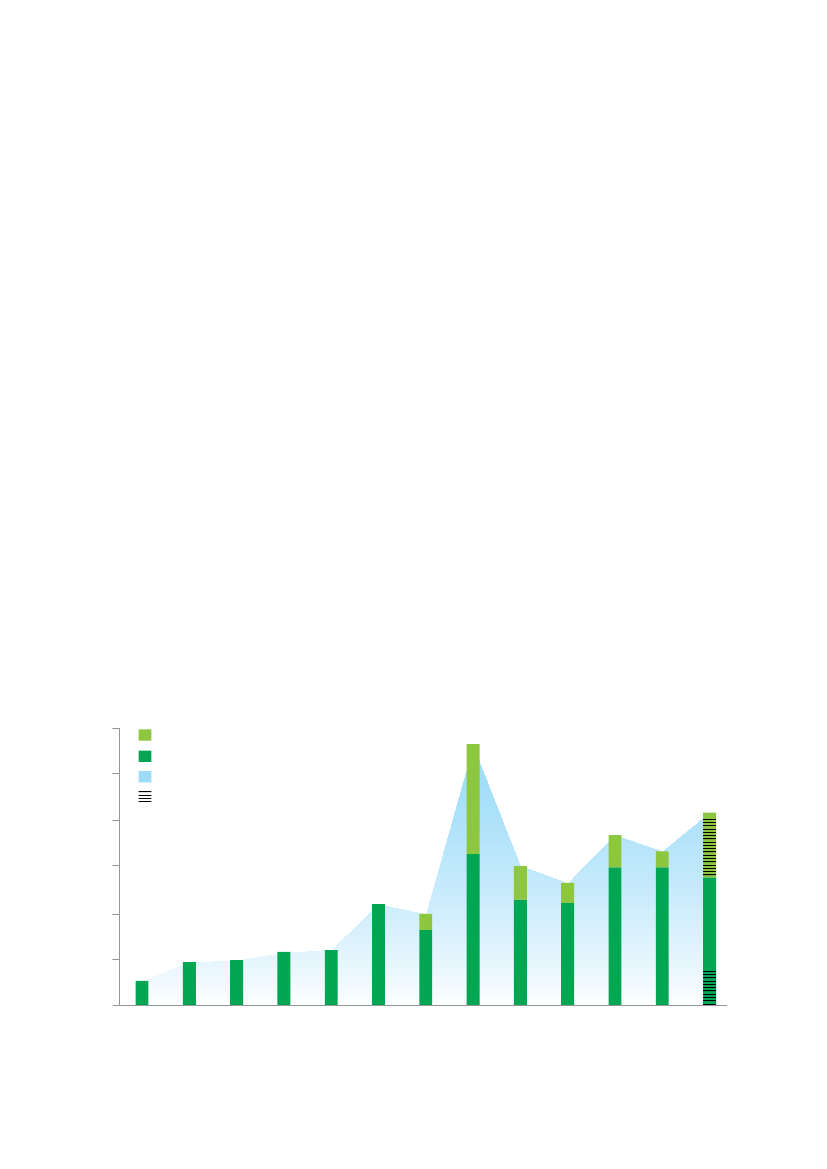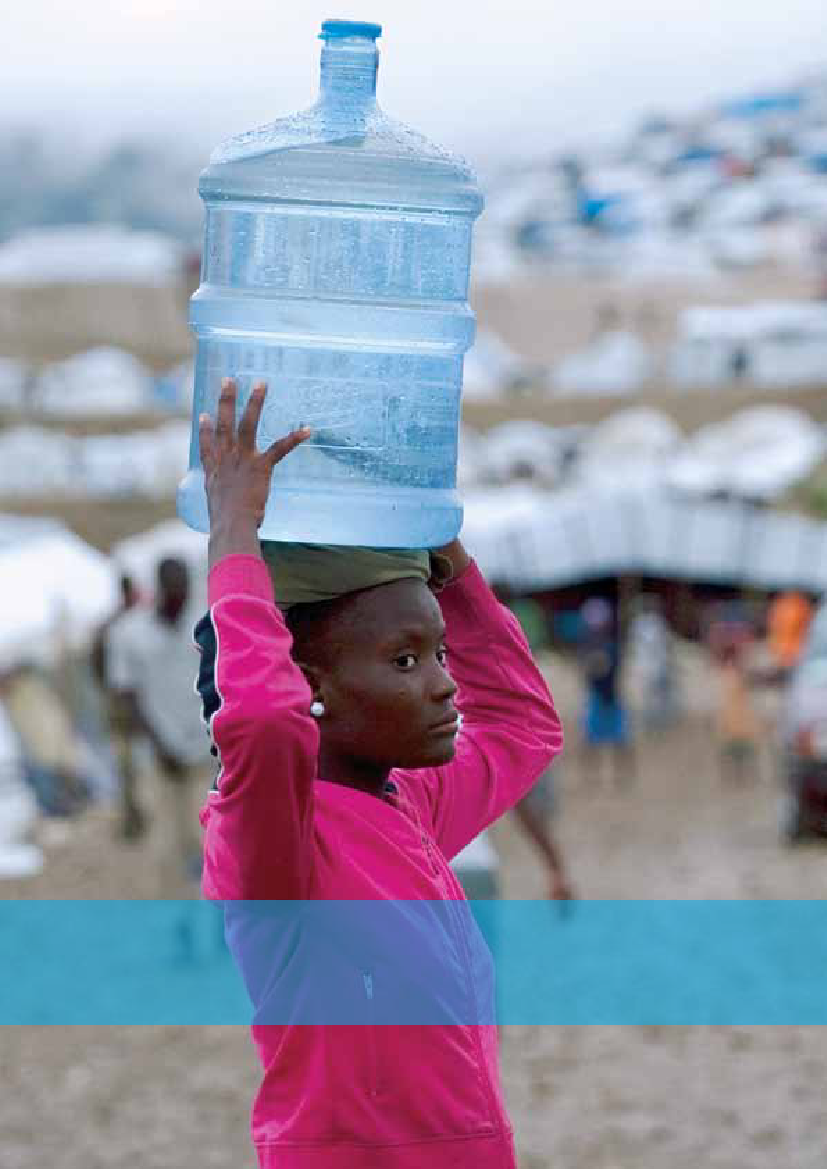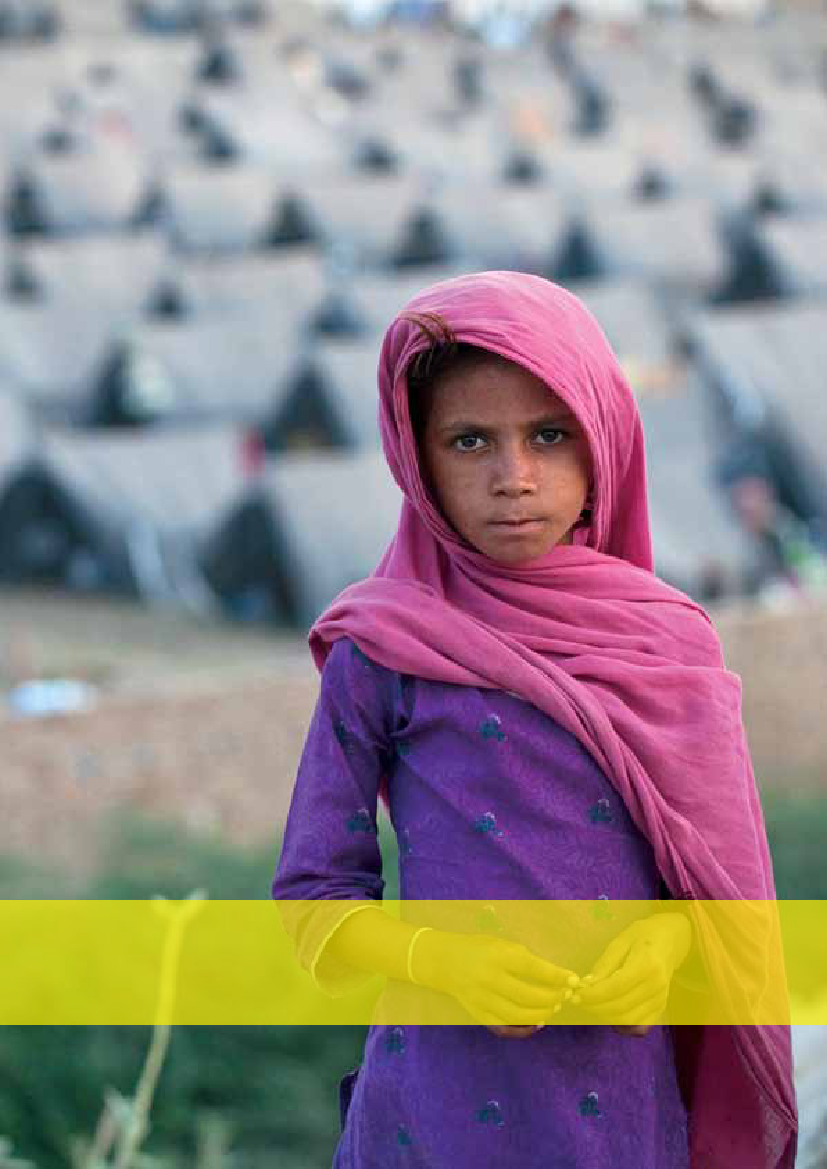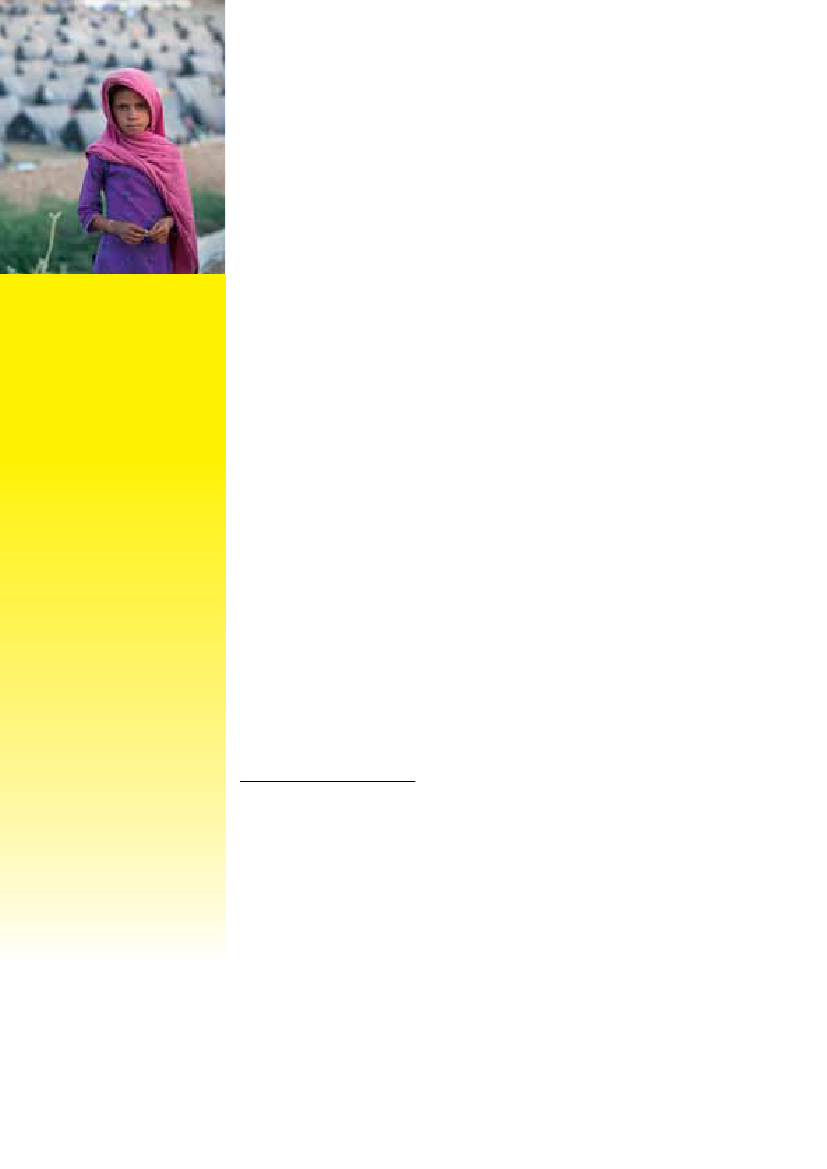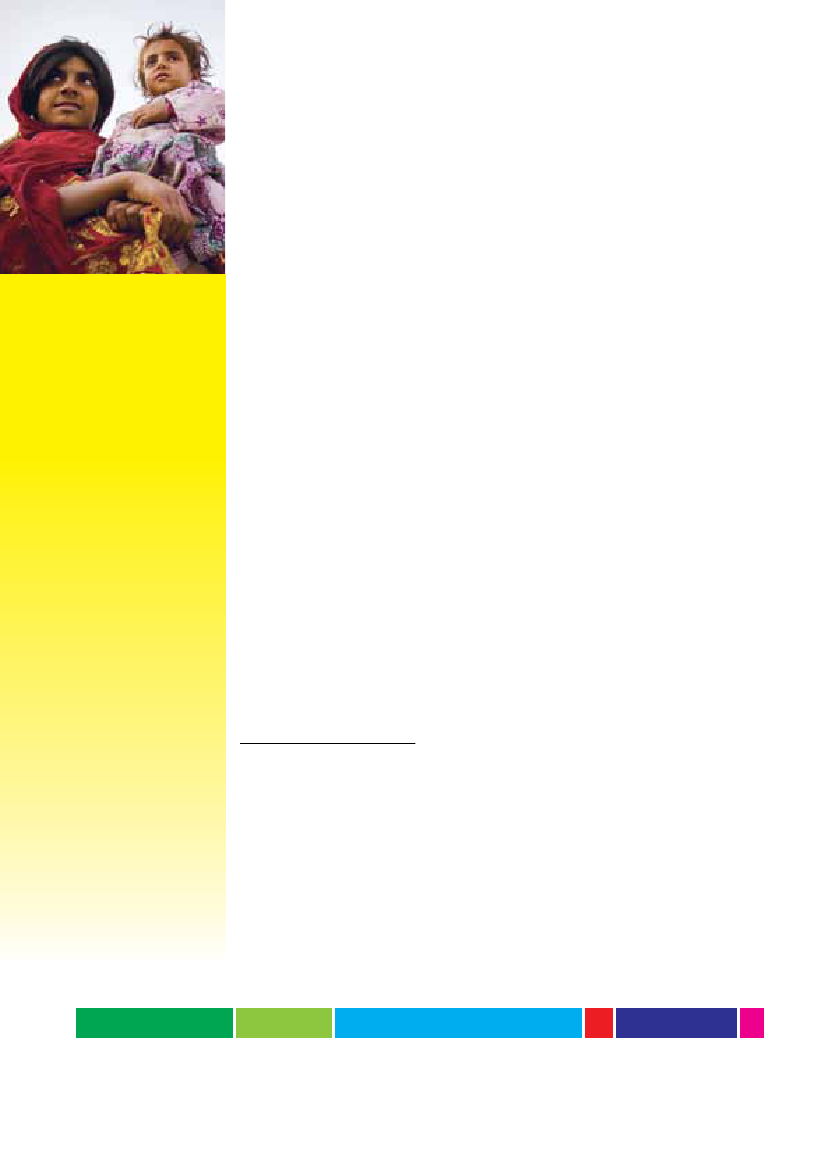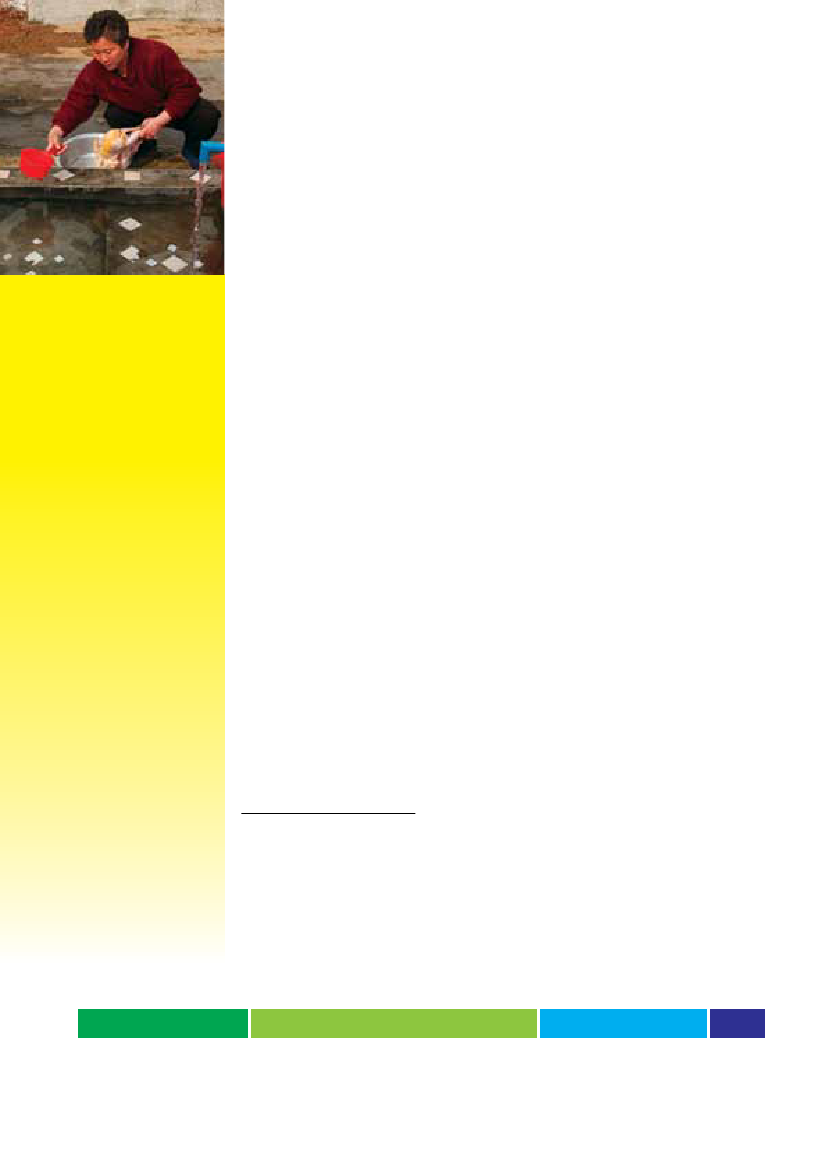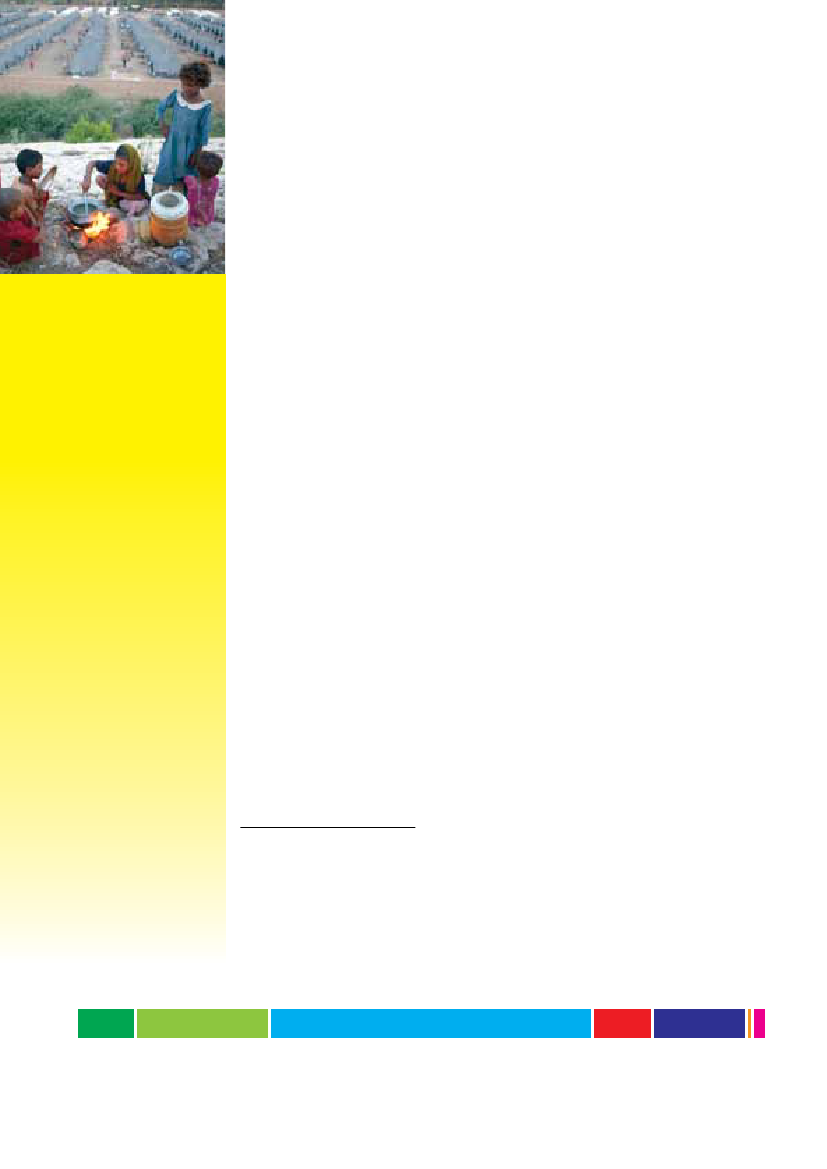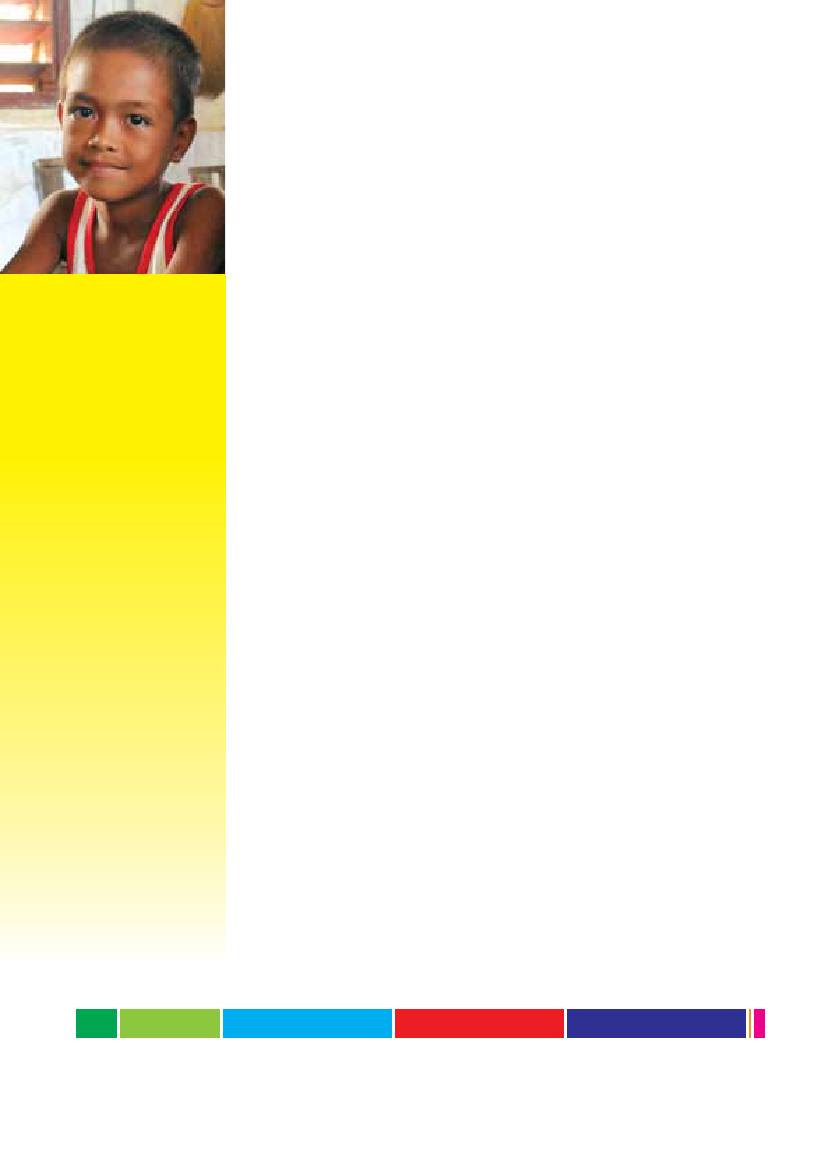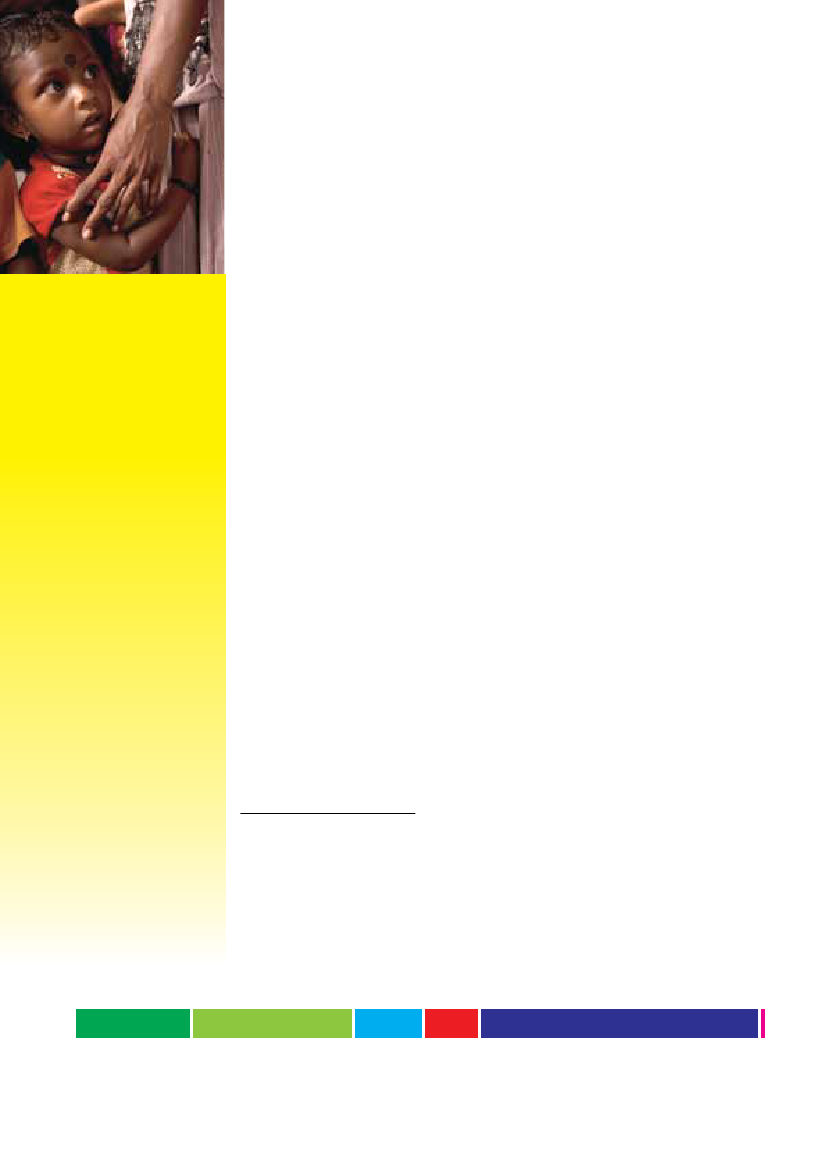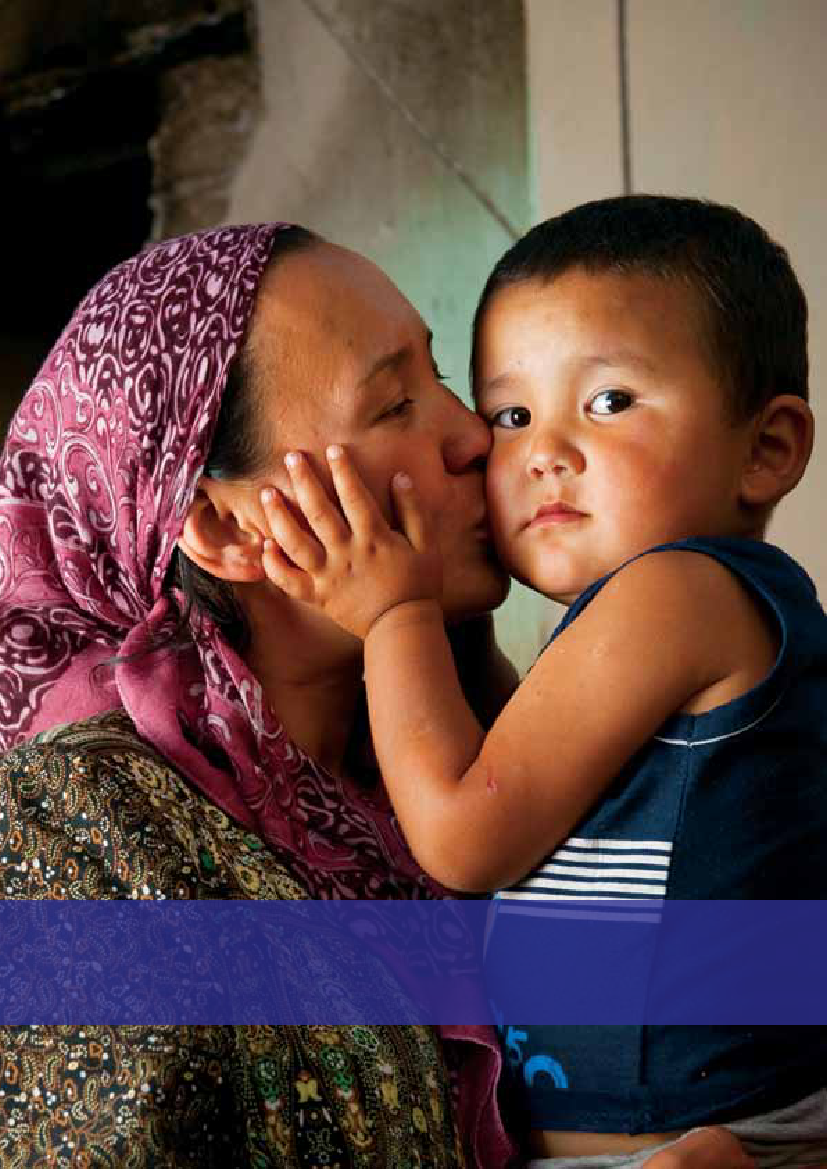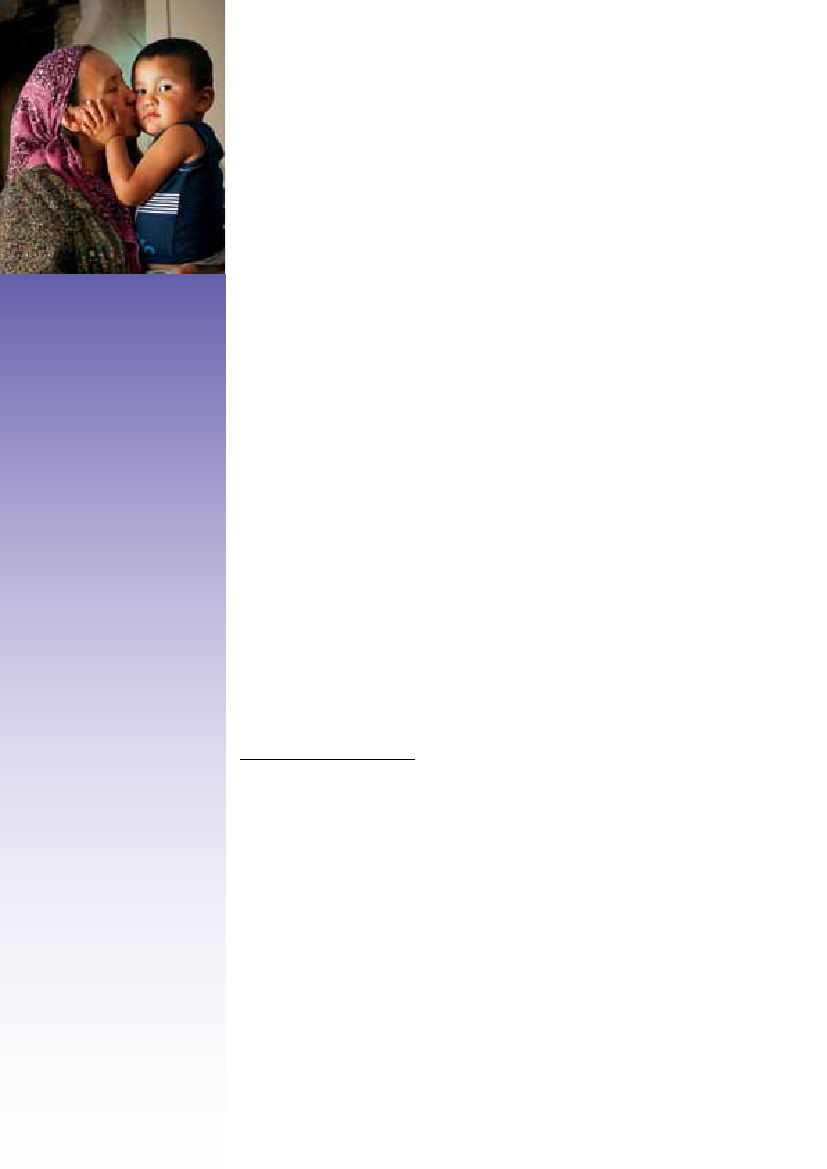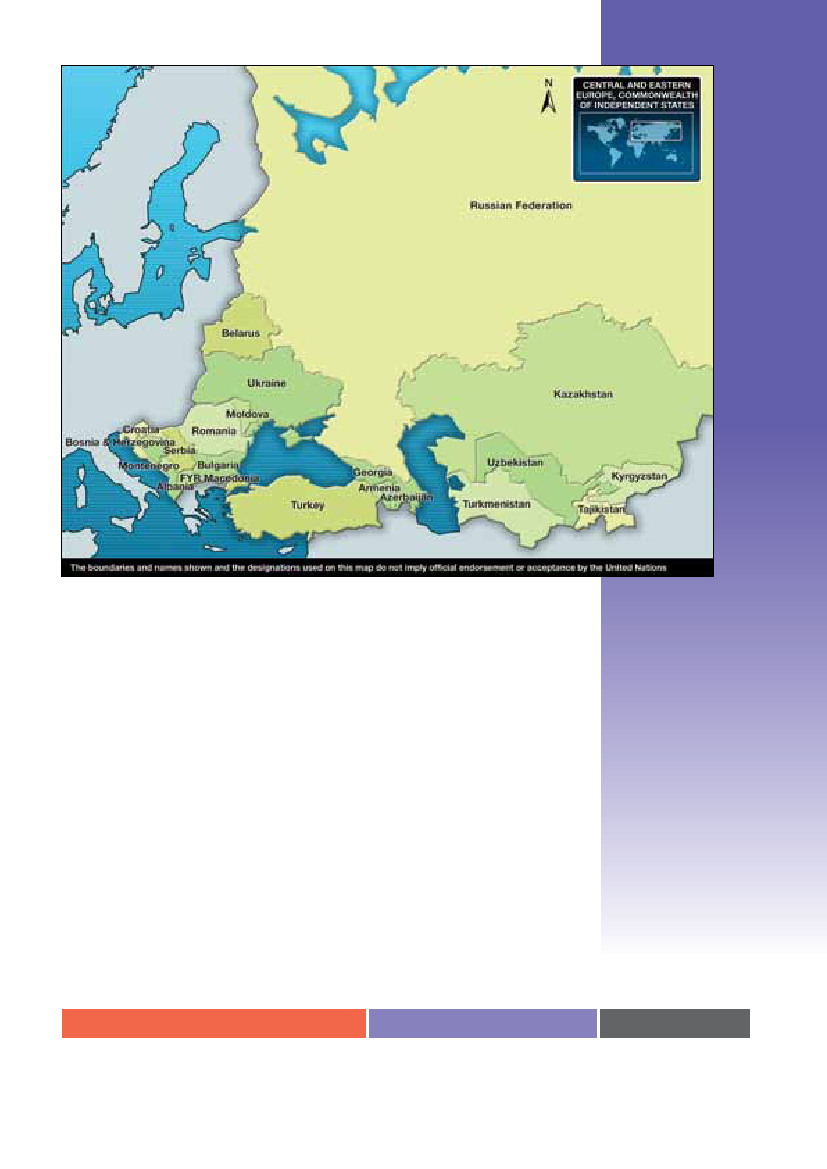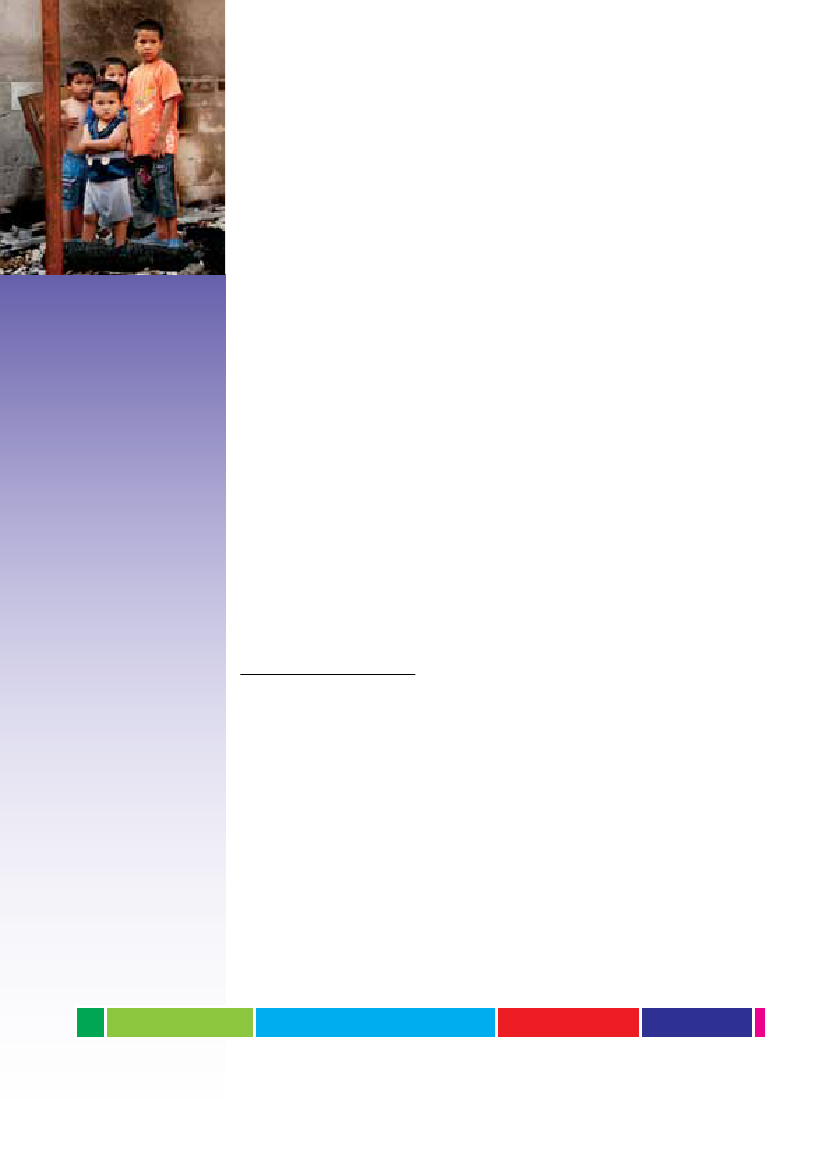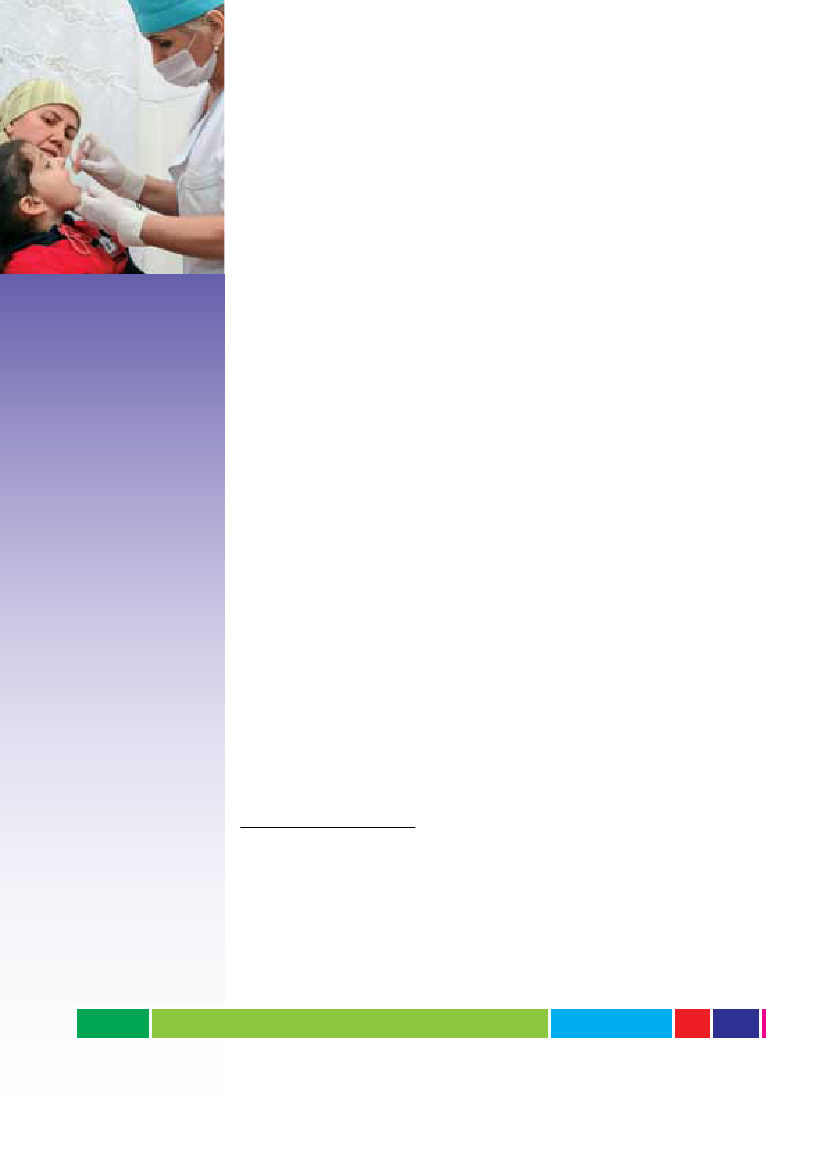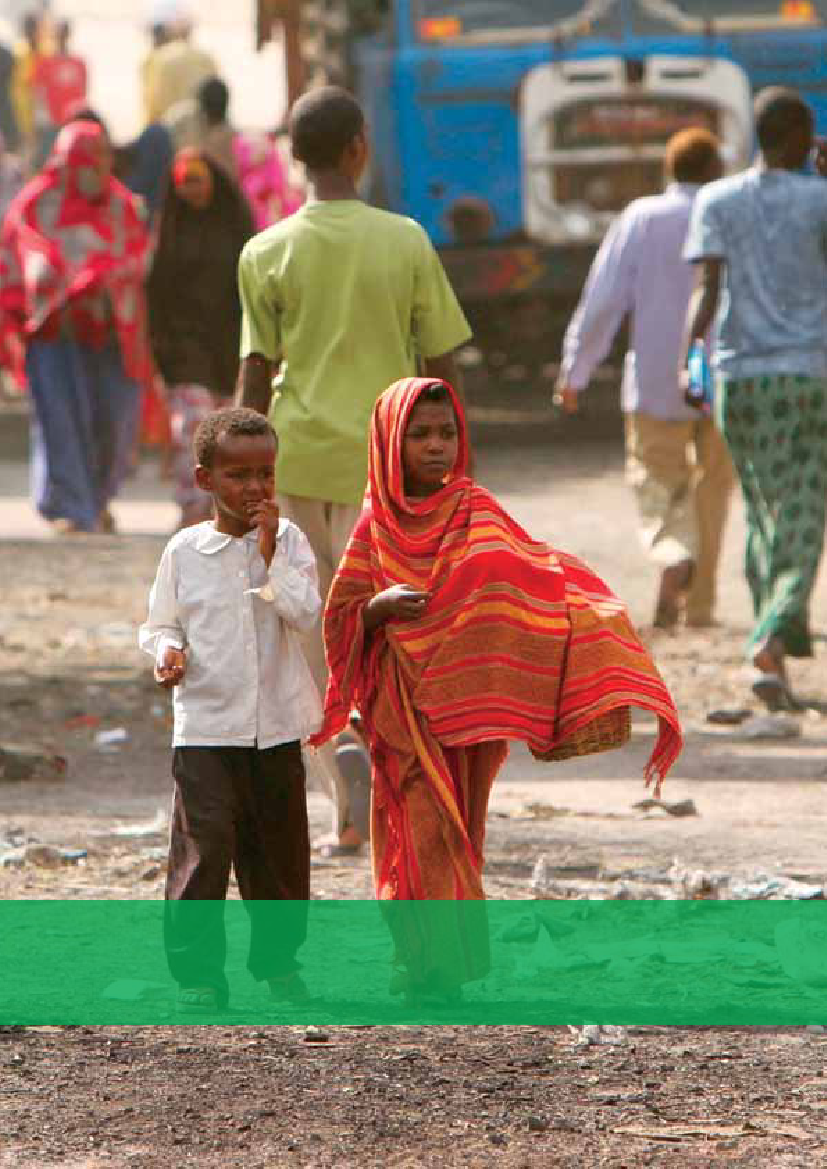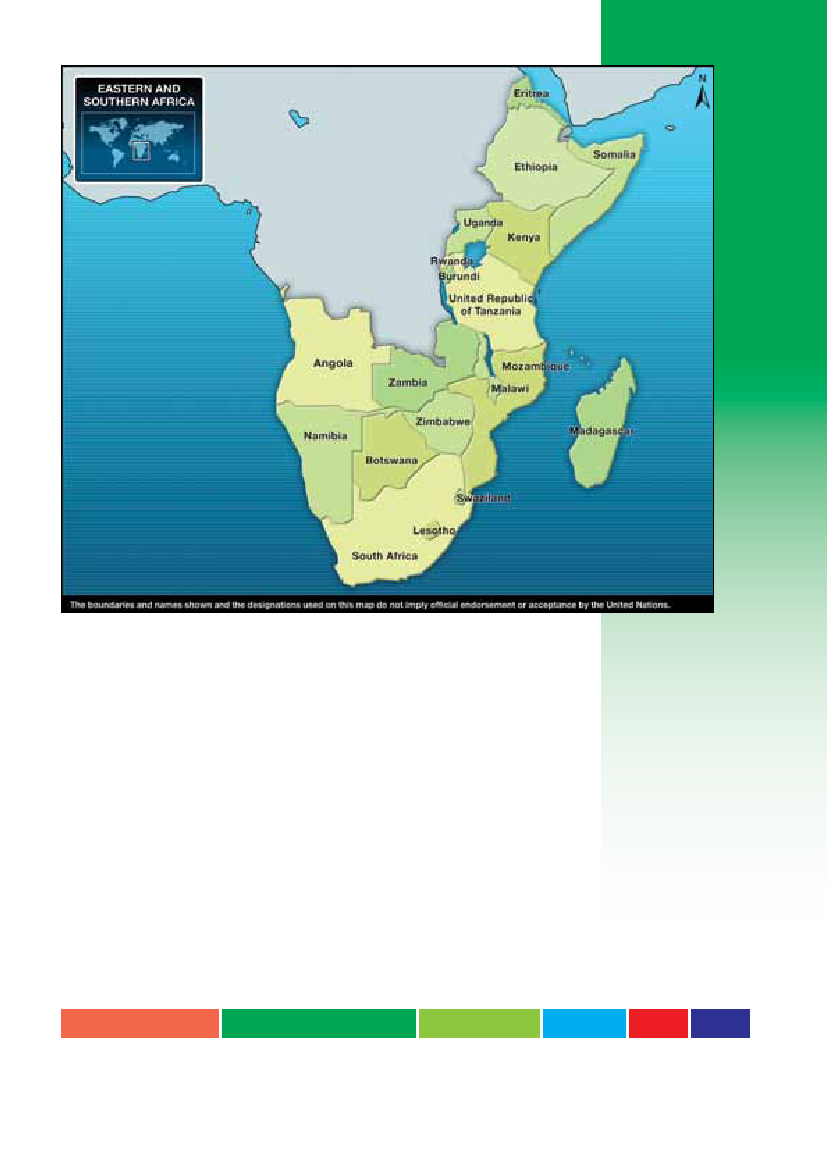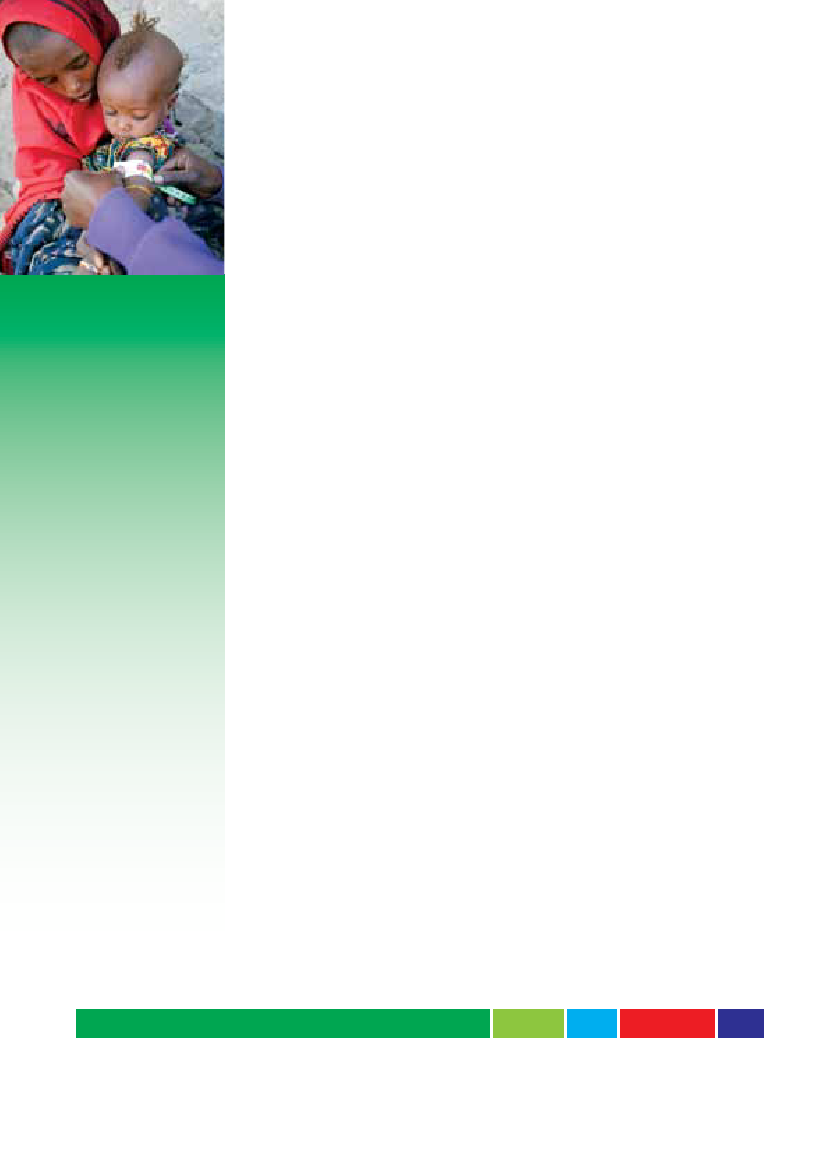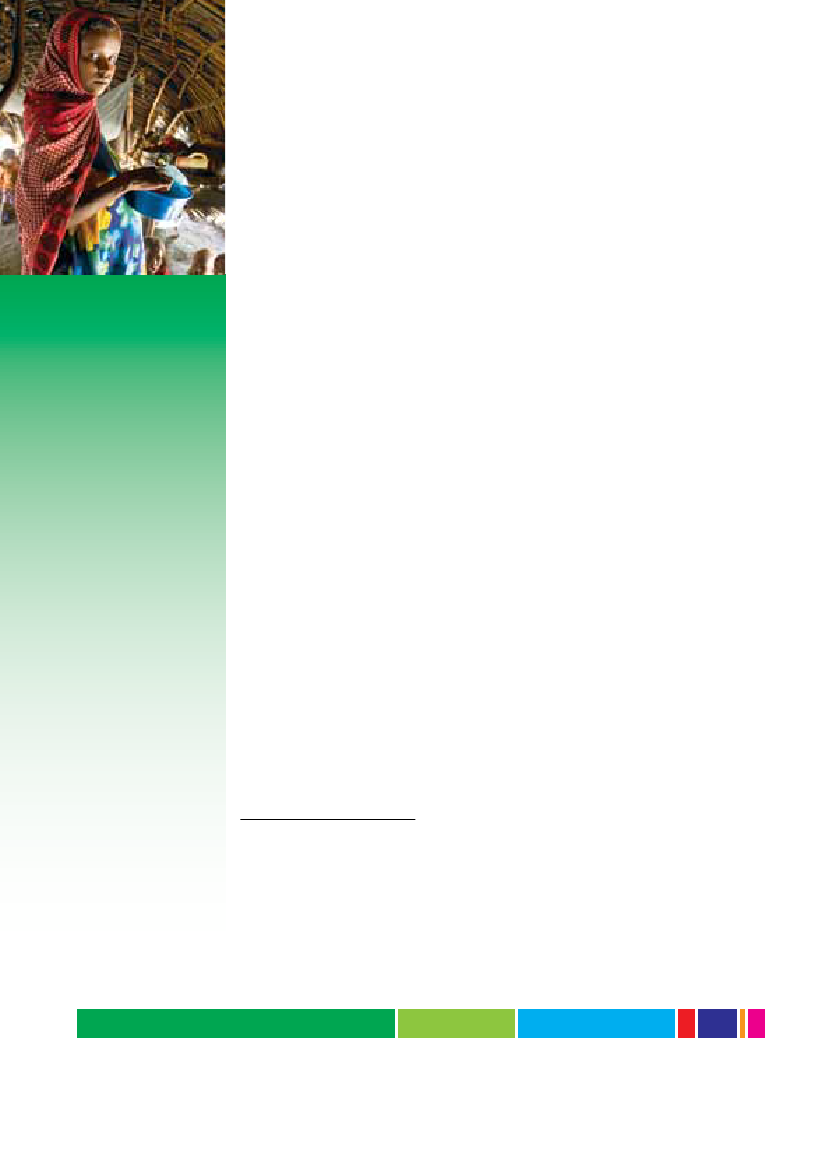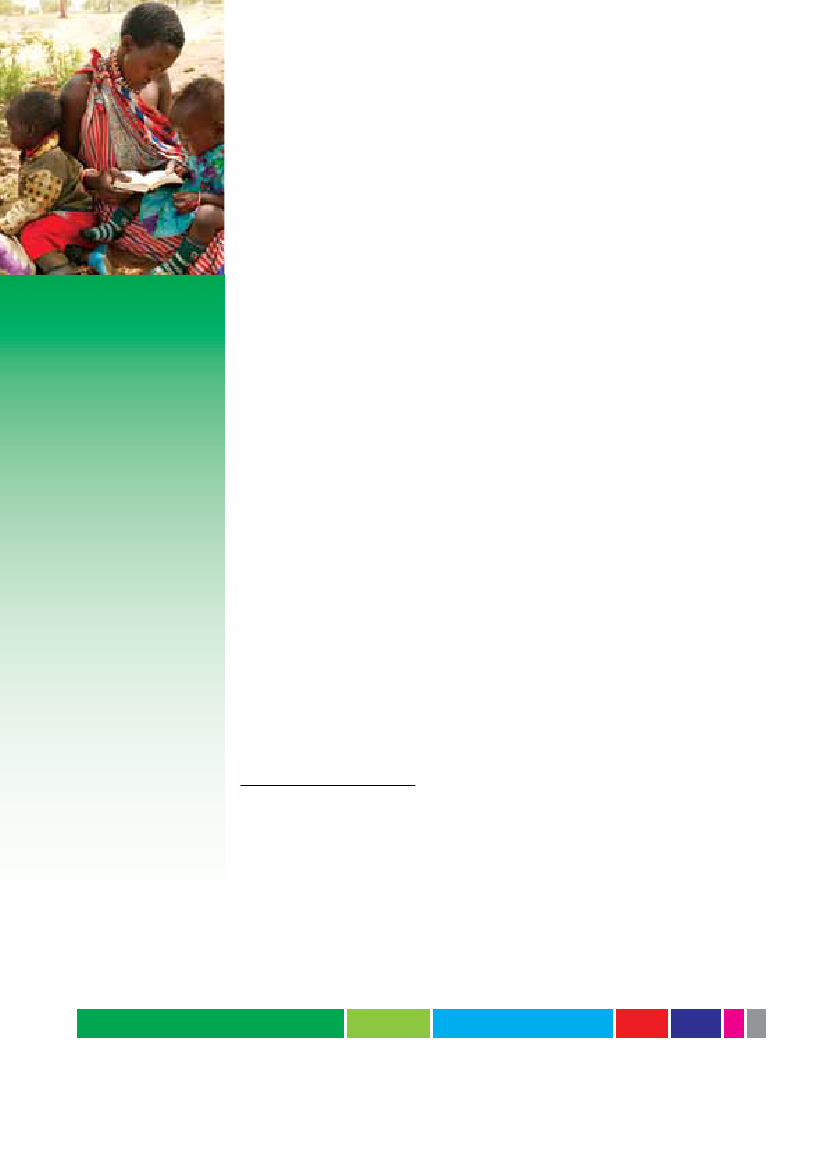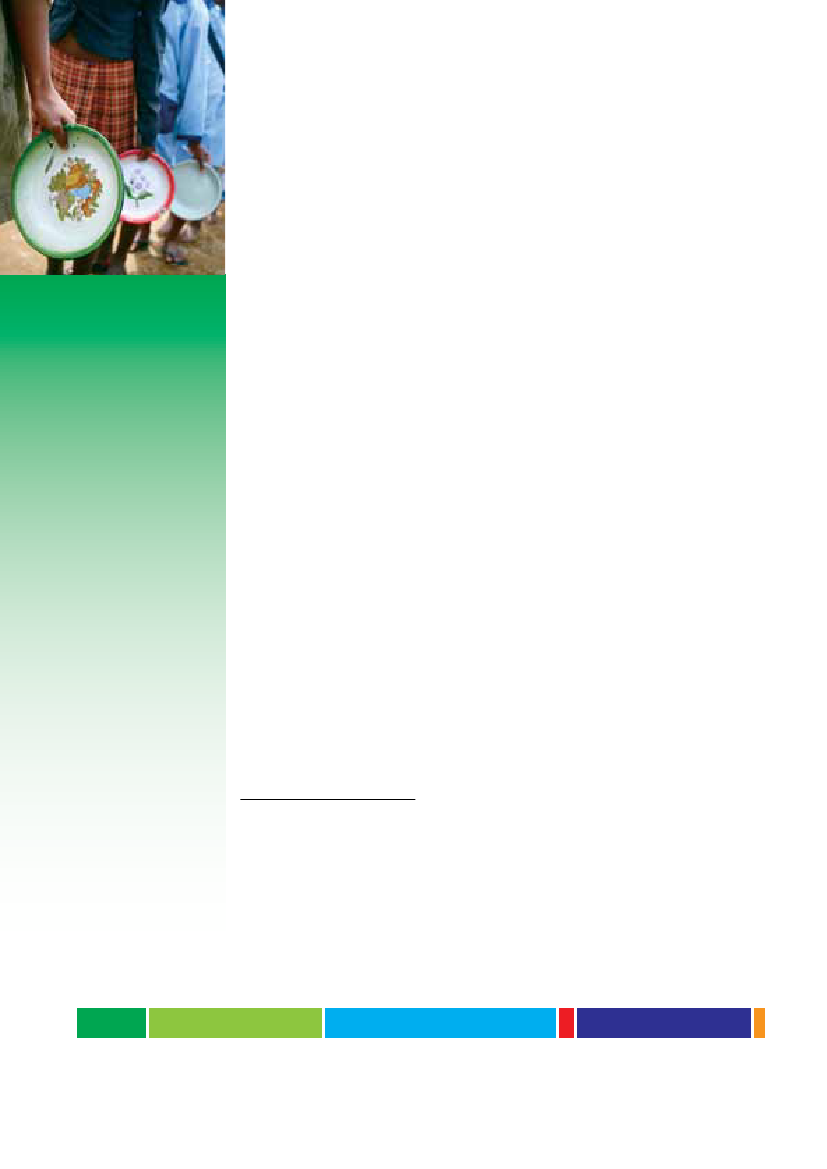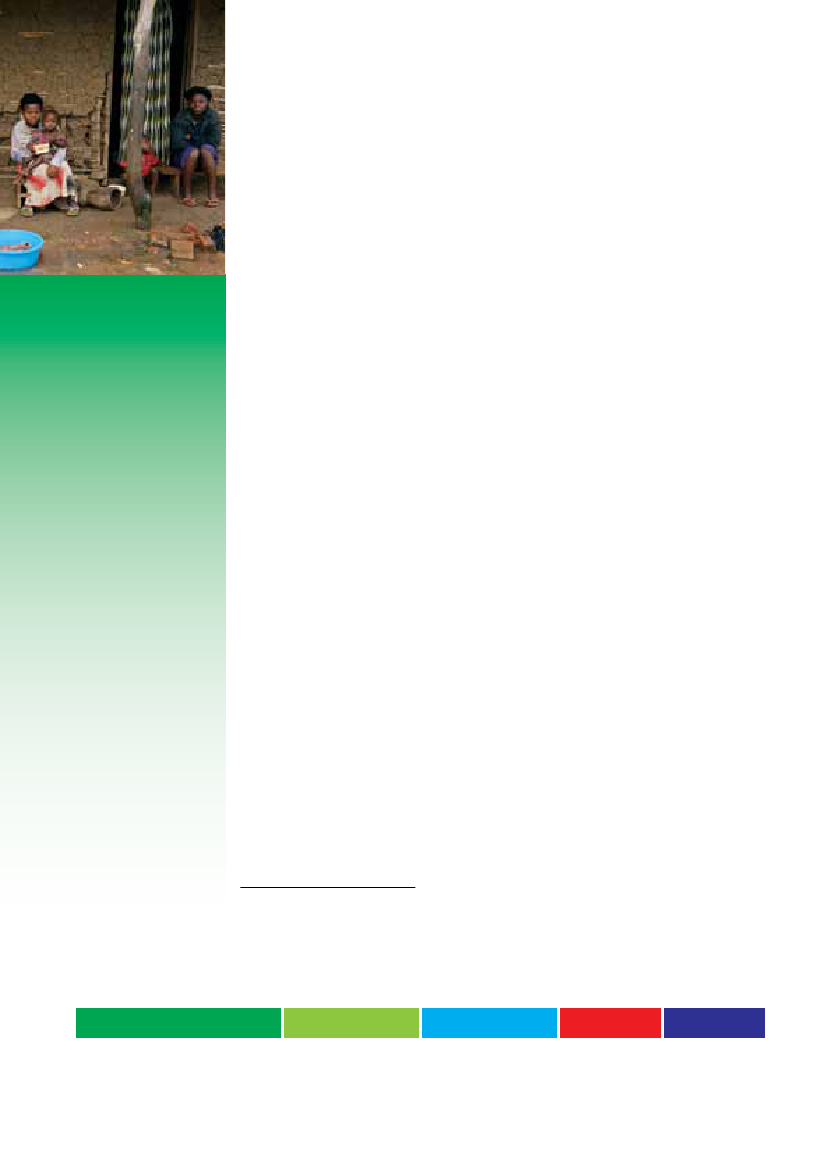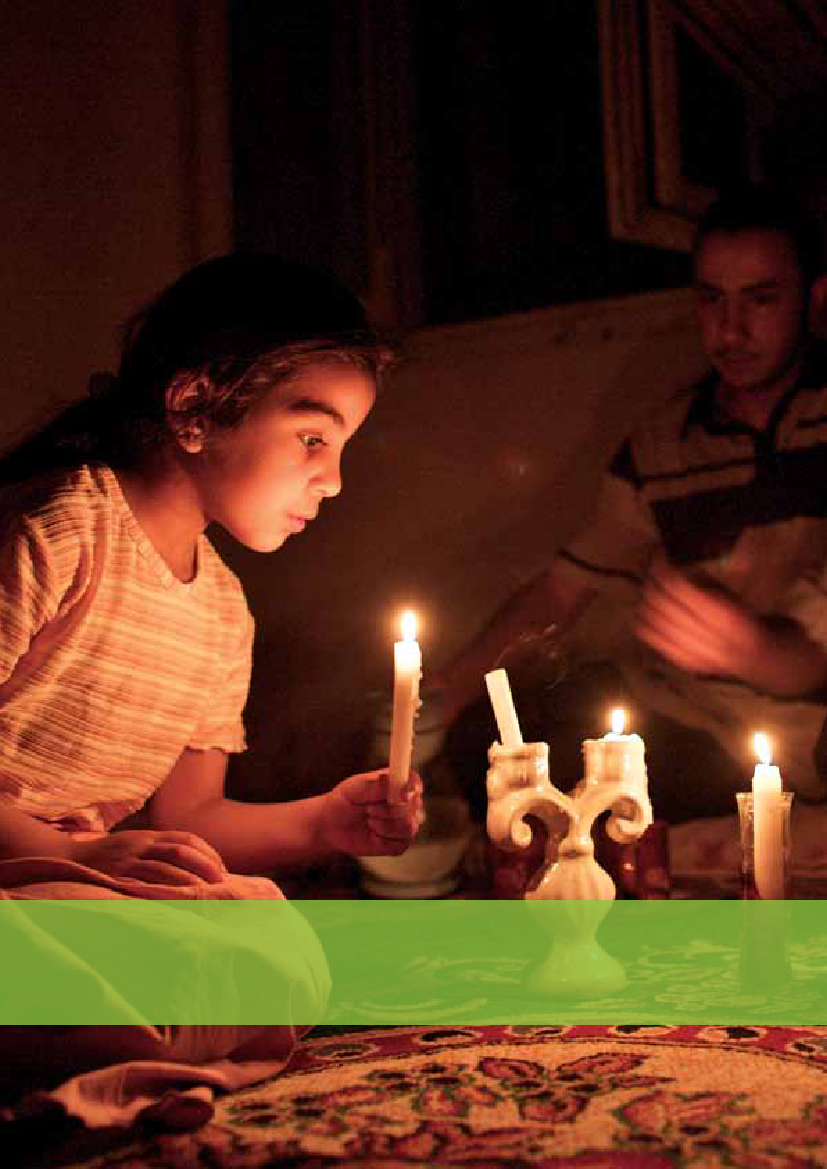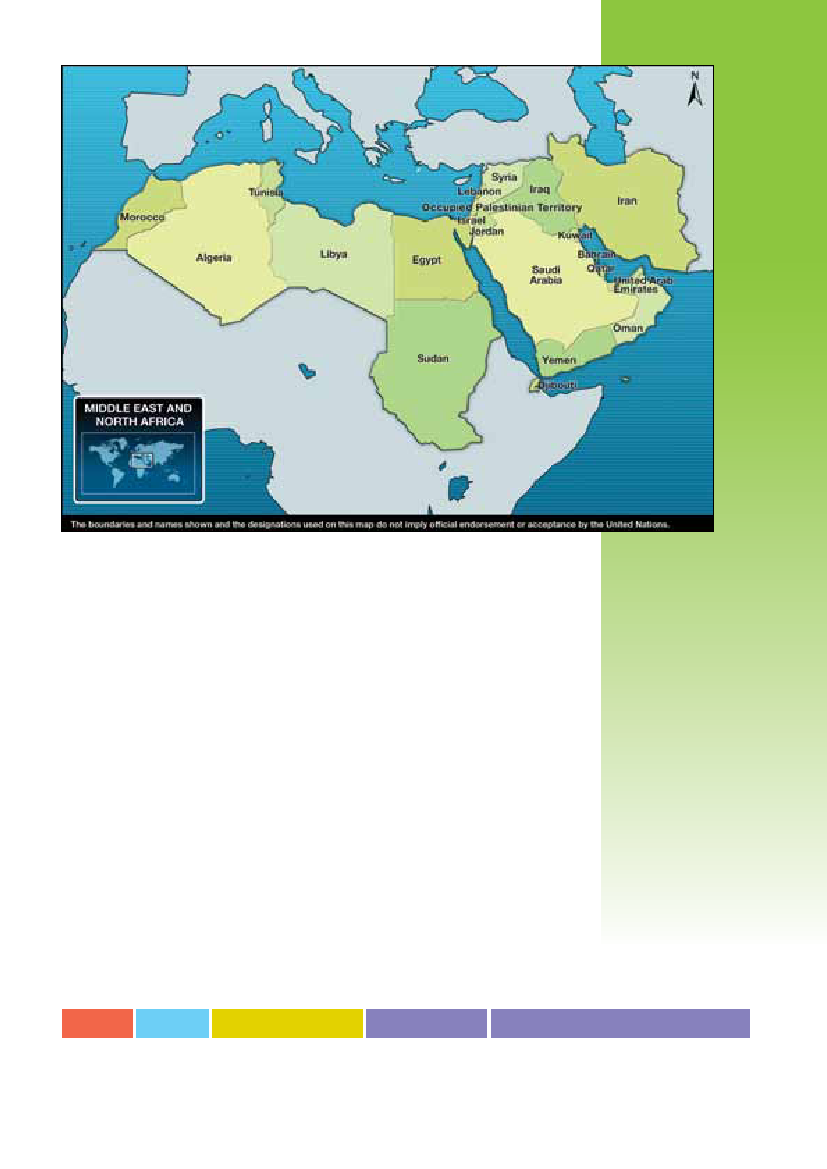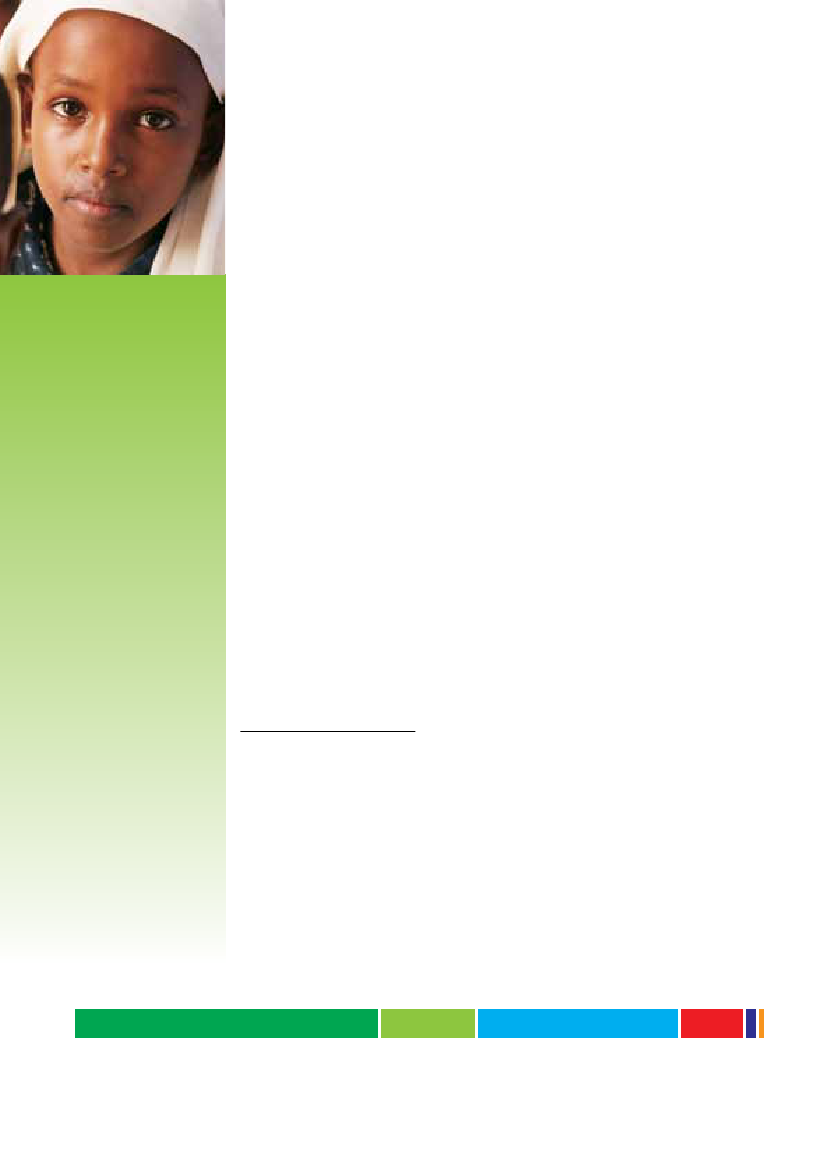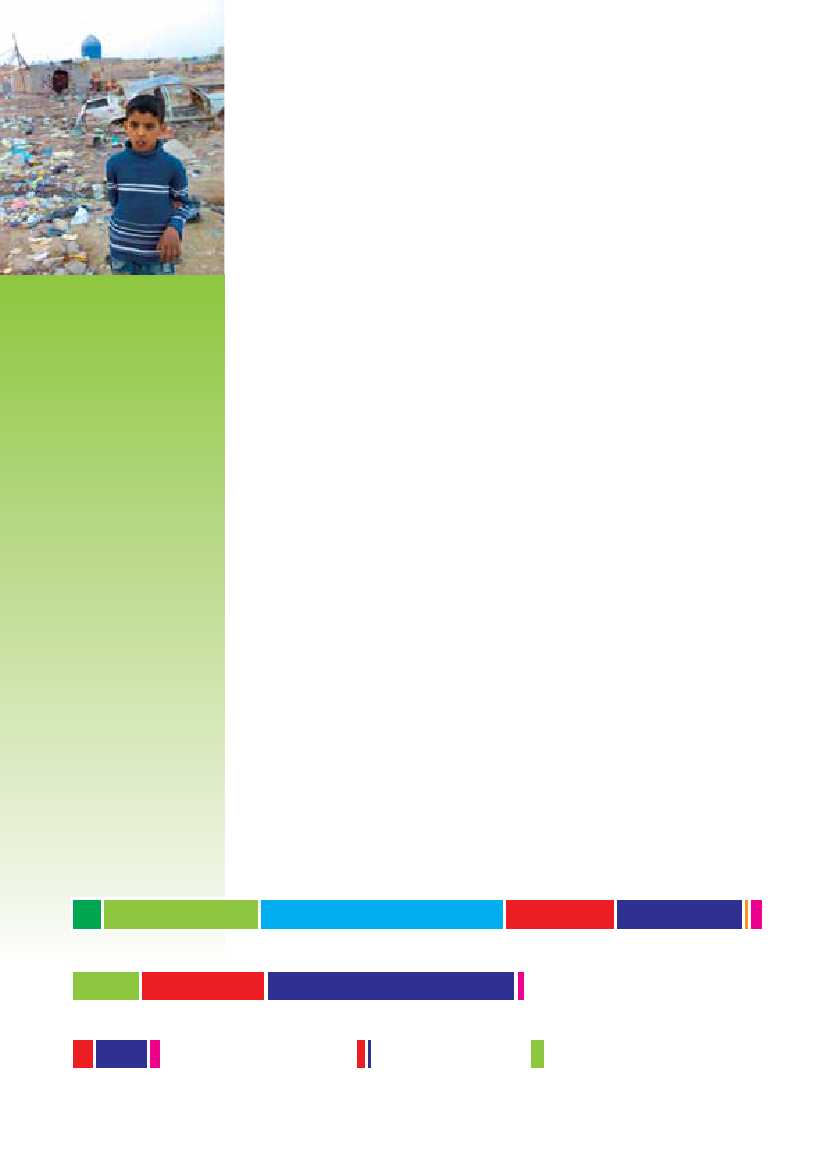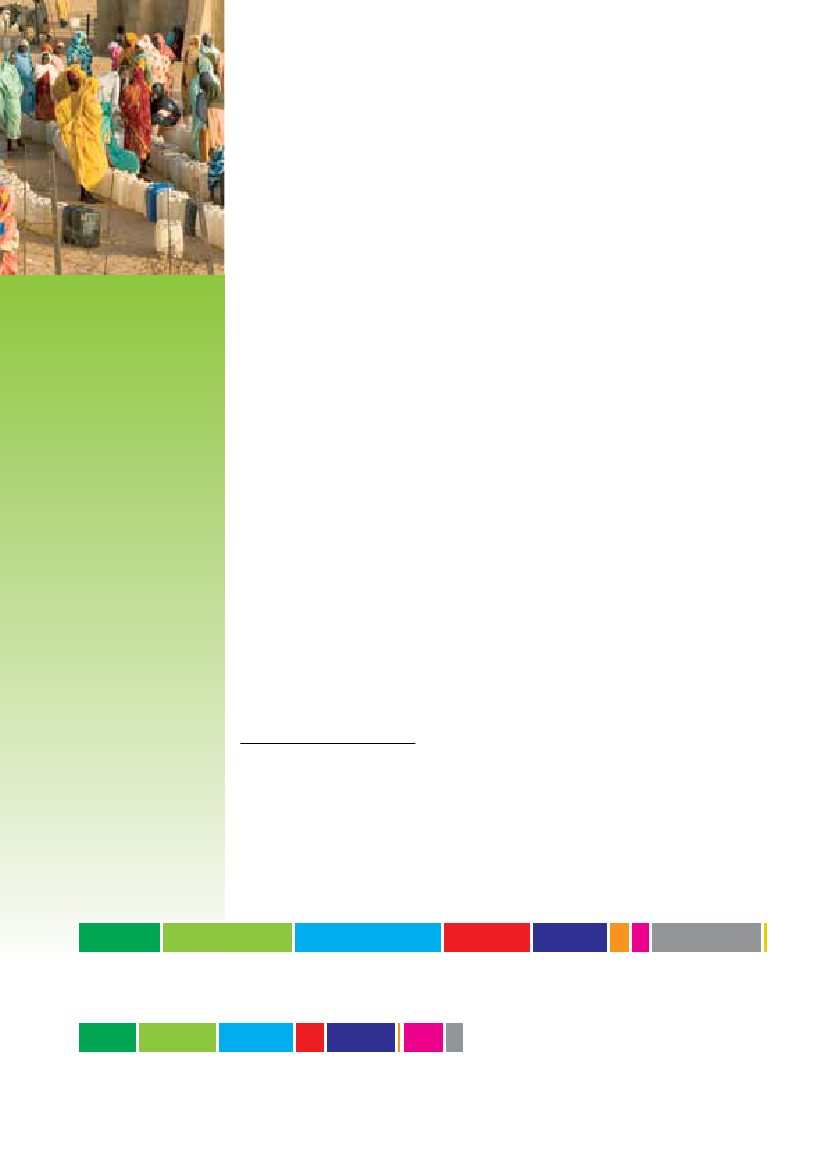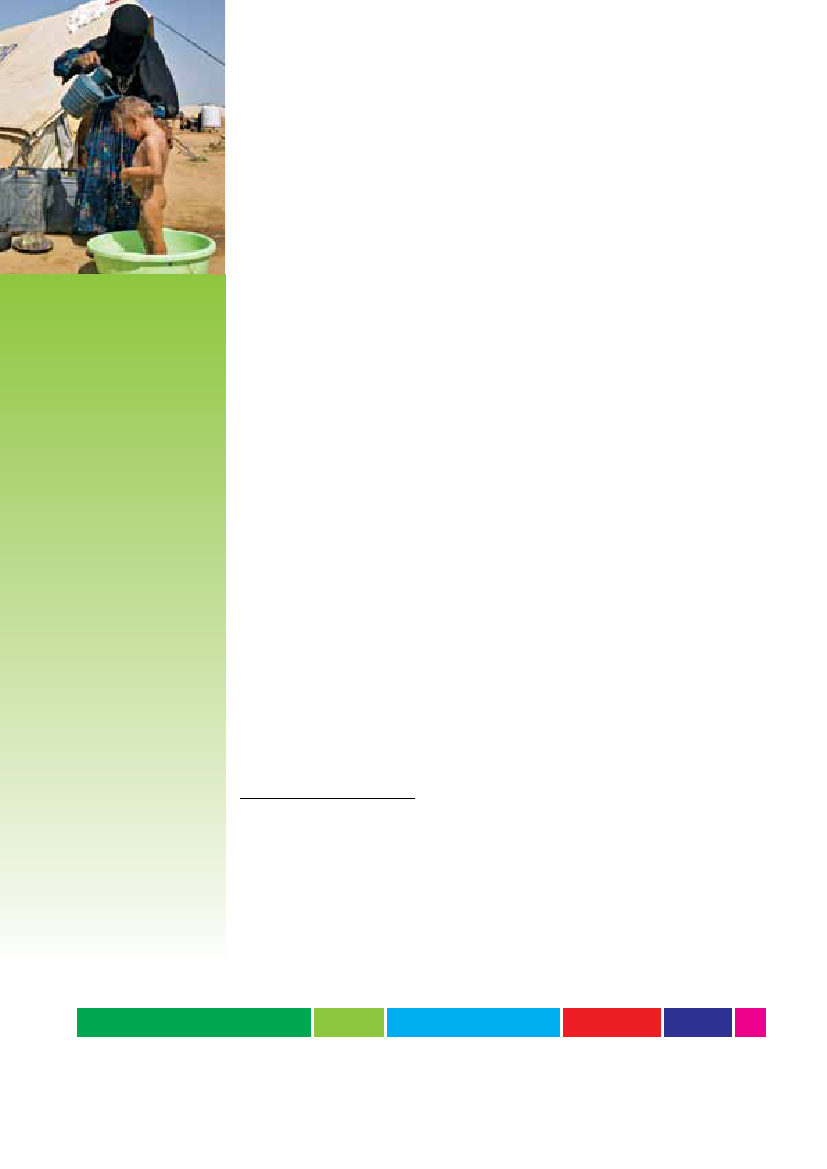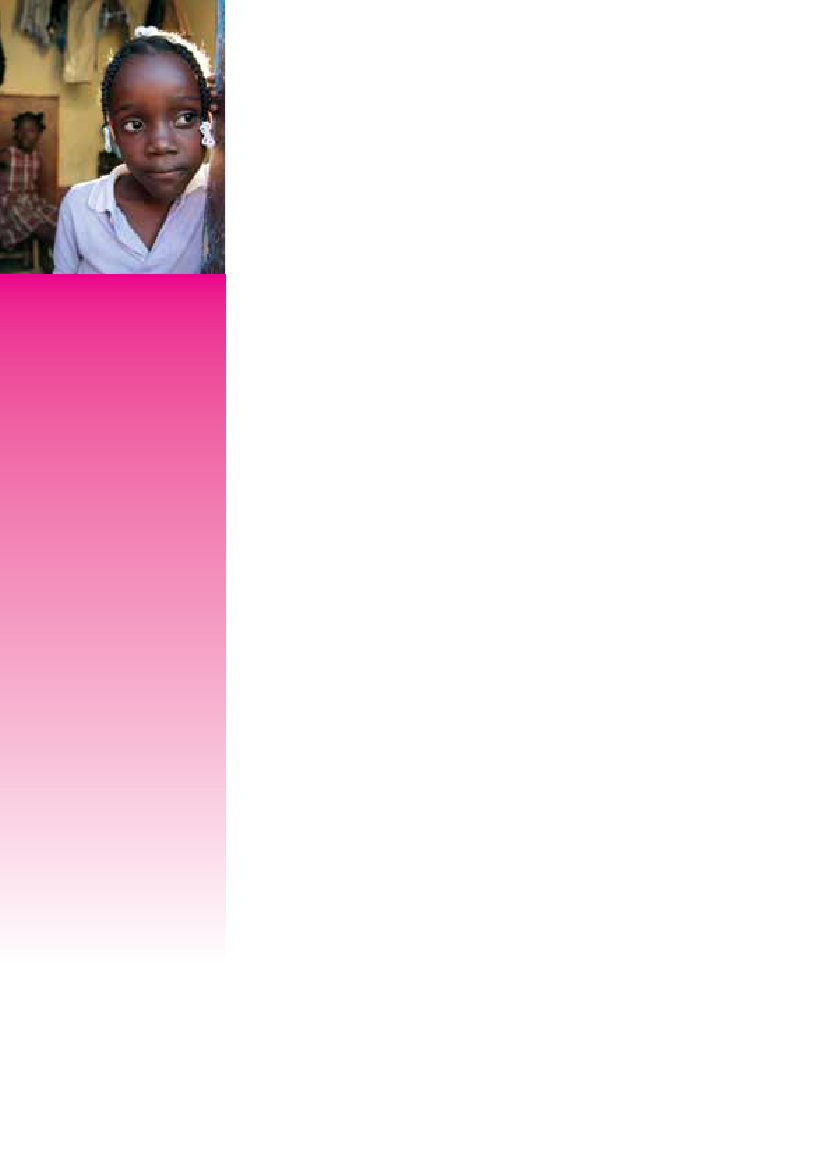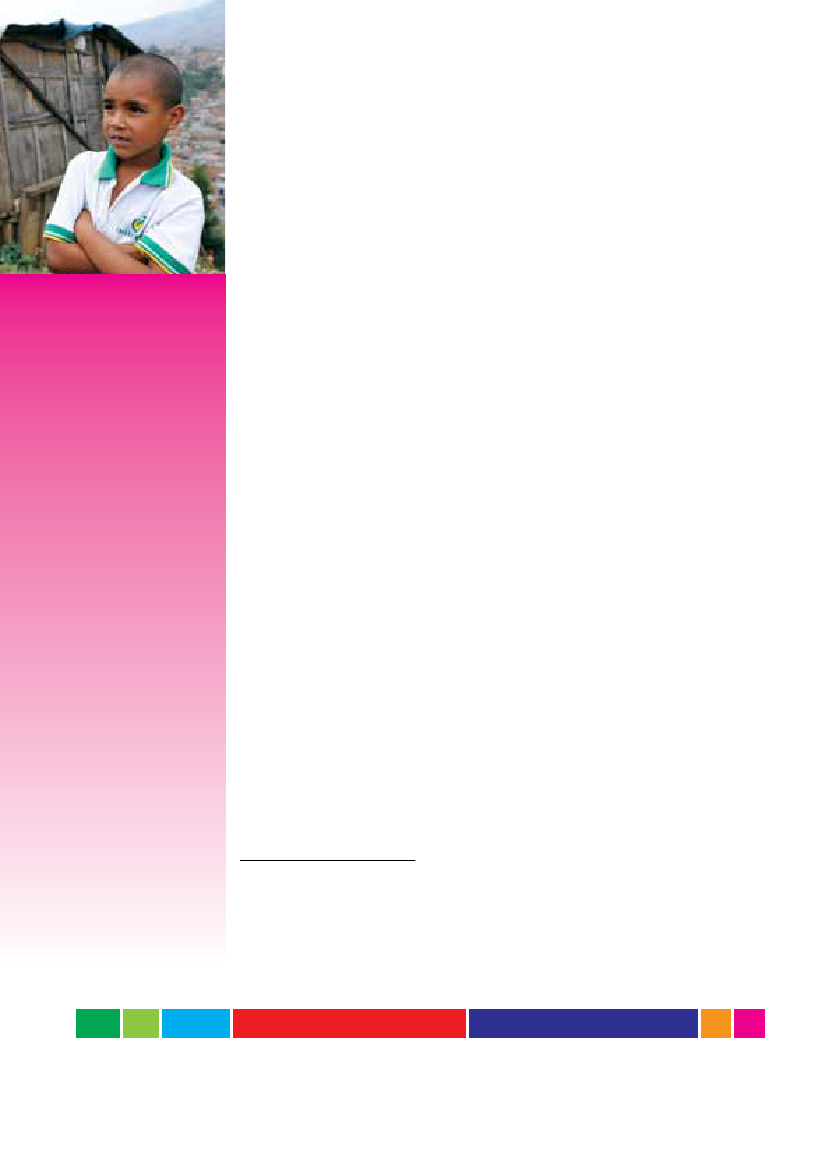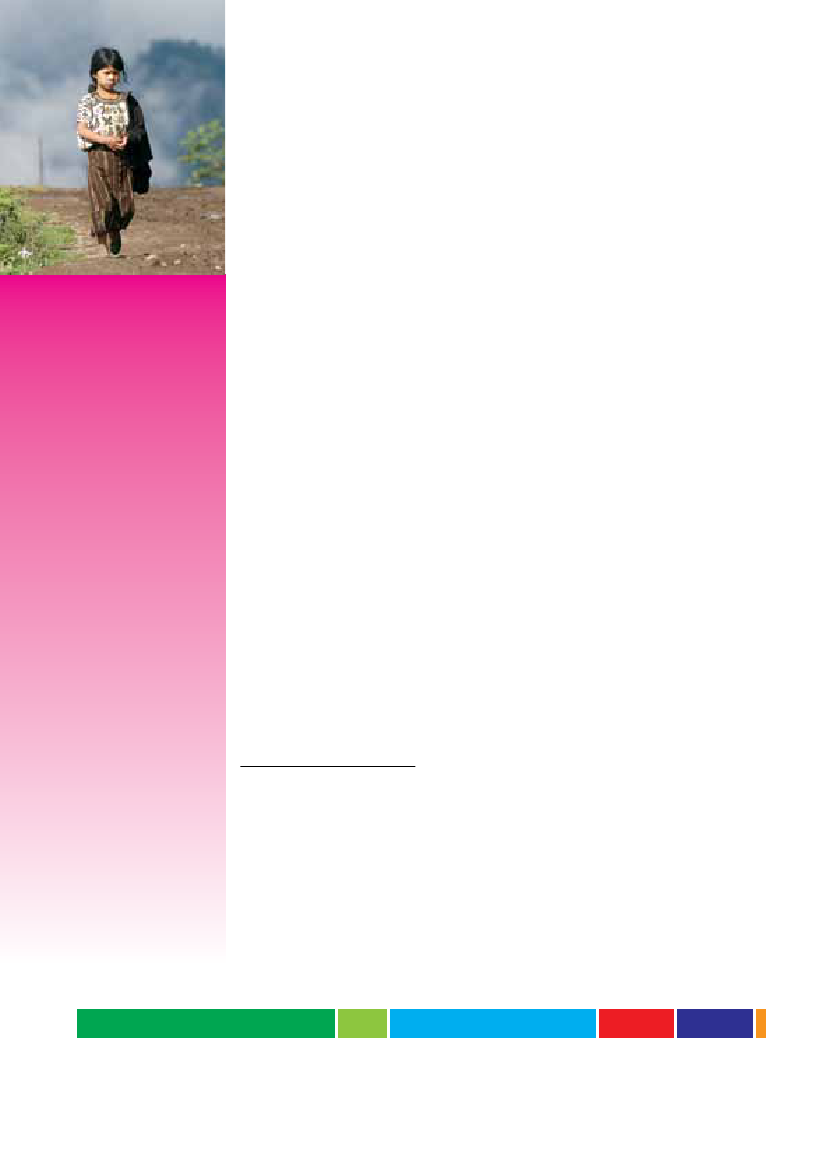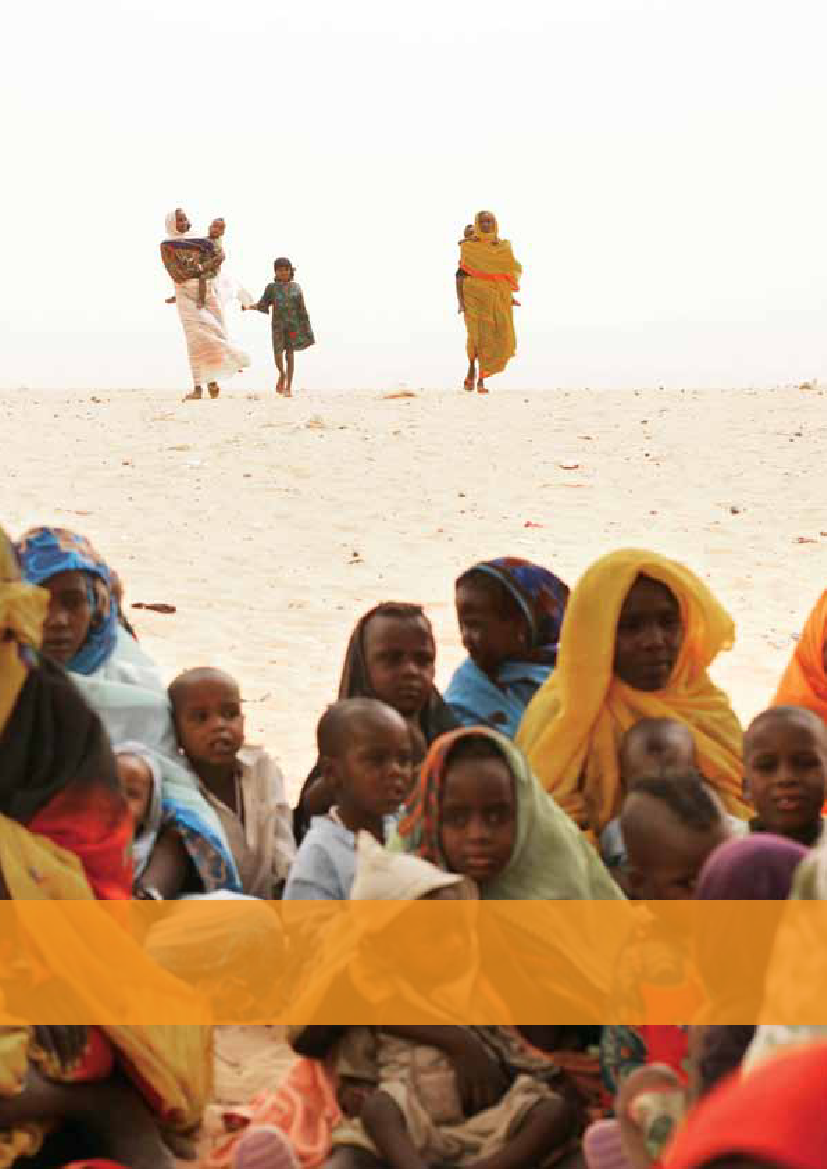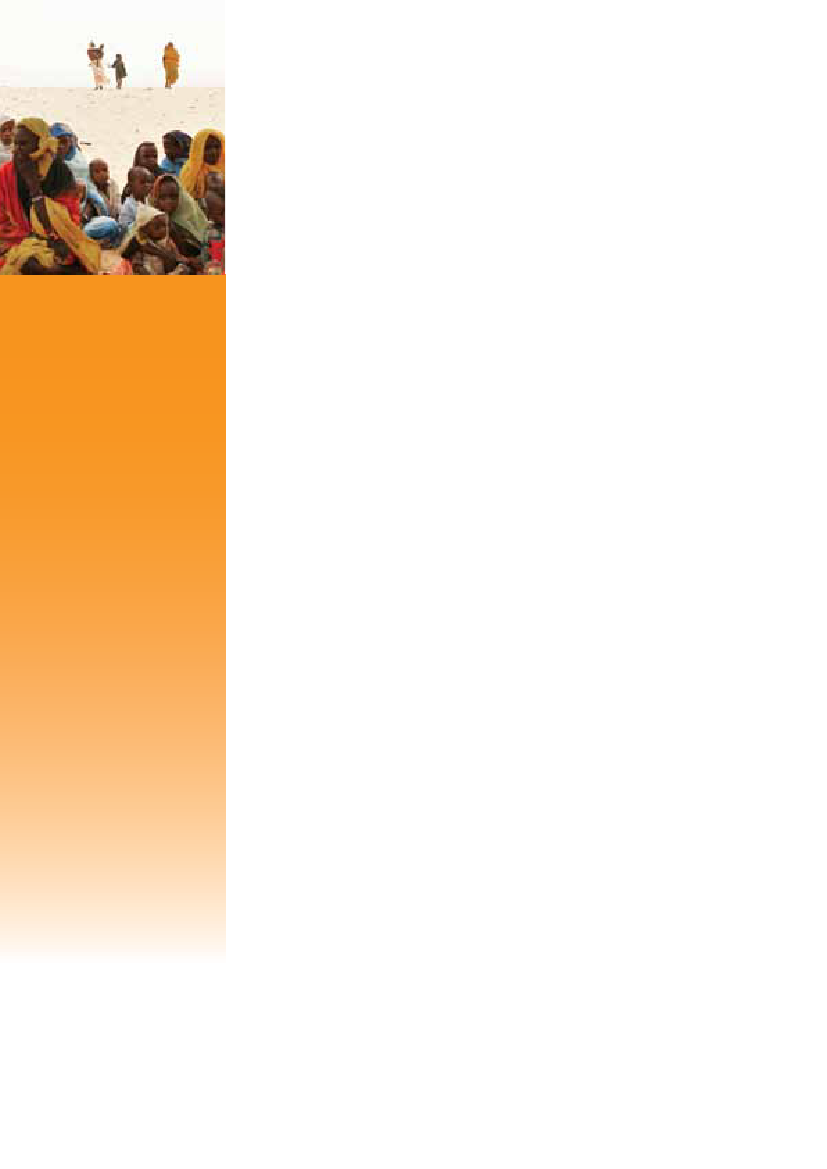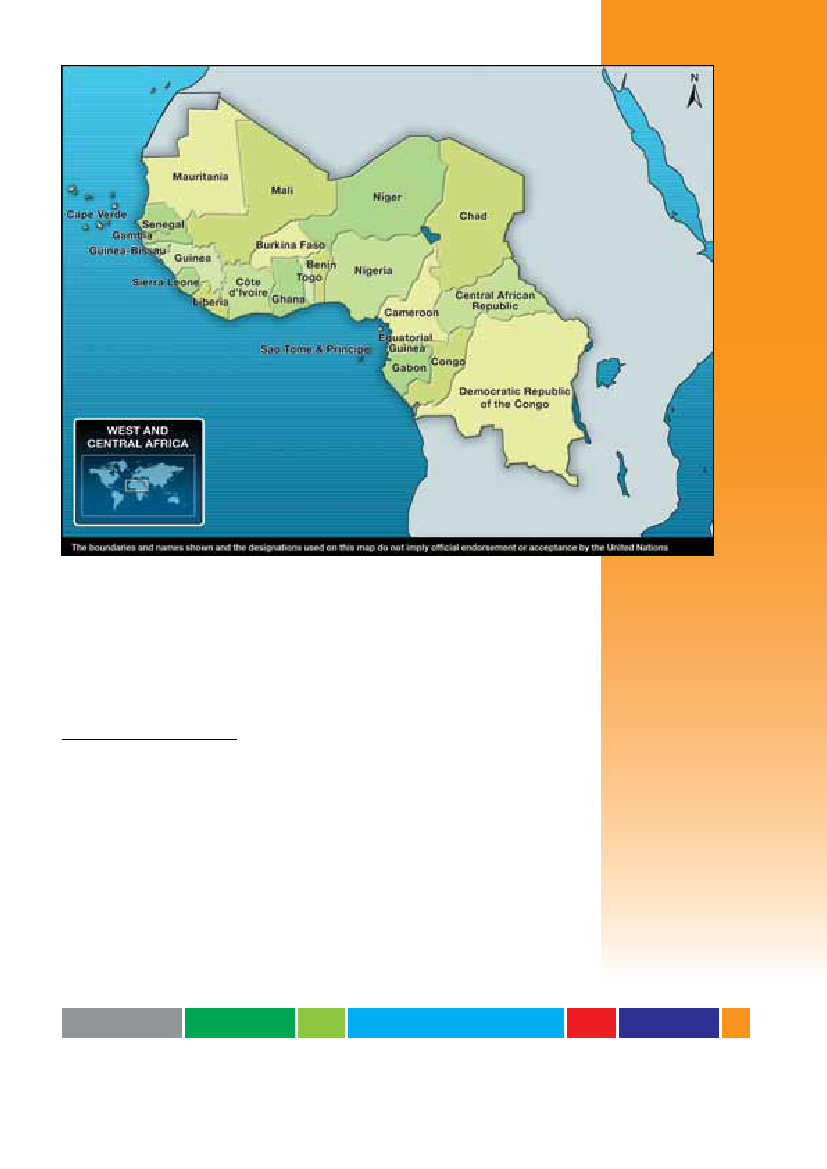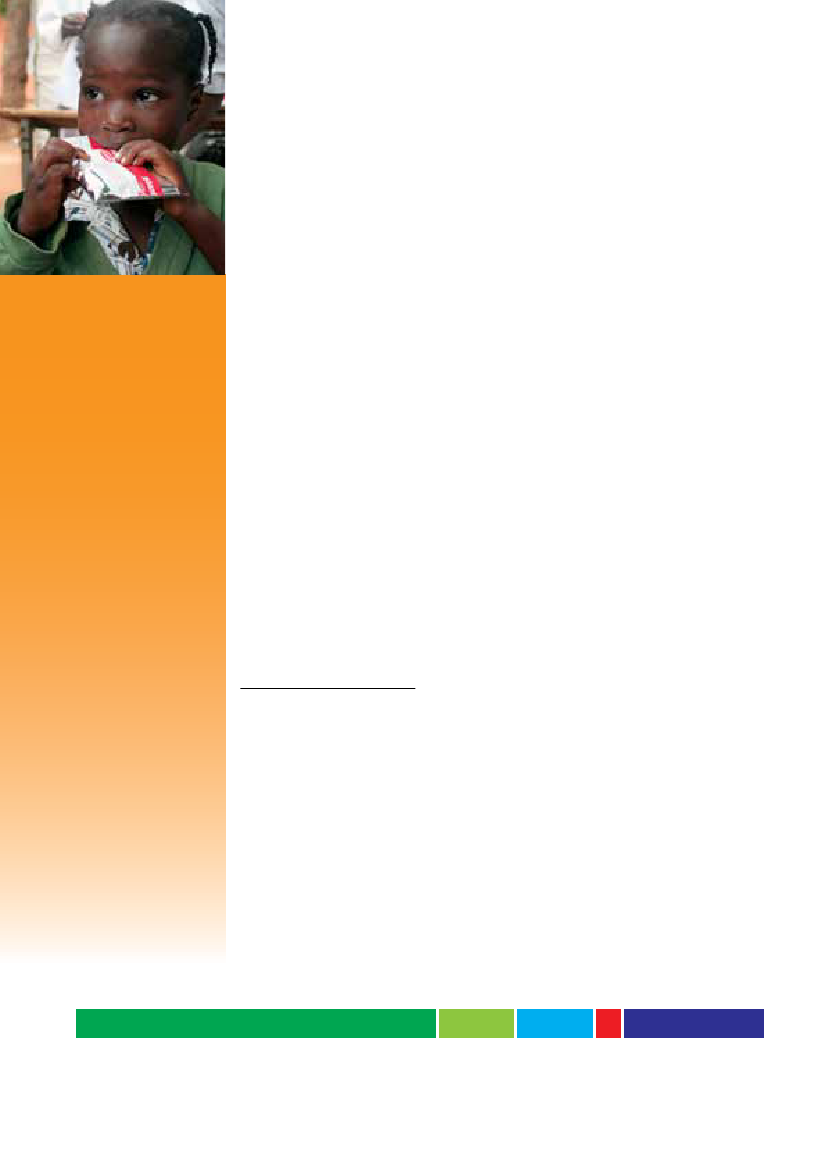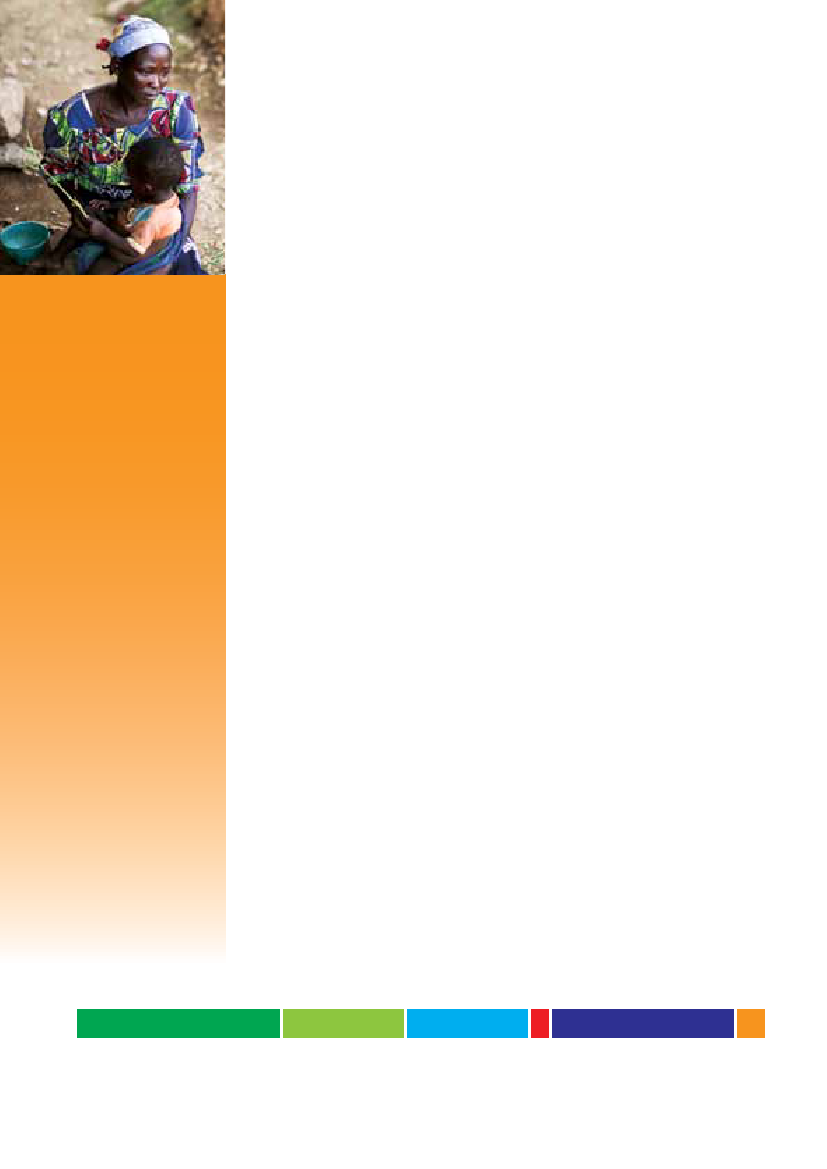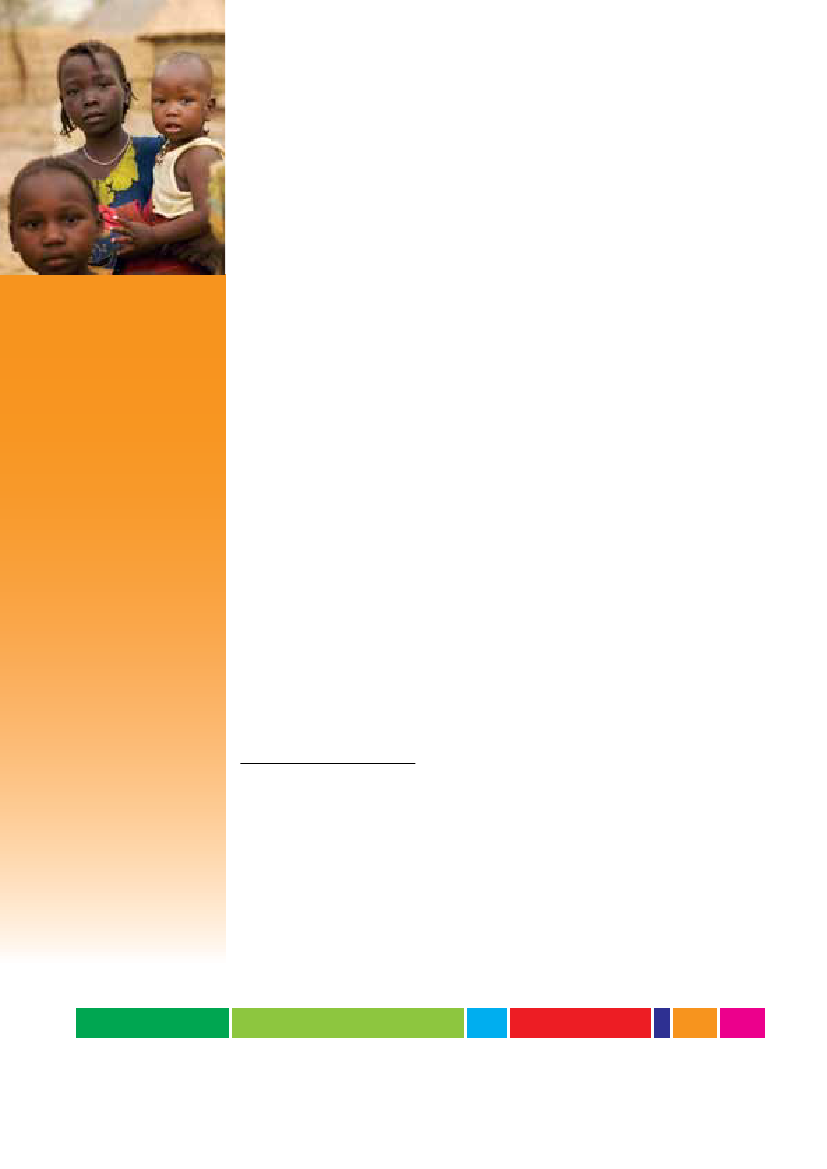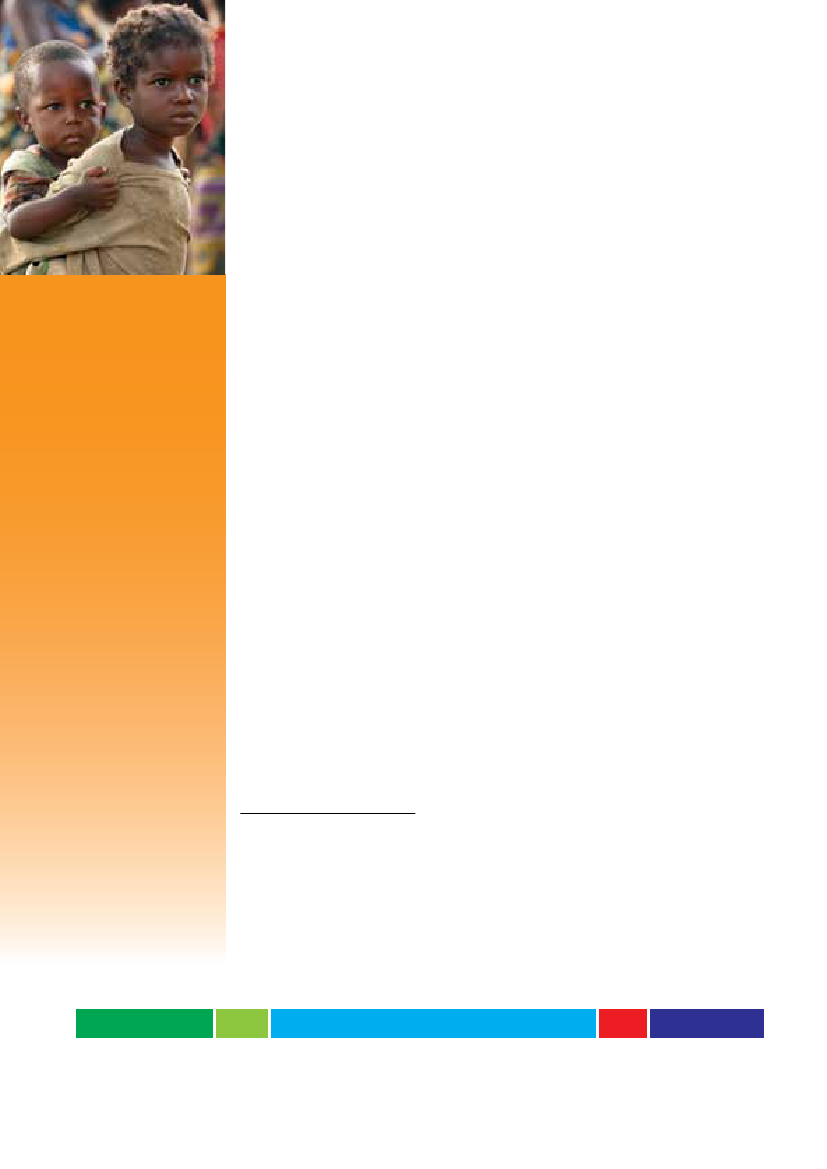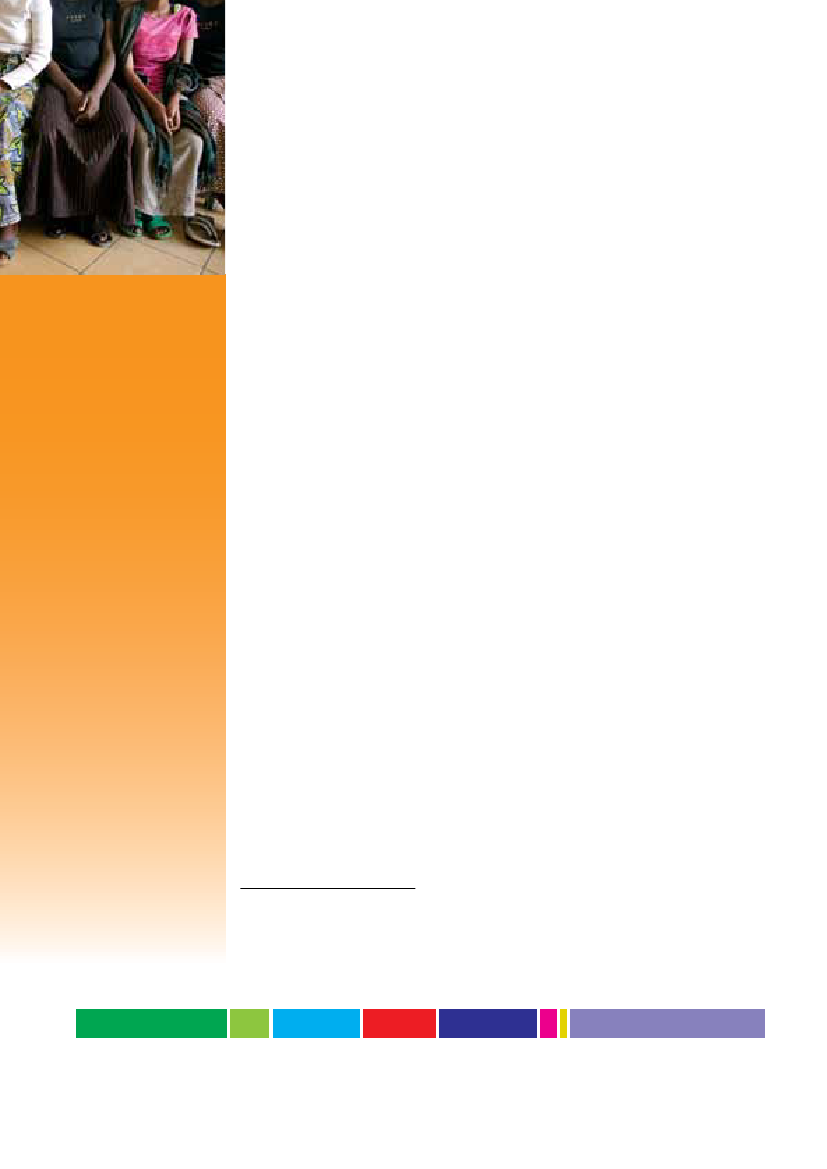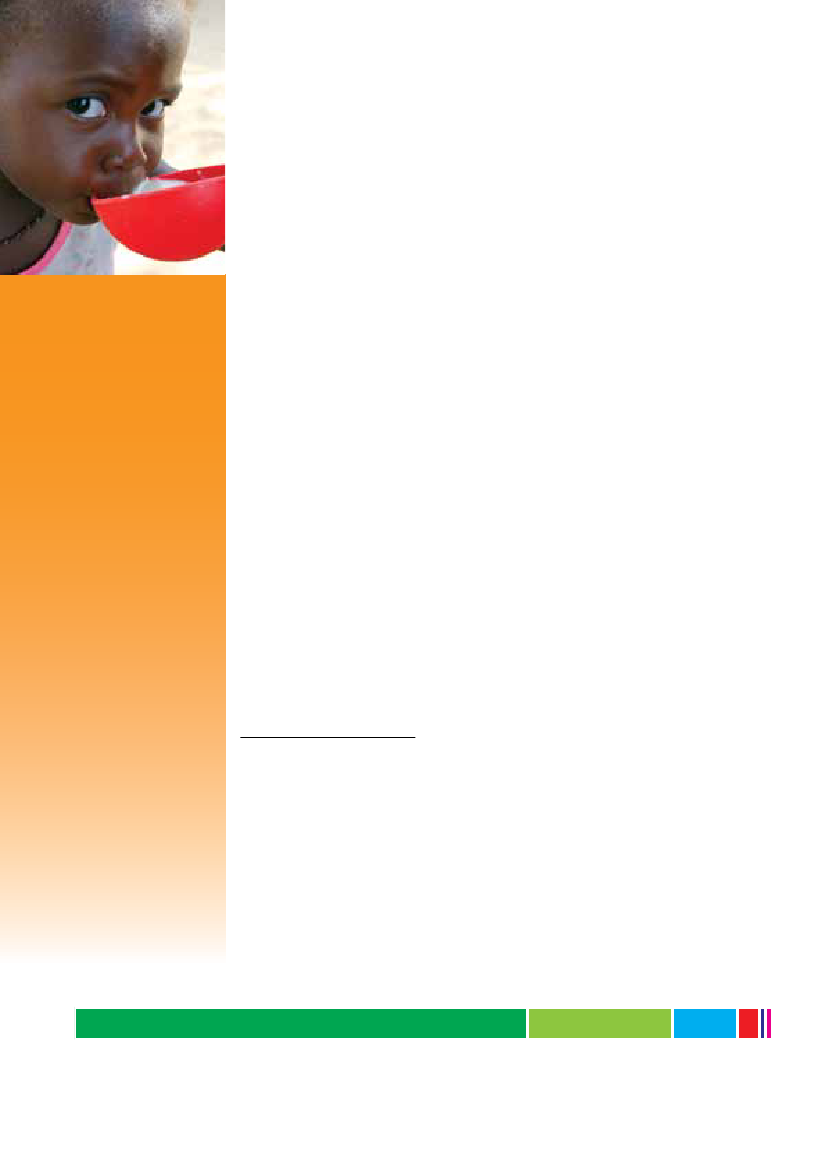Udenrigsudvalget 2010-11 (1. samling)
URU Alm.del Bilag 117
Offentligt
UNICEFHumanitarianActionfor Children
2011
building resilience
� United Nations Children’s Fund (UNICEF)March 2011Permission to reproduce any part of this publication is required.Please contact:Division of Communication, UNICEF3 United Nations PlazaNew York, NY 10017, USATel: + 1-212 326-7434Email: [email protected]Permission will be freely granted to educational or non-profit organizations.Others will be requested to pay a small fee.For any update or corrigenda found subsequent to printing, please visit ourwebsite athttp://www.unicef.org/hac2011ISBN: 978-92-806-4572-9
UNICEFHumanitarianActionfor Children
2011
building resilience
AcknowledgementsThis report was made possible with the advice and contribution of many people from UNICEF Headquarters,regional and field offices. Information for the country chapters was received from the following UNICEF fieldoffices: Afghanistan, Burkina Faso, Burundi, Cameroon, Central African Republic, Chad, Colombia, Congo,Côte d’Ivoire, Djibouti, Democratic People’s Republic of Korea, Democratic Republic of the Congo, Egypt,Eritrea, Ethiopia, Guatemala, Haiti, Iraq, Jordan, Kenya, Kyrgyzstan, Lebanon, Madagascar, Myanmar, Niger,Occupied Palestinian Territory, Pakistan, Philippines, Somalia, Sri Lanka, Sudan, Syria, Tajikistan, Uganda,Yemen and ZimbabweProJECt maNaGEmENt, EDItorIaL aND rESEarCHDermot Carty,Deputy Director,Office of Emergency Programmes; Christine Knudsen,Chief Project Manager;Marika Hofmeister,Project Manager,Piero Calvi-Parisett, Michele Ferenz, James Rogan, Monique Thormann,Writers,Anastasia WarpinskiLLC Writer/Report Editor;Jennifer Meybaum,Editor;Karin Ulin,Researcher,Nadia Falch Bandak,Researcher;Maritza Ascencios,Consulting EditorProGrammE aND PoLICY GUIDaNCEThanks to the following UNICEF Divisions: Office of Emergency Programmes, Programme Division, Public-Sector Alliances and Resource Mobilization Office, and the Division of Policy and Practice. Particular thanksalso to Hilde Frafjord Johnson,Deputy Executive Director;Maria Calivis,Chief of Staff,Louis-GeorgesArsenault,Director,Office of Emergency Programmes; Nicholas Alipui,Director,Programme Division; AfshanKhan,Director,Public Sector Alliances and Resource Mobilization; Richard Morgan,Director,Division of Policyand Practice; Pilar Aguilar, Sharif Baaser, Catherine Barnett, Babita Bisht, Sara Bordas Eddy, Andrew ColinParker, Lisa Doughten, Brendan Doyle, Francois Ducharme, Ayda Eke, Lucia Elmi, Faika Farzana, WilliamFellows, Anne Golaz, Raphael Hermoso, Naomi Ichikawa, Pernille Ironside, Robert Jenkins, Sarah Karmin,Michel Le Pechoux, Mendy Marsh, Louise Maule, Amanda Melville, Claire Morton, Roseline Murama, NalineeNippita, Mads Oyen, Stephan Pichette, Jalpa Ratna, Lara Scott, Antony Spalton, Sonia Sukdeo, Julien Temple,Ellen Van Kalmthout, Tessa Wardlaw. Thanks also to UNICEF Regional Offices: Luc Chauvin, Laura Bill, LanaWreikat, Yodit Abdisa, Robert McCarthy, Grant Leaity, Selassie Atadika, Angela Raven-Roberts, Asim Rehman,Heidi Peugeot, Gianluca Buono, Anna Riatti, Toby Wicks, Thomas Davin as well as all technical advisersDESIGN aND PrE-PrESS ProDUCtIoNLaurie Douglas Graphic DesignmaPS Jihad Abdalla,Emergency OfficerPHotoGraPHY Ellen Tolmie,Senior Photography Editor;Susan Markisz,Lead Photography Researcher/Caption WriterWEBSItE ProDUCtIoNAlex Godoy,Multimedia Project Manager;Dennis Yuen,Web Developer;Andrea Verity,English Web Producer;Emmanuel May, Linda Tom, Ling Tsui,Web Designers;Patrice Brizard, Pedro Bujalance-Andres, Sobhi Jawabra,Diana Jimenez,Language Web ProductionVIDEo ProDUCtIoNPriyanka Pruthi,Producer;John Mims,EditoroUtrEaCHPatrick McCormick,Emergencies Communication Officer;Genine Babakian,Writer/Editor, Media sectionPrINtINGPhoenix Design AidtraNSLatIoNFrench edition:Marc ChalametSpanish edition:Carlos PerellónArabic edition:Sobhi JawabraFurther Information on UNICEF’s humanitarian action can be obtained from:Louis-Georges arsenaultDirectorOffice of Emergency Programmes(EMOPS)UNICEF New YorkTel: +1 212 326-7163Fax: +1 212 326-7037E-mail: [email protected]afshan KhanDirectorPublic Sector Alliances andResource Mobilization (PARMO)UNICEF New YorkTel: + 1-212 326 7160Fax: + 1-212 326 7165E-mail: [email protected]Dermot CartyDeputy DirectorOffice of Emergency Programmes(EMOPS)UNICEF GenevaTel: + 41 22 909 5601Fax: + 41 22 909 5902E-mail: [email protected]
ii
2011 UNICEF HUmaNItarIaN aCtIoN For CHILDrEN| www.unicef.org/hac2011
Contentsivvi113172021222324252730313336373839404142434548495051525356575859626364656667686970ForEWorDUNICEF HUmaNItarIaN aCtIoN FUNDING rEqUIrEmENtS For 2011FoStErING rESILIENCE, ProtECtING CHILDrEN: UNICEF IN HUmaNItarIaN aCtIoNGLoBaL SUPPort For UNICEF EmErGENCY rESPoNSE oPEratIoNSaSIa-PaCIFICAfghanistanDemocratic People’s Republic of KoreaMyanmarPakistanPhilippinesSri LankaCENtraL aND EaStErN EUroPE aND tHE CommoNWEaLtH oF INDEPENDENt StatESKyrgyzstanTajikistanEaStErN aND SoUtHErN aFrICaBurundiEritreaEthiopiaKenyaMadagascarSomaliaUgandaZimbabwemIDDLE EaSt aND NortH aFrICaDjiboutiIraq, Egypt, Jordan, Lebanon and the Syrian Arab RepublicOccupied Palestinian TerritorySudanYemenLatIN amErICa aND tHE CarIBBEaNColombiaGuatemalaHaitiWESt aND CENtraL aFrICaBurkina FasoCameroonCentral African RepublicChadCongoCôte d’IvoireDemocratic Republic of the CongoNigerPHoto CaPtIoNS
www.unicef.org/hac2011 |2011 UNICEF HUmaNItarIaN aCtIoN For CHILDrEN
iii
HaitiGuatemala
NigerBurkinaFasoCôte d'Ivoire Cameroon
ColombiaCongo
Countries and territoriesincluded in2011UNICEF HumanitarianAction for Children
ForewordIn 2010, Haiti was hit bythe worst earthquake inits history – a humanitar·ian tragedy that was com·pounded by a cascadingseries of subsequent crises.During my visits there,I met children who hadlost virtually everything –loved ones, homes, every material possession –and who still faced significant threats. Butwhat struck me most about these children,and so many Haitians, was their resilience inthe face of tragedy, and their capacity to hopefor – and build – a better future.During the catastrophic flooding in Pakistan,I saw the same courage and resilience, and thesame indomitable capacity to pick up the piecesand carry on. And wherever such humanitarianemergencies occur – whether because of natu·ral disasters, human conflict or chronic crisis –resilience is a critical key to recovery.2011 Humanitarian Action for Childrenhigh·lights the ways UNICEF is working to fostersuch resilience at the individual, communityand institutional levels. As the report shows,we are increasingly supporting innovativeefforts to help communities prepare for andlimit the effects of future emergencies – andto bounce back and ‘build back’ better whentragedy does strike.In case after case, we see how such innova·tion has helped people to overcome profoundchallenges. In the Niger, for instance, womenforced from their home villages in search offood for their families have banded togetherto form small business ventures that haveenabled them to send food, seeds and moneyback to their communities. Just as important,
iv
2011 UNICEF HUmaNItarIaN aCtIoN For CHILDrEN| www.unicef.org/hac2011
KyrgyzstanTajikistanIraqOccupiedPalestinianTerritoryAfghanistanPakistanMyanmarChadEritreaSudanYemenDjboutiSri Lanka
DemocraticPeople’s Republicof Korea
CentralAfricanRepublic
Ethiopia
Philippines
SomaliaUgandaDemocraticKenyaRepublicof the BurundiCongo
Zimbabwe
Madagascar
the success of their joint efforts has giventhem confidence and increased their capacityto cope in a crisis.The past year was one of unprecedentedchallenges. All told, over the course of 2010UNICEF responded to at least 290 humani·tarian situations in 98 countries, affectingmillions of people. The disasters in Haiti andPakistan triggered an extraordinary outpour·ing of humanitarian aid – but the needs areenormous, in those nations and in every nationfacing emergencies and chronic crises.While we hope that 2011 will not bring asimilar onslaught, we must be ready to respondquickly when disaster does strike. So this year’sedition ofHumanitarian Action for Childrenalso highlights projected humanitarian needsfor 2011 in 32 countries and territories and 6regions. Funds to meet these needs are critical to
allowing us to respond in emergency situations,and also to breaking repeated cycles of crisis.With your support, we can minimize the impactof humanitarian crises, wherever and wheneverthey occur – and we can help to build greaterresilience in the world’s most vulnerable com·munities. For the sake of the children.
Anthony LakeUNICEF Executive Director
www.unicef.org/hac2011 |2011 UNICEF HUmaNItarIaN aCtIoN For CHILDrEN
v
UNICEF Humanitarian ActionFunding Requirements for 2011REGION/COUNTRYFUNDING REqUIREMENTS FOR 2011 (US$)
aSIa-PaCIFICAsia-Pacific Shared Services Centre AfghanistanDemocratic People’s Republic of KoreaMyanmarPakistanPhilippinesSri Lanka CENtraL aND EaStErN EUroPE aND tHECommoNWEaLtH oF INDEPENDENt StatESCentral and Eastern Europe and theCommonwealth of Independent States Regional Office KyrgyzstanTajikistan EaStErN aND SoUtHErN aFrICaEastern and Southern Africa Regional Office BurundiEritreaEthiopiaKenyaMadagascarSomaliaUgandaZimbabwe mIDDLE EaSt aND NortH aFrICaMiddle East and North Africa Regional Office DjiboutiIraq, Egypt, Jordan, Lebanon and the Syrian Arab RepublicOccupied Palestinian TerritorySudanYemen LatIN amErICa aND tHE CarIBBEaNThe Americas and the Caribbean Regional Office ColombiaGuatemalaHaiti WESt aND CENtraL aFrICaWest and Central Africa Regional OfficeBurkina FasoCameroonCentral African RepublicChadCongoCôte d’IvoireDemocratic Republic of the CongoNiger GLoBaL SUPPort
totaL
1,100,00029,750,00012,000,0009,950,000295,951,00014,022,0009,825,000372,598,000
totaL
900,0006,996,0005,540,00013,436,000
5,600,0005,223,00014,075,00057,416,00016,168,00019,200,00060,698,00010,000,000119,973,000totaL 308,353,0002,240,0004,255,00040,056,00018,759,000162,481,00020,294,000totaL 248,085,00013,000,00010,300,0002,650,000156,967,000totaL 182,917,00018,044,00011,480,0003,350,00011,763,00045,639,0004,830,0005,541,000115,290,00037,062,000totaL 252,999,000 22,400,000GraND totaL 1,400,788,000
vi
2011 UNICEF HUmaNItarIaN aCtIoN For CHILDrEN| www.unicef.org/hac2011
UNICEF Humanitarian ActionFunding Requirements for 2011UNICEF CoUNtrY, rEGIoNaL aND GLoBaL FUNDING rEqUIrEmENtS For 2011Source: UNICEF country offices, end 2010
PakistanSudanHaitiZimbabweDemocratic Republic of the CongoSomaliaEthiopiaChadIraq*NigerAfghanistanGlobal SupportYemenMadagascarOccupied Palestinian TerritoryWest and CentralAfrica Regional OfficeKenyaEritreaPhilippinesThe Americas and theCaribbean Regional OfficeDemocratic People’s Republic of KoreaCentral African RepublicBurkina FasoColombiaUgandaMyanmarSri LankaKyrgyzstanEastern and SouthernAfrica Regional OfficeCôte d’IvoireTajikistanBurundiCongoDjiboutiCameroonGuatemalaMiddle East and NorthAfrica Regional OfficeAsia-Pacific SharedServices CentreCentral and Eastern Europe and theCommonwealth of IndependentStates Regional Office0
296.0162.5157.0120.0115.360.757.445.640.137.129.822.420.319.218.818.016.214.114.013.012.011.811.510.310.010.09.87.05.65.55.55.24.84.33.42.72.21.10.950100150US$ millions* Iraq, Egypt, Jordan, Lebanon and the Syrian Arab Republic
200
250
300
www.unicef.org/hac2011 |2011 UNICEF HUmaNItarIaN aCtIoN For CHILDrEN
vii
Fostering resilience,protecting children: UNICEFin humanitarian actionA world of increasing complexity and riskIn 2010, natural disasters of unprecedented magnitude causeduntold suffering for millions of children, their families andtheir communities. Conflict and insecurity exacted a heavytoll on lives and spirits. The examples of these affronts arenumerous and include the earthquake in Haiti that destroyedits capital city; flooding in Pakistan that submerged one·fifthof the country; parched earth and hunger acrossthe Sahel; and displacement and violence inAfghanistan, the Democratic Republic of theCongo and Somalia. These large·scale humani·tarian crises, as well as many lesser·reportedemergencies, are evidence of the ongoingvulnerability of communities and entire coun·tries to natural and man·made hazards. Thecountry chapters in2011 UNICEF Humani-tarian Action for Childrenshow the impact ofhumanitarian emergencies – some short·term,many of them protracted – on the lives and dignityof children and families.Extensive humanitarian need requires far·reaching humanitarian action, carried outwith utmost speed and often simultaneouslyin different parts of the world. While respond·ing to immediate needs, humanitarian actionalso necessitates a sharpened focus on thelarger duty to address underlying vulnerabili·ties should disaster strike, or strike again,especially at a time when threats are intensi·fying, multiplying and interacting in complexand sometimes little·understood ways.Today it is common for communities alreadyliving on the edge to be buffeted by a host ofsimultaneous or repeated shocks, such as politi·cal crises, disease epidemics or the destructionof shelter and productive assets in a storm orflood. Without the time and means to recover,and without social safety nets to fall back on,many communities lurch from emergency toemergency in a downward spiral of impoverish·ment and social disintegration. The countriesin2011 UNICEF Humanitarian Action forChildrenconfront escalating risks from pre·existing positions of great vulnerability. It is tell·ing that conflict·affected and fragile states arefurthest behind in achieving the MillenniumDevelopment Goals, and that recurring civil waris now the dominant form of armed conflict.1A renewed food crisis unfolding in 2011is but one of several interrelated globaltrends with far·reaching consequences for theworld’s poorest. Climate change is becom·ing a potent driver of increased risk in theform of extreme weather events and throughslower·moving phenomena such as resource
www.unicef.org/hac2011 |2011 UNICEF HUmaNItarIaN aCtIoN For CHILDrEN
1
degradation and the erosion of territories andlivelihoods. Large·scale humanitarian impactsare expected as water and food securitydeteriorate, floods and storms lay waste tocities and essential infrastructure, and peopleare displaced. Children, as ever, will be in theeye of the storm.2The result of these trends is an increase inthe number of people requiring humanitar·ian assistance and of populations at risk, andthis increase requires a strengthened and moreagile response capacity. It also means that theinternational aid system must be retooled tobetter manage unpredictability and addressunderlying vulnerabilities. While this is a vitalgoal of development work, humanitarianaction holds an important place in lesseninghardships and preparing the ground for morerobust recovery and risk management in thefuture. In this overall context of growing com·plexity and need, UNICEF, which responds tomore than 200 emergencies each year, is com·mitted to supporting governments and helpingpeople build their own resilience, through thehumanitarian action outlined in this report, aswell as in its regular programming.
become a catalyst for transformation. For thehumanitarian community, the common under·standing of resilience that follows can offer auseful lens to examine and address increas·ingly complex crisis contexts.In its simplest form, resilience can be bestconceptualized as the ability of critical physicalinfrastructure to absorb shocks.5For instance,the development of appropriate sanitationtechnologies for flood·prone areas can reducethe risk of infectious disease in the wake ofa weather disaster.6But the concept is muchbroader than simply structural fortification andhardware. It provides a lens for understandinghow effectively social systems and their variouscomponents – individuals, families, schools,cities, states, and the family of states thatconstitutes the international system – guardagainst risk and collectively manage threats.Developmental psychologists, for example,try to use resilience as a way to capture thetraits, skills and circumstances that leadsome children to do well despite experiencingextreme deprivation or violence. Amongdevelopmental thinkers, resilience is appliedto communities, which are seen to possessmultiple sources of strength and resources7–including human, material and social capital.8These sources may be rooted in traditions ordeveloped over time and tapped during crisesto reduce and manage loss. At yet a higherlevel of social organization, resilience has alsobeen used as a characteristic of states, as inthe analysis of state·building in fragile andconflict·affected situations carried out by theOrganisation for Economic Co·operation andDevelopment’s Fragile States Group.9Here,resilience is contrasted with fragility, whichis rooted in social contracts that are weakor exclusionary and implies failures in corefunctions of the state, including failure toprovide security and basic services.Resilience is therefore a property of differentinterconnected levels of social and politicalorganization. Highly resilient systems haveboth risk exposure and response capacitiesbroadly distributed among groups.10Inequi·ties and the uneven distribution of skills andresources can undermine resilience.11If adisaster or crisis outstrips coping capacities,
Understanding resilienceRooted in materials science and ecology, theconcept of resilience has increasingly gainedtraction in the work of various social disci·plines. While nuances vary, resilience generallydescribes the ability to anticipate, withstandand bounce back from external pressures and
resilience generally describes the ability to anticipate, withstand and bounce back from external pressures and shocks in ways that avoid a fundamental loss of identity and maintain core functions.shocks – whether physical, emotional, eco·nomic, or related to disaster or conflict – inways that avoid a fundamental loss of identityand maintain core functions.3Some interpre·tations highlight adeptness at changing direc·tion, rather than resisting change, as a definingcharacteristic of resilience;4here adversity can
2
2011 UNICEF HUmaNItarIaN aCtIoN For CHILDrEN| www.unicef.org/hac2011
support from the ‘outside’ can be called onto preserve essential values (such as life) andcrucial functions (such as water provision).In a disaster where the state cannot provideadequate ‘outside’ response to affected com·munities, the international community may becalled upon. In these cases, approaches thatfoster resilience provide not only a rationalefor when or why humanitarian action is neces·sary but also important guidance for how itshould be conducted.There are some commonly considered dimen·sions of resilience that can offer crucial insightsinto how the humanitarian community canidentify entry points for better supportingresilience.12These dimensions are:•flexibility– the ability to change, includingthe speed and the degree of adjustment;•diversity– the variety of actors andapproaches that contribute to the perfor·mance of a system’s essential functions;•adaptive learning– the integration of newknowledge into planning and execution ofessential functions;•collective action and cohesion– the mobili·zation of capacities to jointly decide andwork towards common goals;•self-reliance– the capacity to self·organize,using internal resources and assets, withminimal external support.A key challenge remains: measuring resilience.It is difficult to quantify for a number ofreasons, primary among them the difficultyin measuring something that does not occur:the armed violence that never happens; thehurricane that passes without causing large·scale damage. Yet examples abound of thefailure to nurture resilience – whether theresult of weak governance, poor planning,frayed social bonds, grave inequities oremergency responses that supplant ratherthan reinforce existing capacities. In a contextwhere the future holds increased risks, thetransformative capacity of resilience assumesan ever·larger importance.Despite the body of literature on resilience,the contributions of humanitarian action to
resilience have been relatively less explored.UNICEF’s own understanding of its humani·tarian action within the broader humanitariansystem continues to evolve. Attention to resil·ience can promote humanitarian action that
approaches that foster resilience provide not only a rationale for when or why humanitarian action is necessary but also important guidance for how it should be conducted. is not only predictable, effective and timelybut also strengthens the relationship betweenhumanitarian and development programmingand the capacities of national and local actorsto manage increasing uncertainty and risk.
UNICEF humanitarian actionand resilienceGuided by the Convention on the Rights ofthe Child, UNICEF in 2010 strengthened itscore humanitarian policy to uphold the rightsof children and women in crises. UNICEFreframed its Core Commitments for Children(CCCs) in Emergencies as the Core Commit·ments for Children in Humanitarian Action,reflecting wider shifts in UNICEF’s own workin these contexts as well as the organization’scommitment to humanitarian reform.Key changes include expanding the CCCs toinclude preparedness before the onset of a cri·sis and adopting an early recovery approachduring response – with disaster risk reductionintegrated throughout. The CCCs also movedfrom a focus on activities to broader strategicresults that link humanitarian action to the ful·filment of children’s and women’s rights in eachof UNICEF’s programme sectors. They alsoreflect the recognition that realizing these corecommitments requires the contributions of amultitude of actors, including clusters.Thus reconceived, UNICEF’s humanitarianaction offers a potential platform for support·ing resilience at the national and communitylevels. A few recent examples illustrate howthis has manifested in emergency·affectedcountries.
www.unicef.org/hac2011 |2011 UNICEF HUmaNItarIaN aCtIoN For CHILDrEN
3
InMadagascar,UNICEF supported a pro·gramme to train and raise awareness amongvillage chiefs, school directors, health cen·tre heads, community·based organizationsand mayors on water, sanitation and hygiene(WASH) principles and practices in emergencyresponse. Pre·emergency cooperation agree·ments have been developed with the participat·ing organizations to ensure a timely and rapidresponse in the event of a cyclone or flooding.Such efforts are an example of how UNICEF’scommitment to ensuring the participation ofaffected populations promotes collective actionand cohesion.
that the situation of children and womenis monitored and that interventions areappropriately designed, supporting adaptivelearning through the sharing and applicationof new approaches and technologies. Incyclone·affected areas of Myanmar, UNICEFsupported local authorities in using disaster·resistant standards to construct health centresand child·friendly schools. UNICEF continuesto advocate for wider, gradual adoption ofthese standards across the country.Our humanitarian partnerships with govern·ments, local and international non·governmen·tal organizations (NGOs), communities, civilsociety and the private sector – and at nationalto community levels – allow UNICEF to lever·age diverse approaches as a method for achiev·ing better results for children in humanitarianaction, thus promoting diversity. For example,UNICEF worked with numerous stakeholdersin the conflict·affected town of Marka, nearMogadishu, in a public·private partnershipapproach to water management. Building onthe capacities of local actors, project implemen·tation continued even when Marka was inac·cessible to international United Nations staff.UNICEF’s commitment to the rights of themost vulnerable compels us to work in waysthat prioritize the restoration of self·reliancein emergencies. For example, in the OccupiedPalestinian Territory, in conjunction with NGOsand other counterparts, UNICEF implementedchild protection and psychosocial services tostrengthen the coping mechanisms of morethan 70,000 children and 36,000 caregivers inGaza. Since the 2009 crisis, UNICEF continuesto couple psychosocial support with acommunity·based approach that is integratedwith child protection networks.
UNICEF’s commitment to the rights of the most vulnerable compels us to work in ways that prioritize the restoration of self-reliance in emergencies.The revised CCCs also tighten the linkbetween humanitarian action and development.This stronger integration contributes to UNI·CEF’s institutional flexibility – the nimblenesswith which our programmes adjust to evolv·ing situations. In addition, the sharpened focuson disaster risk reduction and local capacitydevelopment as explicit strategies contribute tocommunities’ own flexibility in the face of mul·tiple shocks, throughout the broader cycle ofprevention, response and recovery. In Ethiopia,UNICEF has supported disaster risk reductionthrough a government·led, decentralized healthextension programme to provide essentialhealth and nutrition services. This programmehas had a significant impact in the commu·nities: Results show an increase in nationaltreatment capacity of severe acute malnutri·tion from 135,000 cases per month in 2009 to200,000 cases per month in 2010. Through thetreatment of children suffering from malnutri·tion, those with severe acute malnutrition cannow be identified earlier and receive life·savingtreatment closer to home, thus helping reducechildren’s vulnerability.Likewise, understanding on·the·ground reali·ties is essential for achieving the CCCs. Beingcontinuously present before, during, andafter an emergency, as UNICEF is, can ensure
The humanitarian systemand resilienceThe humanitarian community, to fulfil its roleand obligations in the face of escalating risk,also needs to be resilient. The response to mas·sive disasters in 2010, such as those in Haitiand Pakistan, as well as to other smaller·scaleemergencies, has demonstrated the dedicationand effectiveness of the humanitarian system
4
2011 UNICEF HUmaNItarIaN aCtIoN For CHILDrEN| www.unicef.org/hac2011
– but it has also highlighted gaps and short·comings in performance that have come underscrutiny.13As we have seen, the challenges willonly increase.As a consequence, intense reflection is underway on what realignments in the humanitariansystem are necessary without compromisingfundamental principles and operational effi·ciency. The Secretary·General recently calledon the humanitarian system to shift from anapproach that is ‘shock driven’ to one that ismore needs based and vulnerability led.14Someagencies have developed explicit approaches toresilience,15while others have called for noth·ing less than a profound paradigm shift in howthey respond to these growing pressures.16Since its origins, the humanitarian communityhas undergone successive phases of evaluation,self·assessment, reform and innovation inefforts to strengthen its effectiveness andreliability. There has been steady progressover the years. The humanitarian reformprocess, begun in 2005 and urged on by theresponse to the Indian Ocean tsunami, hasled to key improvements that can be viewedas contributing to the system’s resilience,though the debate was not explicitly framedin these terms. These improvements includepooled funding mechanisms to enhance flex·ibility; coordination mechanisms (clusters)that maximize the collective action of diversehumanitarian actors; and assessment toolsto better understand context. The recentlyintroduced real·time evaluations improverapid learning and adaptation.While continuing to strengthen responsecapacity, particularly through the clusterapproach, the humanitarian community hasalso made important broader shifts to bet·ter address the environments particular todisasters caused by natural hazards and thoseassociated with conflict – as well as how con·flict and natural hazards interact in ways thatincrease risk.Working more closely with developmentcounterparts to implement the Hyogo Frame·work for Action (2005), humanitarian actorshave integrated disaster risk reduction into
emergency preparedness and response throughthe early recovery approach. Such investmentin disaster risk reduction not only helps tobetter address underlying vulnerability butalso improves partnerships and communityengagement.17The contributions of the humanitarian com·munity to addressing the needs related topost·conflict contexts were validated in the2009Report of the Secretary-General onPeacebuilding in the Immediate Aftermathof Conflict.The Report underlined that thehumanitarian community can provide criticaland early peace dividends to war·weary peo·ple, particularly returnees, and that the earlyrecovery approach can create foundations forlater peacebuilding efforts through capacityassessments, early systems development in keysectors, and capacity development in pocketsof peace, where possible.18The humanitarian community is still strivingto do better in key areas. These includeoverarching leadership, preparedness, nationaland local capacity development and engagingwith local communities, needs assessments,early recovery, and accountability to affectedpopulations.19These efforts are taking placein a context of wider debate on the enabling
Broader trends clearly point in the direction of more extreme global weather conditions in the future, which will have a disproportionate adverse impact on the poorest. environment for humanitarian action, includingfinancing and human resource policies; anincreasingly complex operating environment;the role of political and military actors;decreasing access to people in need; shrinkinghumanitarian space; and how best to engage inchronic and complex emergencies, where thebulk of humanitarian financing is directed.An agile humanitarian system with extensiveand multi·dimensional response capacities willbe essential to reducing vulnerabilities, sav·ing lives and minimizing disaster losses. This
www.unicef.org/hac2011 |2011 UNICEF HUmaNItarIaN aCtIoN For CHILDrEN
5
agility is especially urgent in the face of climatechange. According to the National Oceanicand Atmospheric Administration (NOAA),2010 was tied with 2005 as the warmest yearon record and saw a spate of extreme climateevents in all continents.20Climate·related haz·ards are increasing, accounting for 70 per centof all disasters today compared to 50 per cent
requiring improvement. These areas includethe following:•Partnership– Building resilience is amulti·stakeholder endeavour. Humanitar·ian organizations must seek creative andcontext·specific alliances, ranging from theprivate sector to community developmentorganizations.•Innovation– Humanitarian organizationsmust deliberately foster experimentationand diffusion of promising institutionaland technological solutions.•Risk management– Humanitarian organi·zations need continually to better under·stand and analyse high·risk operatingenvironments in order to find programmeopportunities and access populations. Riskmanagement should enable and not justcontrol.•Fundamentals– Accountability, partici·pation, capacity development and localand national ownership continue to beessential for effectively supporting a com·munity in crisis to build a path to sustain·able recovery.•Social transformation– Resilience isachieved through social processes whoseoutcomes defy precise measurement. Toencourage investments by donor anddeveloping countries that are truly sus·tainable, donors should review and revisetheir own performance monitoring andreporting systems.Achieving progress in these domains willhelp foster a humanitarian system that ispredictable, timely and effective. This progressmust be predicated on a stronger recognitionof the relationship between humanitarianand development programming, and theimportance of supporting national and localactors to manage increasing uncertaintyand risk. In so doing, the humanitariancommunity works towards the resilience ofboth the humanitarian system and the countriesand communities we are committed to serving.
Using resilience as a guiding principle can offer the humanitarian community useful insight into priority areas requiring improvement. two decades ago,21and such climate·relatedcrises are projected to affect hundreds of mil·lions every year as early as 2015.22A conflu·ence of social and economic factors, such asunplanned urbanization and environmentaldegradation, is at work in determining theimpact of climate·related disasters. Broadertrends clearly point in the direction of moreextreme global weather conditions in thefuture, which will have a disproportionateadverse impact on the poorest.The enormity of this challenge must beaddressed with investments that manageclimate·related risks so that entire popula·tions can benefit. Disaster risk reduction,with community resilience as an objective,is increasingly recognized as a key climate·change adaptation strategy. Efforts to build onlocal capacities of disaster·prone and disaster·affected communities must be redoubled as thelarger humanitarian system also better equipsitself for a future of greater risk, uncertaintyand demand.
The way forwardSix years after the Indian Ocean tsunami,the scale and scope of which challengedevery aspect of humanitarian response, thehumanitarian community confronts anotherimportant watershed in its evolution. Discus·sions are under way to take a fresh look at itscurrent business model. Using resilience as aguiding principle can offer the humanitariancommunity useful insight into priority areas
6
2011 UNICEF HUmaNItarIaN aCtIoN For CHILDrEN| www.unicef.org/hac2011
Funding trends in 2010 and plannedhumanitarian action in 2011In response to the pressing needs of vulnerablechildren and women during 2010, UNICEF’sfunding requirements for humanitarian actiontotalled US$1.7 billion. This request wasbased on the humanitarian needs outlined intheHumanitarian Action Report 2010(HAR)– which featured 36 chapters covering coun·try, regional and global requirements23– andin seven Flash Appeals and 13 other appeals.24As of 31 October 2010, US$830.9 millionwas received for all of UNICEF’s humani·tarian activities. This reflects a 45 per centincrease over 2009 funding for humanitarianaction (US$572.4 million, as of 31 October2009), largely due to resource mobilization torespond to the earthquake in Haiti and flood·ing in Pakistan.Humanitarian funding received by UNICEFas of 31 October 2010 reflects a large increaseover 2009 in absolute terms (as seen in thechart below). More than US$406 million, or 49per cent, was contributed for the Haiti earth·quake and Pakistan flood response, with theremaining US$426.4 million directed towardsUNICEF’s other emergency operations.For the HAR 2010 requested budget of US$1.15billion, US$447.9 million – 39 per cent – wasreceived as of 31 October, matching fundinglevels during this period in 2009.25Out of thetotal HAR requirement, those countries andregions with Consolidated Appeals Processes(CAPs) were 37 per cent funded compared to43 per cent in 2009. Flash Appeals in 2010, onaverage, received a higher level of funding thanin 2009 – particularly because of the HaitiEarthquake Flash Appeal. Sixty·nine per centof Flash Appeal needs were funded in 2010,versus 47 per cent in 2009. Excluding Haitifrom the aggregate Flash Appeals, however,would reduce the average funding level to45 per cent.
FIGUrE 1.1 EmErGENCY FUNDING trEND, 1998–2010*Source: UNICEF Public-Sector Alliances and Resource Mobilization Office
12001000800US$ (millions)600
(A) Thematic (unearmarked) funds(B) Non-thematic (earmarked) funds(A+B) All emergency fundsFunding for Haiti earthquake/Pakistan floods
1,129
831735601529663
4434002000197116199235240
391
1998
1999
2000
2001
2002
2003
2004
2005
2006
2007
2008
2009
2010*
* As of 31 October 2010
www.unicef.org/hac2011 |2011 UNICEF HUmaNItarIaN aCtIoN For CHILDrEN
7
UNICEF gratefully acknowledges the generouscontributions made by public and private sectordonors in support of the children and womenaffected by humanitarian crises throughout theworld. The largest proportion of UNICEF’shumanitarian funding was from governmentdonors (40 per cent), followed by UNICEF
Global thematic humanitarian funds enable UNICEF to invest efficiently in new initiatives; meet its commitments to humanitarian reform, particularly its cluster leadership responsibilities; prioritize underfunded crises; and build capacity. these actions help strengthen UNICEF’s programmatic focus on sustainable results for children.national committees (34 per cent). Sources forthe remaining funding included multi·donortrust funds, intergovernmental organizationsand funds raised through UNICEF fieldoffices. As of the end of October 2010, theCentral Emergency Response Fund (CERF)
remained the largest source of humanitarianfunding, with a total contribution of US$87.3million.26The United States Fund for UNICEFwas the second·largest source of humanitarianfunding, providing US$79.5 million – out ofwhich nearly 88 per cent was for emergencyoperations in Haiti. As of 31 October 2010,the top 10 donors of humanitarian funding(shown in the chart below) accounted forapproximately 63 per cent of the humanitariancontributions received by UNICEF for emer·gency operations.Out of the total humanitarian contributionsof US$830.9 million received as of 31 Octo·ber 2010, US$278.5 million (33.5 per cent)was received as thematic funds, which arenot earmarked for particular activities, thusallowing UNICEF to invest in those sectorswhere resources are most needed. This repre·sents a significant increase compared to the2009 figure of US$52.7 million. Thematiccontributions reduce transaction costs andsimplify management of programme budgetsat the country level, and UNICEF is gratefulfor the ongoing generosity of donors whoprovide thematic funding.
FIGUrE 1.2 toP 10 SoUrCES oF HUmaNItarIaN FUNDS, 2010*Source: UNICEF Public-Sector Alliances and Resource Mobilization Office
CERFUnited States Fundfor UNICEFGovernment ofUnited StatesGovernment of JapanEuropean CommissionCommon Humanitarian FundGovernment of AustraliaGovernment of SpainGovernment of CanadaGovernment of theUnited Kingdom0102029.927.525.322.630405060708053.261.559.773.679.5
87.3
90
US$ (millions)* As of 31 October 2010
8
2011 UNICEF HUmaNItarIaN aCtIoN For CHILDrEN| www.unicef.org/hac2011
UNICEF would especially like to acknowledgenational committee partners, which haveprovided more than 90 per cent of thematicfunding received as of the end of October. TheUnited States Fund for UNICEF was the topthematic donor, with a contribution of US$72million, followed by the United KingdomCommittee for UNICEF, the GermanCommittee for UNICEF, the Japan Committeefor UNICEF and the Canadian UNICEFCommittee, as seen in the chart below.While the 2010 level of thematic funding ismuch higher than the 2009 level, an analysisof the recipients highlights that so far in 2010,more than 90 per cent of the thematic fundswere provided for response to the Haiti earth·quake and the Pakistan floods. Only US$27.6million was provided for the remaining coun·tries and regions. UNICEF continues to urgedonors to provide flexible humanitarianfunding for all countries, particularly at theglobal level. Next to regular resources, globalthematic funding is UNICEF’s preferred fund·ing structure. However, only 0.7 per cent ofthe thematic humanitarian funds receivedin 2010 were provided as global thematichumanitarian funds. Global thematic fundingis the most effective option because it allowsUNICEF to respond strategically to thepriority needs of children worldwide. Globalthematic humanitarian funds enable UNICEFto invest efficiently in new initiatives; meetits commitments to humanitarian reform, par·ticularly its cluster leadership responsibilities;
prioritize underfunded crises; and build capac·ity. These actions help strengthen UNICEF’sprogrammatic focus on sustainable resultsfor children.The level of funding received determinesUNICEF’s capacity to help improve the pros·pects and the resilience of children and womenaffected by sometimes multiple crises.InYemen,with a funding level of 66 per centof the requested amount by the end of October,UNICEF, together with partners, treated morethan 11,000 children for undernutrition in32 outpatient treatment sites; provided accessto safe drinking water for more than 46,000internally displaced adults and children inthe northern governorates and 5,000 peoplefrom host communities; offered educationalopportunities to 125,000 children in conflict·affected governorates; and provided psycho·social support for 3,500 vulnerable childrenfacing trauma associated with conflict anddisplacement.InSomalia,where 27 per cent of the popula·tion requires humanitarian assistance, fund·ing enabled UNICEF to provide 1.5 millionchildren under 5 years of age and 1.3 millionwomen of childbearing age with an essentialpackage of life·saving health and nutritionservices. Access to safe water was providedto 1.2 million people in emergency·affectedareas, and more than 92,000 emergency·affected children were enrolled in school.
FIGUrE 1.3 toP FIVE DoNorS – tHEmatIC HUmaNItarIaN FUNDS*Source: UNICEF Public-Sector Alliances and Resource Mobilization Office
United States Fundfor UNICEFUnited KingdomCommittee for UNICEFGerman Committee for UNICEFJapan Committee for UNICEFCanadian UNICEF Committee01015.520
72.022.121.720.5
30
40US$ (millions)
50
60
70
80
* As of 31 October 2010
www.unicef.org/hac2011 |2011 UNICEF HUmaNItarIaN aCtIoN For CHILDrEN
9
Tajikistan,struck by an earthquake, floodsand a polio outbreak in 2010, had receivedonly 3 per cent of funding needs as of October2010. Despite this shortfall, UNICEF, in closecollaboration with World Health Organizationand the Government of Tajikistan, was ableto respond to a major polio outbreak throughthe launch of a rapid and comprehensivepolio campaign that successfully containedthe virus. UNICEF, diverting funding fromother sources, also responded to the flood·affected population in Kulob District, whereapproximately 2,000 people benefited from anemergency hygiene campaign. Approximately300 households received water containers,hygiene kits, soap and water purificationtablets. More than 1,000 teachers in 510schools in the 20 most disaster·prone districtswere trained in simple and effective disasterrisk reduction measures. Psychosocial supportwas provided to an estimated 750 childrenand 560 adults following the earthquake inVanj District.With higher funding levels, much more couldhave been achieved in these countries as wellas in other crisis·ridden countries featured intheHumanitarian Action Report 2010.
UNICEF funding requirementsfor 2011 humanitarian actionIn 2011, US$1.4 billion is needed to supportUNICEF·assisted humanitarian action in 32countries and territories.27Compared to the2010 appeal launched in February 2010,this requirement increased 21 per cent, withthe bulk of funding needs represented byPakistan and Haiti, requiring US$296 millionand US$157 million respectively. As shown inFigure 1.4, the financial needs for emergenciesinAsia-Pacifichave significantly increased andrepresent the region with the highest fundingrequest: US$373 million. Of the funding forAsia, 80 per cent is needed for assistance toPakistani children and women affected byflooding and conflict.The requirements forLatin America and theCaribbeanhave increased eightfold, mainlyas a result of emergency situations in Haitiand the addition of the Guatemala appeal.Although such precarious conditions asthose in Colombia also require a scaled·upresponse, the increase is linked to promotingpreparedness throughout the region as wellas support for smaller·scale emergencies.
FIGUrE 1.4 EStImatED EmErGENCY FUNDING NEEDS BY rEGIoN, 2010 aND 2011Source: UNICEF Office of Emergency Programmes, end 2010
Asia-PacificEastern andSouthern AfricaWest and Central AfricaMiddle East andNorth AfricaLatin America andthe CaribbeanCentral and Eastern Europeand the Commonwealthof Independent States018321135500100150200
373207308370253263248266
20112010250300350400
US$ (millions)
10
2011 UNICEF HUmaNItarIaN aCtIoN For CHILDrEN| www.unicef.org/hac2011
The 2010 regional requirements forCentraland Eastern Europe and the Commonwealthof Independent States(CEE/CIS) have alsoincreased with the inclusion of the Kyrgyzstanappeal as well as increasing needs in Tajikistan.Requirements forEastern and Southern Africahave been significantly reduced, particularly insuch countries as Burundi, Eritrea and Uganda.While maintaining funding requirements forpreparedness following the Sudan referendum,overall requests inWest and Central Africaand theMiddle East and North Africahavealso been reduced.UNICEF’s ability to undertake humanitarianassistance depends entirely on funding fromdonors. UNICEF gratefully acknowledgesdonors’ strong response during 2010 andinvites supporters to maintain or increasetheir commitments to fostering resilience andmeeting the humanitarian needs of childrenand women in emergencies during 2011.
11. Steward, Frances, ‘Horizontal Inequalities as a Cause ofConflict: A review of CRISE findings’, Input paper for WorldBankWorld Development Report 2011,August 2010.12. See for example STEPS Centre, Reframing Resilience,STEPS Briefing 13, <www.steps-centre.org/PDFs/STEPSsumResilience.pdf>, accessed 25 January 2011.13. DARA, Haiti One Year On, <http://daraint.org/haiti-one-year-on>, accessed 12 January 2010.14.Report of the Secretary-General on International coop-eration on humanitarian assistance in the field of naturaldisasters, from relief to development,A/65/3568, Septem-ber 2010, p. 2.15.World Disasters Report 2004. Focus on community resil-ience,International Federation of Red Cross and RedCrescent Societies.16. Omamo, Steven, Ugo Gentilini and Susannah Sandstrom,‘Innovations in Food Assistance: Issues, lessons andimplications’, inFrom Food Aid to Food Assistance,WorldFood Programme, 2010, p. 2.17. Ibid., p. 31.18.Report of the Secretary-General on Peacebuilding in theimmediate aftermath of conflict,June 2009, pp. 10, 15.19. Active Learning Network for Accountability and Perfor-mance in Humanitarian Action,The State of the Humanitar-ian System,ALNAP, London January 2010, pp. 9, 35.20. National Oceanic and Atmospheric Administration, ‘2010Tied for Warmest Year on Record,’ 12 January 2011, <www.noaanews.noaa.gov/stories2011/20110112_globalstats.html>, accessed 25 January 2011.21. OCHA (2009), using EM-DAR, Climate Change: Coping withthe humanitarian impact, Campaign PowerPoint presenta-tion, slide 12, <http://ochaonline.un.org/ochahome/InFocus/ClimateChangeHumanitarianImpact/tabid/5930/language/en-US/Default.aspx>, accessed 25 January 2011.22. Ganeshan, Shamanthy and Wayne Diamond, (2009),Fore-casting the numbers of people affected annually by naturaldisasters up to 2015.Oxfam GB.23. The 2010 HAR includes 16 countries and regions that werepart of a Consolidated Appeals Process (CAP).24. Other appeals include ‘Immediate Needs’ documents andinter-agency appeals (excluding CAP and Flash Appeals).25. All funding requests through theHumanitarian ActionReport 2010refer to figures updated as per mid-yearreview.26. US$45.8 million was provided through the rapid responsewindow and US$41.5 million through the underfundedwindow.27. Twenty-eight country appeals were included in theHumanitarian Action Report 2010.The Congo was addedthrough the HAR mid-year review. New countries includedin 2011 are Burkina Faso, Cameroon, Djibouti, Guatemalaand Kyrgyzstan. Remaining funding needs for Guinea andMauritania, with their own appeals in 2010, have beenincluded in the West and Central Africa regional chapterfor 2011. In contrast to 2010, UNICEF offices in Guinea,Mauritania and Nepal have not included an appeal in the2011 UNICEF Humanitarian Action for Childrenpublication.
1.2.
Barbara Walter, ‘Conflict Relapse and the Sustainability ofPost-Conflict Peace’, Input Paper, WDR 2011.DARA, ‘Climate Vulnerability Monitor 2010: The state ofthe climate crisis’, <http://daraint.org/wp-content/uploads/2010/12/CVM_Complete.pdf>, accessed 25 January 2011.Almedom, Astier M. and James K. Tumwine, ‘Resilience toDisasters: A paradigm shift from vulnerability to strength’,African Health Sciences,vol. 8 Special Issue, December2008, p. 1.Pelling, Mark,Adaptation to Climate Change: From resili-ence to transformation,Routledge, New York, 2011, p. 44.Institute for National Security and Counterterrorism, Proj-ect on Resilience and Security, ‘Resilience in Post-ConflictReconstruction and Natural Disasters’, Workshop Report,Syracuse University, 9 March 2009, <http://insct.syr.edu/uploadedFiles/insct/up loadedfiles/PDFs/INSCT%20Work-shop%20Report_Resilience%20and%20Security.pdf>,accessed 25 January 2011.World Health Organization, Regional Office for SouthAsia,C’Community Resilience in Disasters: How theprimary health care approach made a difference in recentemergencies in the WHO South-East Asia Region’, 2010,<www.searo.who.int/LinkFiles/EHA_CRD.pdf>, accessed 25January 2011.Kirmayer, Laurance J., et al., ‘Community Resilience: Mod-els, metaphors and measures’,Journal de la santé autoch-tone,November 2009, <www.naho.ca/jah/english/jah05_01/V5_I1_Community_04.pdf>, accessed 25 January 2011.International Federation of Red Cross and Red CrescentSocieties,World Disasters Report 2004: Focus on Commu-nity Resilience,2004.Organisation for Economic Cooperation and Development,‘Concepts and Dilemmas of State Building in Fragile States:From fragility to resilience’, OECD/DAC Discussion Paper,March 2008.
3.
4.5.
6.
7.
8.
9.
10. Evans, Alex and David Steven, ‘The Resilience Doctrine’,World Politics Review,7 July 2009, <www.globaldashboard.org/wp-content/uploads/2009/The_Resilience_Doctrine.pdf>, accessed 25 January 2011.
www.unicef.org/hac2011 |2011 UNICEF HUmaNItarIaN aCtIoN For CHILDrEN
11
2011 UNICEF HUmaNItarIaN aCtIoN For CHILDrEN
Global Support for UNICEFEmergency Response Operations
Global Support for UNICEFEmergency Response OperationsMajor disasters in Haiti and Pakistan struck within six months of eachother in 2010, eliciting an extraordinary global response that mobilized thefull community of humanitarian organizations and partners. The scope ofdestruction and humanitarian need in these two countries alone, occurring indifficult geographical locations and affecting large populations (more than22 million vulnerable people altogether), highlighted, once again, the need tostrengthen humanitarian systems for a more effective response to major crises.On average, UNICEF responds to more than200 emergencies every year, informing andshaping these interventions as a global leaderfor children. Ultimately, stronger and betteradapted systems will result in a more efficientresponse and lead to greater fulfilment of chil-dren’s and women’s rights.For UNICEF, humanitarian action encompassesmore than rapid response. It also involves reli-able preparedness and calls for investment inearly recovery from the very onset of a response.UNICEF increasingly recognizes the need for allits programmes (both development- and emer-gency-related) to build resilience and reduce risk.These aims are achieved in various ways that arefully reflected in the revised Core Commitmentsfor Children in Humanitarian Action (CCCs) andinclude supply and logistics, programming,human resources, policy and practice, communi-cation and information technology.UNICEF brings the full range of support from allcorners of the organization to meet the humani-tarian needs of children and women. Headquar-ters in New York, Geneva, Copenhagen, Brusselsand Tokyo are centres of global support for coun-try offices that require additional assistance instaffing, supplies and logistics, and in identifyingsources and mechanisms to better access finan-cial resources to respond to emergencies. Theseoffices mobilize external support and identifysurge capacity from UNICEF offices worldwide.Supply hubs with strategic stocks in Copenha-gen, Dubai, Panama and Shanghai enable quickdelivery of life-saving supplies within the firstfew hours of a rapid-onset emergency as wellas coordinated supply chain management fordisaster- or conflict-affected areas. In addition,UNICEF’s seven regional offices provide leader-ship, advocacy, oversight, quality assurance andtechnical and operational support to countryoffices working to meet humanitarian needs.promote predictable, effective and timely collec-tive humanitarian action, around which UNICEFengages with partners including host govern-ments, Member States, operational and clus-ter partners, and staff. Key changes to the CCCsinclude the recognition that humanitarian actionencompasses sound preparedness as well as animmediate emergency response, and an emphasison the importance of applying an early recoveryapproach in the response. The policy now reflectsUNICEF’s cluster accountabilities as a vital strat-egy to realize humanitarian results. It recognizesthe importance of national capacity development,advocacy, partnerships and other key strategiesthroughout preparedness and response.Strong collaboration with non-governmentalorganizations (NGOs) is crucial to achievingresults for children through humanitarian action.In 2010 UNICEF continued to expand the useof revised cooperation and small-scale fundingagreements with NGOs. This expansion has cre-ated more flexible funding options, enhancedjoint results, fostered capacity development oflocal institutions and better aligned UNICEF’swork with that of partners.Like other agencies with cluster leadershipresponsibilities, UNICEF mobilized significantcapacity and support for timely and appropriatecoordination in the face of unparalleled disastersin Haiti, Pakistan and 27 other countries wherethe cluster approach has been activated. UNICEFalso strengthened gender and human rights pro-gramming in the context of humanitarian actionthrough training, deployment of gender expertsto advise clusters on mainstreaming, and dis-semination of best practices. UNICEF headquar-ters provided guidance and on-demand adviceto country and regional offices regarding theapplication of international humanitarian lawand humanitarian principles in challengingoperational environments and in complex emer-gencies such as Kyrgyzstan, the Occupied Pales-tinian Territory and Somalia.During the first six months of 2010, more than400 surge capacity assignments were requestedfor the Haiti office. In comparison, during all of
HUmaNItarIaN FUNDING at WorK: GLoBaL HIGHLIGHtS From 2010In April 2010 UNICEF adopted the third revisionof the CCCs, its humanitarian policy for upholdingthe rights of children affected by crisis. The CCCs
14
2011 UNICEF HUmaNItarIaN aCtIoN For CHILDrEN| www.unicef.org/hac2011
2009, 259 internal and standby surge staff weredeployed across the entire organization. Forcountries facing both large- and medium-scaleemergencies in 2010, UNICEF mobilized a sig-nificant emergency staff surge to strengthen thecapacity of country offices. This surge took theform of technical support, management and clus-ter coordination, and such operational supportas human resources, supply and logistics, andinformation management. Emergency capacityfrom within the organization was complementedby expertise drawn from standby partners fromgovernment and private companies, as wellas from 18 NGOs. These partnerships allowedUNICEF to deploy 185 personnel to 35 differentoffices, representing more than 23,000 days ofdeployment and an increase in standby deploy-ments of more than 34 per cent.In 2010, global emergency supply needs morethan doubled as compared to 2008 and 2009combined. Through accelerated use of all itsassets, the UNICEF Supply Division in Copen-hagen met its commitment to pack and shipemergency supplies within 48 hours. Logisticsnetworks in the field and at headquarters con-tributed to better information sharing betweenpartners and better identification of what prod-ucts were needed and where, as well as torenewed supply training and the release of cru-cial staff for temporary deployment. Competingdemands for large quantities of similar suppliesduring simultaneous large- and medium-scaleemergencies proved challenging, however, andways to improve supply flow in such circum-stances will be addressed during 2011.In the immediate aftermath of the Haiti earth-quake, which also damaged UNICEF’s premises,emergency information technology and telecom-munications response kits were shipped to Port-au-Prince from in-house stockpiles and set up byemergency-trained experts from within UNICEFand standby partner organizations. While thesekits enabled essential telecommunications linksfor the makeshift office, other key informationtechnology services could not immediately beestablished on site. The office had to rely insteadon a shadow office operating out of the Domini-can Republic to host key UNICEF informationsystems which were accessed remotely fromPort-au-Prince.In 2010 UNICEF made considerable investmentsin developing a programming approach that ismore in tune with and informed by emergency-related risks. A key goal of this transformation isfor all UNICEF country programmes to increasetheir attention to disaster and conflict preven-tion, mitigation and preparedness. The newapproach provides a strong platform for engag-ing governments and other partners in sus-tainable strategies for reducing humanitarianrisks, with long-term benefits to communitiespotentially affected by emergencies. Main-streaming risk-informed programming and pro-viding guidance to country offices on disaster
risk reduction are essential to strengtheningpractice in this area.Investing in national capacity developmentbefore, during and after crises can help nationalactors fulfil their obligations to uphold and pro-mote children’s and women’s rights in humani-tarian situations. While not new to UNICEF,capacity development has not been system-atically applied in emergency settings and hasoften not been comprehensive enough to ensurereal and lasting change. UNICEF is now develop-ing technical guidance on capacity developmentin humanitarian settings and has provided directsupport to Southern Sudan and to the Ugandacountry office in applying this approach, includ-ing in post-conflict and fragile settings.Headquarters further provided guidance toUNICEF staff on the purpose, principles and keymanagement entry points for applying an earlyrecovery approach in humanitarian action. Staffsurge support on early recovery focused particu-larly on Haiti and Pakistan to strengthen planningand response. UNICEF remained very engaged inpolicy development and country-level initiativesto ensure enhanced United Nations coherence inthe context of complex emergencies. A techni-cal note on engaging integrated United Nationspresences was developed to complement inter-agency guidance and a peer reference group wasestablished for UNICEF staff working in countrieswith these missions. UNICEF staff participatedin a number of inter-agency integrated strategyplanning and assessment missions, including toBurundi, Côte d’Ivoire, the Democratic Republicof the Congo, Somalia and Timor-Leste.
GLoBaL SUPPort: LooKING ForWarDCore Commitments for Children in Humanitarian action and performance monitoring UNICEF is continuing the rollout of the revisedCCCs and is encouraging all country and regionaloffices to adopt a standard- and coverage-basedapproach to monitoring and reporting duringemergency responses. The approach includesperformance indicators aligned to the CCCs andglobal standards, which will also be consistentwith Inter-Agency Standing Committee (IASC)initiatives. This monitoring and reporting ini-tiative is benefiting from experience acquired inHaiti and Pakistan and is now being piloted inSouthern Sudan.
Humanitarian reform Capacity building to strengthen UNICEF’s role asthe global cluster lead in water, sanitation andhygiene (WASH); nutrition; education (along withSave the Children); and the child protection andgender-based violence areas of responsibility(the latter along with the United Nations Popula-tion Fund) will build on lessons learned in Haitiand Pakistan and during other emergencies.
www.unicef.org/hac2011 |2011 UNICEF HUmaNItarIaN aCtIoN For CHILDrEN
15
UNICEF will work with other IASC members toclarify expectations and chart a way forward tofurther enhance collective humanitarian action. Inthe clusters where it has global accountabilities,UNICEF will continue to look for more predict-able funding arrangements for cluster activities,organize training on the roles of lead and mem-bers, and clarify cluster accountabilities within theorganization. Human-resources rosters for qualitycluster support will be further enhanced. UNICEFis also actively involved in inter-agency efforts tostrengthen pooled humanitarian funding mecha-nisms and other tools to improve response.
Efficiency of responseBuilding on the experience of 2010, UNICEF willfurther vet talent pools, streamline processes,and revamp and merge its surge roster to allowfor a larger, high-quality group of external can-didates and more rapid deployment to enhancecountry office capacity during single or concur-rent emergencies. An internal review of busi-ness processes in sudden-onset emergencies– including of corporate emergency activationprocedures, standard operating procedures andsimplified processes – is under way. Supportfor countries at the onset or in the midst of pro-tracted emergencies will become stronger withrollout of minimum human resources manage-ment standards and regional surge capacitytraining. UNICEF will also enhance its global sup-ply strategy, preparedness and logistics networkfor rapid emergency response through ongoingcoordination with partners and suppliers.
Emergency risk-informed programming UNICEF aims to ensure that emergency risksare addressed in all phases of planning andprogramming, with an eye towards identifying,assessing, reducing and managing risk in amore holistic manner. This process begins withharmonized risk assessments as a key tool tomap programme priorities. At the same time, theUnited Nations Security Management Systemhas shifted to a targeted model for specifichigh-risk situations; this model helps determinethe kind and level of staff deployment required,as well as what programme activities shouldtake place.As part of this process, the organizationcontinues to work with the members of theProgramme Criticality Working Group, whichUNICEF is chairing, on the development of adraft framework to enable effective prioritizationin high-risk environments. In a related effort,UNICEF is developing a conflict analysis tool tohelp its country offices better map conflict risksto inform programmes. UNICEF is also workingto identify more specifically its contributionto peacebuilding and to provide country andregional offices with required guidance to ensurethat this contribution helps societies evolvetowards sustainable peace.
advocacy UNICEF is undertaking an analytical review ofhumanitarian advocacy practices to persuadedecision makers to adopt policies and take actionsto promote and protect the rights of children andwomen in humanitarian situations; to promote theinternational agendas for children in the contextof emergencies; and to identify the role that otheractors, including donors, can play in addressingsensitive advocacy issues such as humanitarianaccess. Advocacy work will strengthen engage-ment with the Security Council, including on theUnited Nations Monitoring and Reporting Mech-anism on Grave Child Rights Violations in Situa-tions of Armed Conflict; capacity to monitor, reportand respond to violations; and the development ofkey policy, guidance and tools. UNICEF will alsoengage the Security Council on issues related tochildren and women in conflict situations and willcontinue to advocate with international media,civil society partners and the public.
High-threat environments Better delivery of quality programmes in envi-ronments with high security risks is a priority forUNICEF, as is ensuring that Member States andother actors understand and recognize humani-tarian principles, and that UNICEF country officesreceive the necessary support to decide on aneffective strategy in highly volatile and complexenvironments. As part of this process, UNICEFcontinues to work with the members of the Pro-gramme Criticality Working Group on the devel-opment of a draft framework to enable effectiveprioritization of programme activities in order toensure that their impact on the populations, andnot on the organization, determines each activ-ity’s criticality. UNICEF is also working with otherhumanitarian partners to find solutions to themany challenges faced in delivering humanitar-ian assistance in today’s crisis contexts. Goodpractices and support, such as use of remoteprogramming, will also be provided to countryoffices in areas of high security risk.
Funding requirementsIn the midst of several large-scale emergencies,UNICEF is seeking US$22.4 million to support aneffective and integrated response to today’s glo-bal humanitarian crises. This funding will com-plement the existing US$22.7 million that hasalready been earmarked for this purpose fromUNICEF’s core budget and generous contribu-tions from donors.UNICEF will ensure implementation of strategicapproaches, work with national governments,provide technical support, strengthen predictablehumanitarian action through clusters and buildresilience at all levels with partners and govern-ments across all sectors of work.To accomplish these goals, carry out its responsi-bilities to children and families in crisis situationsand meet the serious challenges of humanitarianaction through sustainable and effective globalsupport to regional and country offices, UNICEFis pursuing secure and predictable funding.
16
2011 UNICEF HUmaNItarIaN aCtIoN For CHILDrEN| www.unicef.org/hac2011
2011 UNICEF HUmaNItarIaN aCtIoN For CHILDrEN
Asia-Pacific
Afghanistan•Democratic People’s Republic of KoreaMyanmar•Pakistan•Philippines•Sri Lanka
Asia-PacificCHILDrEN aND WomEN IN CrISIS
HUmaNItarIaN FUNDING at WorK: HIGHLIGHtS From 2010In 2010, UNICEF estimated thatUS$1.9 million was neededto fund its humanitariancoordination and technicalsupport work in the Asia-Pacific region. As of October2010, a total of US$987,637had been received, represent-ing 52 per cent of the goal.Through UNICEF’s Asiaand Pacific Shared ServicesCentre (APSSC), preparednessactivities were strengthenedin 13 out of 22 country officesduring the yearly monsoonand cyclone season. Duringflooding in Pakistan, thisreadiness paid off whenAPSSC provided massivesurge capacity for a prolongedperiod: the regional emergencyadviser, the senior emergencynutrition, education andWASH emergency specialistsall directly supported theemergency response, helpedidentify additional staff forthe education and nutritionclusters and also conductedthe rapid assessment. Duringthe extreme cold weather inMongolia, known asdzud,the emergency officer fromNepal was sent to supportcoordination of the response.Towards the end of the year,a disaster risk reductionspecialist joined APSSCto strengthen the focus onprevention and mitigation.
From earthquakes to cyclones to monsoons, 89 per cent of people whosuffered from natural disasters in 2009 lived in Asia.1In Pakistan alone,20 million people were affected in 2010 by flooding that submergedone fifth of the country’s land mass, prompting UN Secretary·GeneralBan Ki·Moon to state: “Their hardship is on a scale I have neverseen before. Words cannot describe what I have seen, what I havefelt while being in Pakistan. It requires a response to match.”2Withsuch a disproportionate distribution of disaster impacting this partof the world, UNICEF’s ability to bolster prevention, readiness andresponse is crucial to lessening the impact of crises when they occur.Every missed opportunity to alleviate the impact of natural disastersand failure to respond quickly to emergencies results in a ripple of life·altering consequences diminishing survivors’ health, nutritional status,and access to education and adequate water and sanitation.mEEtING UrGENt NEEDS aND BUILDING rESILIENCE IN 2011UNICEF’s priority remains strengthening the ability of all 22 country offices in the region toprevent, prepare for, mitigate and respond to crises affecting women and children.
•The APSSC will conduct comprehensive risk assessments to better understand current
trends, which are shaped by increased exposure, haphazard development processes andclimate change.advice to country offices about access to financial and human resources, along with supplies,to ensure a coordinated and results-based response.
•At the onset of emergencies, APSSC cluster specialists will provide technical support and•The APSSC will strengthen the capacities of country offices, government counterparts and
cluster members through customized capacity-building events on UNICEF preparedness aswell as cluster development. Training and implementation of tools enhancing the fulfilmentof UNICEF’s revised Core Commitments for Children in Humanitarian Action and clusterleadership accountability will be provided to country offices. Capacity development ondisaster risk reduction will also be offered during early recovery, preparedness and regularcountry programme planning.
1.2.
Vos, Femke, et al., ‘Annual Disaster Statistical Review 2009: The numbers and trends’, Centre for Research onthe Epidemiology of Disasters, Brussels, 2010, p. 1.Ki-moon, Ban, ‘Secretary-General’s Remarks at Ceremony Marking World Humanitarian Day’, United NationsOffice of the Spokesperson for the Secretary-General, New York, 19 August 2010, www.un.org/apps/sg/sgstats.asp?nid=4731, accessed 5 December 2010.
18
2011 UNICEF HUmaNItarIaN aCtIoN For CHILDrEN | www.unicef.org/hac2011
FUNDING rEqUIrEmENtS For 2011UNICEF is requesting US$1.1 million in 2011 to continue its work on improving the delivery,speed and coordination of emergency and risk reduction programmes in a region characterizedby increased frequency and intensity of natural and human-made disasters. Without in-countrytraining aimed at prevention, mitigation, preparedness and response, the health and lives ofmillions of vulnerable women and children will continue to be threatened. It is imperative tostrengthen country office capacities to provide basic services quickly in the face of disaster.more information regarding the details of the humanitarian action plans for the asia-Pacific region can be found at www.unicef.org/hac2011 and the regional office web-site at www.unicef.org/eapro.
UNICEF EmErGENCY NEEDS For 2011(in US dollars)Total
$1,100,000400,000Technical support to UNICEFcluster leadership accountability
500,000Technical support to UNICEFprogramming in emergencies
Disaster risk reduction
200,000
www.unicef.org/hac2011 |2011 UNICEF HUmaNItarIaN aCtIoN For CHILDrEN
19
Asia-Paci c
AfghanistanCHILDrEN aND WomEN IN CrISISIn 2010, damaging floods added to the humanitarian needs experienced by children andwomen in Afghanistan, where children live in the midst of a deadly conflict piercing the surfaceof the country’s social and political life. The total population of internally displaced peoplehas recently increased to over 440,000 people, 60 per cent of whom fled due to conflict.1These individuals have heightened vulnerability to illness and undernutrition. Widespreadviolence has decimated infrastructure, and around 5 million children, mostly girls, cannotaccess education.2In 2010, heavy flooding throughout the country damaged water systemsand adversely affected the lives of thousands of families. Relief efforts for internally displacedchildren and families are stymied by violence aimed at aid workers, and worsened securityconditions are forecast for 2011, a testament to the need for strong, effective humanitarian aidand the challenge in providing it.
mEEtING UrGENt NEEDS aND BUILDING rESILIENCE IN 2011HUmaNItarIaN FUNDING at WorK: HIGHLIGHtS From 2010In 2010, UNICEF estimatedthat US$25,064,484 wasneeded for its humanitarianwork in Afghanistan. Asof October 2010, a total ofUS$9,572,677 had beenreceived, or 38 per cent ofthe 2010 request. Given thislevel of funding, UNICEFmade progress in improvingthe prospects of childrenand women by providingpaediatric medicines for over40,000 children suffering fromrespiratory infections relatedto the H1N1 epidemic. Some6.5 million children under 5years old were successfullysupplemented with vitaminA. About 700,000 peoplereceived access to safewater through constructionof numerous new waterfacilities. UNICEF assisted inthe ongoing operation duringthe difficult winter monthsof more than 1,300 schoolsfor 584,000 students and wasinvolved in the reporting,monitoring and managementof 1,700 child protection cases(700 girls and 1,000 boys).Together with the Government of Afghanistan, other UN agencies and NGOs, and as clusterlead for nutrition and WASH and co-lead for education, UNICEF will meet the basic humanitarianneeds of an estimated 2.4 million people.
•Some 23,000 severely malnourished children and 216,000 pregnant and lactating women
will benefit from community-based nutrition care, counselling from emergency-skilled healthworkers and supplementary feeding.nationally, 270,000 children and 108,000 women who are pregnant or lactating will haveaccess to adequate health care.water points and rehabilitation of 1,000 non-functional water supply systems.
•As many as 40,000 internally displaced persons will be provided with family kits, and•WASH activities will include construction of 1,200 community water systems, 40 strategic
•Immediate educational needs will be met for over 584,000 students and 12,000 teachers in
the most remote and vulnerable areas of the country, while relief supplies of emergencyteaching materials will continue to be built up.Child UK and Children in Crisis will be supported to provide services tailored to the needsof children affected by armed conflict and those who are victims of violence, abuse orexploitation.
•Child protection actors, including Save the Children Alliance, Child Fund Afghanistan, War
FUNDING rEqUIrEmENtS For 2011UNICEF is requesting US$29,750,000 to carry out its planned activities in Afghanistan. Thisrequest is aligned with the 2011 Consolidated Appeals Process (CAP) requirements. Fullfunding will empower UNICEF to respond to the many humanitarian needs experiencedby children and women in Afghanistan and continue its work building the resilience of avulnerable population.more information on achievements of 2010 and the humanitarian action planned for afghanistan in 2011 can be found at www.unicef.org/hac2011.1.2.Office for the Coordination of Humanitarian Affairs, “Afghanistan 2011: Consolidated Appeal”, United Nations,Geneva, November 2010, p. 1.Initial Assessment of the Afghanistan National Education Strategic Plan (NESP II) 1389-1393 (2010-2014), p. 16.
UNICEF EmErGENCY NEEDS For 2011(in US dollars)Total
$29,750,000Child protection
4,273,000Health6,925,000Nutrition10,742,000WASH
1,338,000
Cluster coordination
1,143,000
5,329,000Education
20
2011 UNICEF HUmaNItarIaN aCtIoN For CHILDrEN | www.unicef.org/hac2011
Afghanistan
Democratic People’s Republic of KoreaCHILDrEN aND WomEN IN CrISISStunting, wasting, undernutrition – these harsh words should have no place in the vocabularyof childhood. Yet in the Democratic People’s Republic of Korea, they define the reality for manychildren and their mothers. Persistent domestic food shortages, brought about by recurrentnatural disasters and decreased international food aid to the country,1have added new dimen-sions to a landscape marked by food insecurity. These are grim tidings in a country where anestimated 37 per cent of the population depends on food aid.2Access to the population in need remains problematic in the Democratic People’s Republic ofKorea, with the exception of the Expanded Programme on Immunization and micronutrientsupplementation. UNICEF and other UN agencies follow the principle of ‘no access, no support’and continue to advocate for access to people who need aid and transparency of information.
mEEtING UrGENt NEEDS aND BUILDING rESILIENCE IN 2011HUmaNItarIaN FUNDING at WorK: HIGHLIGHtS From 2010In the 2010HumanitarianAction Report,UNICEFestimated that US$10million was needed to fundits work in the DemocraticPeople’s Republic of Korea.As of October 2010, a totalof US$2,050,636 – only21 per cent – had beenreceived. With this funding,priority was given to keyinterventions for highestimpact. 80 per cent ofpregnant women nationwidereceived micronutrientsupplements to prevent ortreat anaemia. According tothe ministry of public health,children in 105 countieswhere rates of severeacute malnutrition werehigh received treatment,with 75 per cent makinga complete recovery. Inaddition, 3.5 million childrenand women had access toessential medicines, and sixcommunity water systemswere rehabilitated to provideclean water for 46,000people, including 16,000children – thereby helpingprevent the recurrent spreadof disease.UNICEF, together with the Government of the Democratic People’s Republic of Korea, non-governmental organizations and other international agencies, will focus on assisting themost vulnerable and hard-to-reach people in rural areas. The organization serves as leader ofthe education and WASH theme groups in the country. UNICEF expects to reach around 4.4million people, including 3.3 million women of childbearing age and around 573,000 girls and581,000 boys. Just over 60 per cent of intended beneficiaries live in rural areas.
•In 2011, UNICEF and its partners will treat 13,000 children suffering from severe acute
malnutrition, with the goal of a 100 per cent cure rate. Another priority will be to promoteadequate infant and young child feeding: exclusive breastfeeding for the first six months,introduction of safe and nutritious foods after six months, and continued breastfeeding fortwo years or beyond, augmented by micronutrient supplementation when necessary.cent vaccination coverage target for children under age 1 and will also increase access tomaternal and neonatal health-care services.
•To reduce mortality rates among infants and children, UNICEF intends to surpass the 95 per•To help stop child deaths caused by diarrhoea and acute respiratory infections due to
contaminated water sources, 185,000 people will benefit from more consistent access tosafe water brought by gravity-fed water supply systems and repaired water and sanitationinfrastructure.emergency to facilitate early resumption of normal curricular activities. UNICEF will alsopre-position emergency school supplies for around 25,000 children to enhance emergencypreparedness and early response and maintain children’s vital link to school and learning intimes of distress.
•UNICEF will support the Government in the rehabilitation of kindergartens and schools post-
FUNDING rEqUIrEmENtS For 2011UNICEF is requesting US$12 million for its 2011 humanitarian work, an increase reflecting theexpanded geographical reach of its programmes that now cover more people, as well as recordnumbers of people affected by natural hazards and food insecurity. Without funding for the keyactivities, the adverse effects of lack of food will continue to haunt the country’s women andchildren, with no sign of abating.more information on achievements of 2010 and the humanitarian action planned for the Democratic People’s republic of Korea in 2011 can be found at www.unicef.org/hac2011 or the country office website at www.unicef.org/dprk.1.2.World Food Programme, ‘Protracted Relief and Recovery Operations – Democratic People’s Republic of Korea’(WFP/EB.A/2010/9-C/1), WFP, Rome, 11 May 2010, p. 6.Food and Agriculture Organization of the United Nations, ‘Special Report: FAO/WFP Crop and Food SecurityAssessment Mission to the Democratic People’s Republic of Korea’, FAO, Rome, 8 October 2008, p. 4.
UNICEF EmErGENCY NEEDS For 2011(in US dollars)Total
$12,000,0001,000,000Education3,000,000WASH
5,000,000Health3,000,000Nutrition
www.unicef.org/hac2011 |2011 UNICEF HUmaNItarIaN aCtIoN For CHILDrEN
21
DPRK
MyanmarCHILDrEN aND WomEN IN CrISISThe most severe and recent hardships affecting children and women in Myanmar are attributableto cyclones. As the worst natural disaster to ever befall the country,1the legacy of Cyclone Nargisincludes housing devastation, destruction of agricultural land and declining job opportunitiesfor the many labourers who inhabit the delta. Children in hard-to-reach areas continue tosuffer from undernutrition and inadequate sanitary facilities. Another cyclone, Giri, hit theimpoverished area of Rakhine State in October 2010, affecting at least 260,000 people; morethan 100,000 were left homeless and most infrastructure was destroyed in the most severelyhit townships. Young children, in particular, have been placed at high risk of undernutritionand disease.
mEEtING UrGENt NEEDS aND BUILDING rESILIENCE IN 2011UNICEF, the cluster lead for nutrition and WASH and co-lead for education, will work togetherwith the Government of Myanmar, other UN agencies and NGOs to focus on assisting the mostvulnerable and hard-to-reach children in areas of Rakhine (including Northern Rakhine State),Chin State and the Irrawady Delta. In 2011, UNICEF expects to reach over a million people,including 190,000 women, 380,000 girls and 370,000 boys living in emergency conditions.
HUmaNItarIaN FUNDING at WorK: HIGHLIGHtS From 2010In 2010, UNICEF estimatedthat US$15,899,722 wasneeded to fund its humani-tarian work in Myanmar.As of October 2010, a totalof US$3,624,422 had beenreceived, 23 per cent of thegoal. Despite the shortfall infunding, UNICEF was ableto improve the well-beingof women and childrenaffected by the cyclones.Twenty-four health centreswere rebuilt to new cyclone-resistant standards; 52,000households receivedmosquito nets to stave offmalaria. Around 94 per centof children under age 5(280,000 children) receivedvitamin A supplementation;micronutrients were providedto 81,000 pregnant andbreastfeeding women.UNICEF met urgent needs fordrinking water by providing7.5 million litres of water for37,500 people and improvedwater-storage capabilitiesfor approximately 53,000families. Nearly 50 schoolswere rebuilt, and UNICEFhelped community groupsprotect and assist 7,000vulnerable children.
•The range of nutritional relief and support will be expanded: 2,400 children with severe
acute malnutrition will receive therapeutic feeding, at least 90 per cent of children (from 6–59months old) will get vitamin A supplements and 60 per cent of pregnant and lactating womenwill receive the micronutrients essential for maternal well-being and a healthy pregnancy inthe targeted hard-to-reach areas.as referral systems and capacity of the primary health staff are improved in under-served andhard-to-reach areas.
•Better access to health services for children and women will be experienced at the local level•Clean water is key to better health. Around 70,000 families will gain access to satisfactory
water and good storage receptacles, and 4,100 families will receive materials to constructand use sanitary latrines.sector, in 2010 UNICEF will advocate for improved school infrastructure across the country.To this end, an additional 20 cyclone-resistant schools will be constructed or improved in thedelta, and the lack of proper water and sanitation facilities in existing schools structures willalso be addressed.local support and referral networks.
•Education provides stability in times of crisis. To enhance the resilience of the education
•Vulnerable children from poor families in emergency areas will have access to improvedFUNDING rEqUIrEmENtS For 2011UNICEF is requesting US$9,950,000 for its 2011 plans, about half of the amount requestedlast year because the level of funds required to restore social infrastructure (schools and ruralhealth centres) is significantly reduced.more information on achievements of 2010 and the humanitarian action planned for myanmar in 2011 can be found at www.unicef.org/hac2011 or the country office website at www.unicef.org/myanmar.1.Tripartite Core Group, ‘Post-Nargis Joint Assessment’, Association of Southeast Asian Nations, Government ofthe Union of Myanmar and United Nations, Jakarta, July 2008, p. 1.
UNICEF EmErGENCY NEEDS For 2011(in US dollars)Total
$9,950,000350,000Child protectionCluster coordination
1,300,000Health970,000Nutrition1,860,000WASH
200,000
5,270,000Education
22
2011 UNICEF HUmaNItarIaN aCtIoN For CHILDrEN | www.unicef.org/hac2011
Myanmar
PakistanCHILDrEN aND WomEN IN CrISISMillions of children and women in Pakistan had their lives forever marked by flooding in July andAugust 2010, one of the worst natural disasters of the past decades in terms of the population,land area, number of households and social infrastructure affected. Unusually heavy monsoonrains that were part of an anomalous weather pattern across Asia caused the Indus River tooverflow its banks, submerging one-fifth of Pakistan’s land area at the peak of the flooding.1More than 20 million people were affected, 7 million lost their homes, and an entire agrarianeconomy and way of life was altered. Six million boys and girls were severely affected. Thisextreme emergency, however, was only the most visible of the humanitarian crises of 2010. Innorthern Pakistan, a landslide in January obliterated a village and dammed up the Hunza River,creating a lake that swallowed up the surrounding villages, affecting some 40,000 people. In north-western Pakistan, more than 1.2 million people remained displaced following the 2009–2010conflict. Pakistani families are experiencing a bewildering array of humanitarian needs rootedin ongoing instability, temporary displacement and widespread poverty. The key challenges formounting an effective humanitarian response include frequent population movements and aninsufficient number of partners able to assist the most vulnerable populations.
HUmaNItarIaN FUNDING at WorK: HIGHLIGHtS From 2010In 2010, UNICEF estimated thatUS$66,871,298 was neededto fund humanitarian workin Pakistan. As of October2010, US$18,995,215 hadbeen received, 28 per centof the goal. Following theflooding, UNICEF requestedan additional US$251 million.2To respond to the flooding,UNICEF provided clean waterto 2.8 million people daily andsanitation facilities to over1.5 million. Measles and poliovaccines reached 9 millionchildren. Nutrition supportwas extended to reach nearly292,500 children and pregnantand lactating women. Over143,516 children accessededucation in 2,522 temporarylearning centres, and 104,400vulnerable children and womenbenefited from child-friendlyspaces. In politically unstablenorth-western Pakistan,UNICEF provided safe drinkingwater to 500,000 people incamps and host communities(including 320,000 children)and to 1.5 million people(940,000 children) in areas ofreturn. UNICEF is supporting32 primary and 8 secondaryschools for nearly 29,000displaced children in IDPcamps. In Hunza, UNICEFprovided safe drinking water,sanitation and hygiene toover 19,000 people, including10,000 children.
mEEtING UrGENt NEEDS aND BUILDING rESILIENCE IN 2011UNICEF is the cluster lead in WASH and nutrition, co-lead in education and lead of the childprotection sub-cluster in Pakistan. In 2011, UNICEF will work with the Government of Pakistan,other UN agencies and NGOs to respond to the needs of over 18 million people, including 12million children and 3.5 million women.
•To reduce vulnerability to waterborne diseases, access to safe water supplies will be providedfor 5 million people in flood-affected areas and 920,000 affected by armed conflict. Thisinitiative will include education on safe hygiene.
•More than 11 million children under age 5 at risk of contracting measles will be vaccinated,including over 2.5 million in flood-affected areas. Over 1 million pregnant and lactatingwomen, and 320,000 newborn babies, will be reached with life-saving interventions andessential health services.
•The nutritional status of 1.2 million children 6–59 months old and 700,000 pregnant and
lactating women will be protected through interventions including screening, blanket feedingand behaviour change messaging on infant feeding practices, sanitation and hygiene.be provided with secure and stable educational opportunities through temporary learningcentres, school rehabilitation, school supplies and teacher training.and 120,000 women, will benefit from child protection services including child-friendlyschools, reunification of separated and missing children, counselling and helplines. UNICEFwill also distribute information on HIV transmission and prevention to 220,000 women ofchildbearing age.
•Over 2 million children in flood-affected regions and 800,000 in conflict-affected districts will
•To protect their well-being and safety, 5.4 million flood-affected children and adolescents,
FUNDING rEqUIrEmENtS For 2011In 2011 UNICEF is requesting US$295,951,000 for Pakistan. This includes support to childrenand women in both flood- and conflict-affected regions.more information on 2010 achievements and details of the humanitarian action plans for Pakistan can be found at www.unicef.org/hac2011 or the country office website at www.unicef.org/pakistan.1.2.United Nations Environment Programme, ‘Near Real-Time Environmental Event Alert: Pakistan’s flood of thecentury is a global disaster’, UNEP Global Environmental Alert Service, November 2010, p. 3.This request was through the Pakistan Floods Emergency Response Plan, August 2010, revised in September2010. Office for the Coordination of Humanitarian Affairs, New York, September 2010.
UNICEF EmErGENCY NEEDS For 2011(in US dollars)Total
$295,951,00040,535,000Education
57,450,000Health26,276,000Nutrition138,200,000WASH25,825,000
Child protection
HIV and AIDS
1,528,000
Cluster coordination
6,137,00023
www.unicef.org/hac2011 |2011 UNICEF HUmaNItarIaN aCtIoN For CHILDrEN
Pakistan
PhilippinesCHILDrEN aND WomEN IN CrISISIn the Philippines, women and children face revolving cycles of conflicts and disasters. Thecountry typically experiences annual displacement due to political conflict or natural disaster.Typhoon Ketsana (known in the Philippines as Ondoy), hit in 2009, and its aftermath – massivedisplacement, ill health, poor nutrition, dirty water – plunged millions of people into extremedistress that reached well into 2010. This was followed by Typhoon Megi in October 2010.Such natural disasters, along with protracted armed conflict and exposure to violence, hinderattempts to alleviate the effects of poverty, unsafe water and inadequate sanitation facilities,limited health-service delivery and poorly functioning governance.
mEEtING UrGENt NEEDS aND BUILDING rESILIENCE IN 2011In 2011, UNICEF will work with the Government of the Philippines, UN agencies and NGOpartners to respond to the needs of more than 300,000 women and children in conflict- anddisaster-affected areas.
HUmaNItarIaN FUNDING at WorK: HIGHLIGHtS From 2010UNICEF estimated thatUS$17,890,000 was neededfor UNICEF’s humanitarianactivities in the Philippines,according the mid-2010revised request. As of October2010, a total of US$6,067,089was received, or 34 per centof the goal. Quick and efficientdisaster management enabledUNICEF to achieve keyresults: One million peoplebenefited from emergencyhealth supplies, and nearly20,000 children (6 monthsto 15 years old) receiveda dose of measles vaccinethrough organized mobilehealth teams in evacuationcentres. More than 16,000children were screenedthrough the community-based management of acutemalnutrition programme andapproximately 500 of thesechildren were treated forsevere acute malnutrition.Through cooperation withpartners, WASH serviceswere rapidly deliveredto at least 40,000 families.An estimated 27,000preschool-aged children,3–5 years old, and morethan 50,000 schoolchildrenbenefited from safe learningenvironments and child-friendly spaces in the disaster-and conflict-affected areas.
•To provide appropriate treatment for children closer to their homes, the community-basedmanagement of acute malnutrition programme will be expanded to three more provinces inthe Central Mindanao region – screening a total of 37,500 children and treating those withsevere acute malnutrition.
•Disease outbreaks often proliferate in disaster areas, where there are limited health
and sanitation services. To keep children healthy and stop such outbreaks in their tracks,the Vulnerability Assessment Committee has estimated needs for a population of 150,000in emergency-affected areas. The essential commodities that will be procured and pre-positioned include: 75 basic health kits, 105,000 micronutrient supplements, 150,000 dosesof measles vaccines and bundled devices or immunization supplies, and 95,000 doses ofdeworming drugs. In addition, access to safe water and sanitation facilities for children in52 schools will be ensured.Replacement of lost or damaged school supplies and learning materials (school packs,teacher packs, sets of library books, etc.) will benefit 100,000 children.
•Carrying on with schooling during emergencies provides much-needed stability for children.•Emergencies create new and exacerbate existing child protection issues. Child protection
networks will be organized in more than 600 affected and at-risk communities, providingpsychosocial support to 136,000 children through the establishment of child-friendly spacesin selected locations.games and educational materials related to HIV and AIDS will be provided.
•To help young people protect themselves from HIV, a directory of services, informativeFUNDING rEqUIrEmENtS For 2011UNICEF is requesting US$14,022,000 for its humanitarian activities in the Philippines to coverthe conflict-affected areas in Mindanao and potential natural disasters – earthquakes, floods,typhoons – that can occur anywhere in the country, as well as the after-effects of recenttyphoons in the north.more information on 2010 humanitarian action in the Philippines and plans for 2011 can be found at www.unicef.org/hac2011 or the country office website at www.unicef.org/philippines.
UNICEF EmErGENCY NEEDS For 2011(in US dollars)Total
$14,022,0003,500,000Child protection49,000HIV and AIDS288,000Cluster coordination3,710,000Education
2,100,000Health875,000Nutrition3,500,000WASH
24
2011 UNICEF HUmaNItarIaN aCtIoN For CHILDrEN | www.unicef.org/hac2011
Philippines
Sri LankaCHILDrEN aND WomEN IN CrISISSri Lanka’s 30-year civil war, which ended in May 2009, took a serious toll on health services,water and sanitation facilities, education systems and protective safety nets for women andchildren living in Northern and Eastern Provinces. There is a massive effort at recovery underway, with each step both a promise for the future and a reminder of the past. Many of those whoare able to return to their homes find their movements – and their livelihoods – circumscribedby fields littered with unexploded ordnance and landmines. Many children are able to attendschool, but find they need to catch up from a severe schooling deficit wrought by years ofviolence and periodic displacement. After years of conflict, there are approximately 42,000women who find themselves alone as head of household, which causes significant economicstress and has a detrimental impact on the quality of care for children.The humanitarian need of those who remain displaced is particularly acute. In the last monthsof fighting, more than 280,000 people were displaced due to the conflict, and around 100,000are still threatened by poor nutrition and health care, insufficient sanitation and education, andunexploded ordnance and landmines.1An additional 300,000 people displaced over the courseof the conflict – some since 1990 – also remain in need of solutions.2The great humanitarianchallenge is to help Sri Lankans safely and completely return to their homes.
HUmaNItarIaN FUNDING at WorK: HIGHLIGHtS From 2010In 2010, UNICEF estimated thatUS$20,082,000 was neededto fund its humanitarian workin Sri Lanka. As of October2010, a total of US$10,781,415had been received, or 54per cent. With this level ofdonor funding, UNICEF madeprogress towards improvingthe prospects of children andwomen by helping constructand equip essential healthfacilities in Kilinochchi,Mullaitivu, Mannar andVavuniya. UNICEF ensuredthe supply of anthropometricequipment, therapeuticmilk and other nutritionaland health supplements totreat about 42,000 children,adolescents and pregnantand lactating women amongat-risk populations. Safewater supply to the resettledpopulation was providedthrough the cleaning andupgrading of 3,582 dug wells,repairing of 91 tube wells, anddrilling of 27 tube wells for196,000 internally displacedpersons, while hygienicmeans of waste disposalwas provided through therehabilitation or construction of32 latrines. Learning suppliesfor around 75,000 returneeand host school childrenwere distributed in NorthernProvince. Mine-risk educationreached an estimated 333,983individuals including 84,785boys and 92,580 girls.
mEEtING UrGENt NEEDS aND BUILDING rESILIENCE IN 2011UNICEF Sri Lanka is leading the WASH and nutrition clusters as well as the child protectionsub-cluster, and is co-lead of the education cluster with Save the Children. In 2011, UNICEF willcontinue to work with the Government of Sri Lanka, other UN agencies, local and internationalNGOs, and host communities in addressing the needs of 362,000 children and 214,000 women.
•Nutritional aid will focus on the treatment of acute malnutrition. Some 55,000 children
under age 5 will receive therapeutic and supplementary feeding for treatment of severe andmoderate acute malnutrition. Rehabilitated health facilities in returnee locations will benefitmore than 77,000 people.than 150,000 people in returnee and internally displaced person sites.
•UNICEF will supply potable water and adequate sanitation and hygiene facilities for more•Educational quality and access will be increased. Formal education will be re-establishedfor returnee children through the repair of at least 30 schools damaged or destroyed duringthe conflict, benefiting approximately 6,000 children. An Accelerated Learning Programmewill support reintegration and retention within the formal education system of up to 100,000conflict-affected children.community-based structures to support more than 20,000 highly vulnerable children innorthern Sri Lanka.
•UNICEF will contribute to the restoration of Government child protection services and
FUNDING rEqUIrEmENtS For 20113UNICEF is requesting US$9,825,0004to carry out its planned activities in Sri Lanka in 2011, halfof the amount requested in 2010 due to the rapidly changing context. Full and prompt fundingby donors is crucial to ensure the well-being of children and women in a country marked by along-standing civil war.more information on 2010 achievements and details of humanitarian action planned for Sri Lanka in 2011 can be found at www.unicef.org/hac2011 or at the country of-fice website at www.unicef.org/srilanka.1.2.3.United Nations High Commissioner for Refugees, ‘2010 UNHCR Country Operations Profile: Sri Lanka’, Geneva,<www.unhcr.org/pages/49e4878e6.html>, accessed 7 December 2010.Ibid.A six-month Flash Appeal was launched on 18 January 2011 in response to devastating floods and landslides.The UNICEF requirements of US$9,903,600 through the Flash Appeal are in addition to the Humanitarian Actionfor Children requirements.These funding requirements are part of the Joint Plan for Assistance (JPA) for Northern Province in 2011,launched in-country on 1 February 2011.
4.
UNICEF EmErGENCY NEEDS For 2011(in US dollars)Total
$9,825,000800,000Child protection995,000WASH3,970,000Education100,000Cluster coordination
2,300,000Health1,660,000Nutrition
www.unicef.org/hac2011 |2011 UNICEF HUmaNItarIaN aCtIoN For CHILDrEN
25
Sri Lanka
2011 UNICEF HUmaNItarIaN aCtIoN For CHILDrEN
Central and Eastern Europe and theCommonwealth of Independent StatesKyrgyzstan•
Tajikistan
Central and Eastern Europe and theCommonwealth of Independent StatesCHILDrEN aND WomEN IN CrISIS
HUmaNItarIaN FUNDING at WorK: HIGHLIGHtS From 2010In 2010, UNICEF estimatedthat US$1,650,000 was neededto fund emergency responsework in the CEE/CIS region.As of October 2010, a totalof US$2,110,059 had beenreceived. In 2010, the UNICEFCEE/CIS Regional Officesupported the country officesin responding to a numberof emergencies, includingearthquakes in Tajikistanand Turkey, and floods inKazakhstan, Montenegro,the Republic of Moldovaand Tajikistan. UNICEFcountry offices responded bysupporting national authoritiesand partners in conductingrapid assessments and carryingout the relief response. InKyrgyzstan, UNICEF was ableto respond quickly to theneeds of displaced women andchildren by being an activemember of the humanitariancountry team – and within thisframework, led the clusters forWASH, child protection andgender-based violence, andco-led the education clusterwith Save the Children. Inresponse to the polio outbreakin Tajikistan, the regionaloffice coordinated a majorvaccination effort, with the goalof a 99 per cent coverage ratefor children under 15 years old.
CEE/CIS is a region prone to an array of natural disasters, from floods toearthquakes and avalanches, as well as occasional political crises. Suchconditions leave women and children highly vulnerable to displacement,protection concerns and severe health problems. In 2010, a combinationof floods and earthquakes in the Pamir Mountains and in southernTajikistan resulted in displacement of families, destruction of schoolsand public health facilities, and loss of life. In addition, 476 cases of poliowere reported in the country, some 70 per cent of them in children,1inthe first outbreak since the European Region was certified polio·freein 2002.2In spring 2010, the violent overthrow of the KyrgyzstanGovernment became a regional humanitarian crisis when about 400,000people were displaced and an additional 75,000 refugees, among them30,000 children, briefly sought shelter in Uzbekistan.3mEEtING UrGENt NEEDS aND BUILDING rESILIENCE IN 2011In 2011 UNICEF’s CEE/CIS Regional Office will place priority on continuing to build capacitiesfor emergency response among staff in country offices and partner agencies. Risk reductionactivities will be further expanded, with particular attention to the education sector.system as the primary tool for implementing emergency preparedness procedures andactivities in the region.
•The CEE/CIS Regional Office will roll out the organization’s Early Warning and Preparedness
•The regional team will coordinate, manage and oversee the Disaster Preparedness Programme
of the European Commission’s Humanitarian Aid Department (DIPECHO)-funded disasterrisk reduction programme in South Caucasus and Central Asia. The programme covers riskreduction activities in the education and early childhood development sector in the followingcountries: Armenia, Azerbaijan, Georgia, Kazakhstan, Kyrgyzstan, Tajikistan and Uzbekistan.rapid emergency response and deployment.
•The regional office will expand and build a regionally based surge capacity of trained staff for
1.
Global Polio Eradication Initiative, ‘October/November 2010: Facts & Figures’, World Health Organization,Geneva, 9 November 2010, <www.polioeradication.org/Mediaroom/Monthlysituationreports.aspx>, accessed1 December 2010.World Health Organization, ‘Polio in Central Asia and the North Caucasus Federal Region of the RussianFederation’, WHO, Geneva, 13 November 2010, <www.who.int/csr/don/2010_11_13/en/index.html>, accessed30 November 2010.Kyrgyzstan extended and revised flash appeal, June 2010 – June 2011, June 2010, p. 12.
2.
3.
28
2011 UNICEF HUmaNItarIaN aCtIoN For CHILDrEN | www.unicef.org/hac2011
FUNDING rEqUIrEmENtS For 2011UNICEF is requesting US$900,000 for its regional support to humanitarian work in Central andEastern Europe and the Commonwealth of Independent States in 2011 in order to strengthenreadiness and response to the different types of disasters that could leave women andchildren in the region vulnerable to displacement, serious protection concerns and health-related issues.more information regarding the details of the humanitarian action plans for Central and Eastern Europe and the Commonwealth of Independent States can be found at www.unicef.org/hac2011 and at the regional website at www.unicef.org/ceecis.
UNICEF EmErGENCY NEEDS For 2011(in US dollars)Total
$900,000300,000Emergency preparednessand response planning
400,000Disaster risk reduction
200,000Regional HR surge capacity
www.unicef.org/hac2011 |2011 UNICEF HUmaNItarIaN aCtIoN For CHILDrEN
29
CEE/CIS Regional
KyrgyzstanCHILDrEN aND WomEN IN CrISISIn the summer of 2010, ethnic conflict and the subsequent movements of people displacedfrom their homes jarred the state of Kyrgyzstan, the second poorest country in Central Asia.1The fragility of the interim government has heightened the atmosphere of imminent violenceand tension among those living in the southern part of the country. People are coping withundernutrition and diarrhoeal diseases from poor sanitation created by the political crisis anddisplacement, along with ongoing energy scarcity, food insecurity and poverty. Currently,36 per cent of all children in the country live and grow in poverty, with 7 per cent living inextreme poverty.2During winter the absence of proper heating systems in schools and homescontributes to an increased number of acute respiratory infections and pneumonia in children.
mEEtING UrGENt NEEDS aND BUILDING rESILIENCE IN 2011In 2011, UNICEF will continue to work with the Government of Kyrgyzstan, other UN agenciesand NGOs to increase the sustainability of the emergency response and to strengthenthe country’s emergency preparedness mechanisms. Part of this work is taking the lead inthe WASH and education clusters, and in the nutrition, child protection and gender-basedviolence sub-clusters. Efforts are designed to improve the welfare of more than 1.3 millionwomen and children.
HUmaNItarIaN FUNDING at WorK: HIGHLIGHtS From 2010As a result of fundingthrough the Flash Appeallaunched in June 2010,UNICEF made a significantimpact on the welfare ofwomen and children affectedby multiple emergenciesin Kyrgyzstan. Emergencyhealth and nutritionsupplies were provided tohospitals in the city of Oshand in Jalal-Abad Provinceas well as to temporaryhealth centres and healthoutreach posts, servingmore than a million people.UNICEF provided ‘Sprinkles’micronutrient powders forhome nutritional fortificationand UNIMIX special food forundernourished children to43,000 children. Diarrhoeainformation and kitsbenefited 21,000 children,and family water kits wereprovided to 40,000 childrenand 10,000 women. Aflagship ‘Welcome to School’initiative provided temporarylearning spaces for 2,600children whose schools weredestroyed. Forty-five child-friendly spaces in affectedcommunities providedaccess to psychosocialservices for more than 6,000children on a daily basis.
•To make up for nutrient deficiencies, 81,000 children (6–24 months old) will receive essentialmicronutrient supplements, with 90 per cent coverage in Osh and Jalal-Abad Provinces.staff will be trained on prevention, management and treatment of these conditions.Province will have improved sanitation facilities in their schools.education through the ‘Welcome to School’ initiative.found in 36 child-friendly centres.
•To decrease the high rates of diarrhoeal illness and acute respiratory infection, 2,500 medical•To address urgent needs for safe water and sanitation, 70,000 students in Osh and Jalal-Abad•91,000 schoolchildren will have access to a safe learning environment and peace-building•Around 15,000 children and youth will benefit from protection and psychosocial supportFUNDING rEqUIrEmENtS For 2011To make significant strides in stabilizing the welfare of women and children in Kyrgyzstan,particularly their nutritional status, access to safe water, and education and protection, UNICEFis requesting US$6,996,000 to carry out its planned activities.more information on 2010 results and humanitarian action planned in 2011 can be found at www.unicef.org/hac2011 or the country office website at www.unicef.org/ kyrgyzstan.1.2.United Nations Development Programme,Human Development Report 2010 – The Real Wealth of Nations:Pathways to human development,UNDP, New York, 2010, p. 145.Chzhen, Yekaterina,‘Child Poverty in Kyrgyzstan: Analysis of the Household Budget Survey – A report forUNICEF’, Working Paper, no. EC 2410, Social Policy Research Unit, University of York, Heslington, UK, January2010, p. 3.
UNICEF EmErGENCY NEEDS For 2011(in US dollars)Total
$6,996,0001,450,000Child protection1,154,000Education
1,500,000Health312,000Nutrition2,450,000WASH
Cluster coordination
130,000
30
2011 UNICEF HUmaNItarIaN aCtIoN For CHILDrEN | www.unicef.org/hac2011
Kyrgyzstan
TajikistanCHILDrEN aND WomEN IN CrISISIn 2010, a string of emergencies caused by natural disasters and epidemics affected thousandsof children and women in Tajikistan, the poorest country in Central Asia.1Imposing mountainousterrain and geographical isolation make assisting the most vulnerable children even moredifficult. An earthquake in Vanj District in January and flooding in Kulob District in April knockedout schools, medical centres, and water and sanitation facilities, restricting women’s andchildren’s access to essential services, and weakening the health and nutritional status of closeto 10,000 people. The first known outbreak of polio in the country since 19972struck 458 people,nearly 90 per cent of them under age 15, and severely taxed the capacity of national responsesystems.3The outbreak was contained, but not before it spread to several neighbouringcountries. The global economic crisis, high food prices, political tension with Uzbekistan anddeteriorating internal security, particularly in the Rasht Valley, have compounded the acutedistress and humanitarian need of ordinary people in Tajikistan.
HUmaNItarIaN FUNDING at WorK: FUNDING at WorK: HIGHLIGHtS From 2010In 2010, UNICEF estimatedTextthat US$6,200,000 was neededfor humanitarian activities inTajikistan. As of October 2010,a total of US$200,000 – only 3per cent of the goal – had beenreceived. UNICEF, however,was able to mobilizeresources quickly for the polioemergency and supported sixrounds of national and oneround of sub-national polioimmunizations. Around2,000 people affected byfloods in Kulob Districtbenefited from an emergencyhygiene campaign thatincluded distribution ofchlorine tablets; around 300households (2,100 people)received water containers,hygiene kits, soap andwater purification tablets. In510 schools of the 20 mostdisaster-prone districts, over1,000 teachers were trained insimple and effective disasterrisk reduction measures. Inaddition, about 750 childrenand 560 adults receivedpsychosocial supportfollowing the earthquake inVanj.
mEEtING UrGENt NEEDS aND BUILDING rESILIENCE IN 2011In 2011, UNICEF will continue to work with the Government of Tajikistan, other UN agenciesand NGOs to improve the welfare of 3.1 million children as well as 1.7 million women ofreproductive age. UNICEF, which is the lead agency for the WASH cluster and co-lead in theeducation cluster with Save the Children, expects to achieve the following results:
•Children will be protected from the scourge of polio through the supply of two rounds oforal poliovirus vaccine, along with social mobilization interventions to ensure a 99 per centcoverage rate against polio among 3 million children under age 15.undernourished children and mothers at risk.
•Micronutrient supplements will help prevent deterioration in the nutritional status of 20,000•Up to 30,000 households affected by floods, earthquakes and human-made disasters willbenefit from ongoing emergency hygiene education and the distribution of 100,000 20-litrewater containers, 270 water purification packs, 300,000 hygiene kits and 600,000 bars of soapto ensure access to safe water, sanitation and basic hygiene.learning centres are established: 1,500 schoolchildren will benefit from School-in-a-Boxkits with essential supplies for learning; 10,000 children in residential care institutions andboarding schools will have access to basic care and services, should an extreme weatheremergency occur, and psychosocial support will be provided for an estimated 10,000 childrenthrough established child-friendly spaces in resettlement areas and communities.
•Children in emergency-affected areas will find continuity in schooling when temporary
•UNICEF, together with the ministry of education and the Government of Tajikistan’s
Committee of Emergency Situations and Civil Defense, will pilot a school-based disaster riskreduction (DRR) model in selected schools in disaster-prone areas. The model helps DRRcapacity building of schools by training teachers and relevant local officials, promotingemergency preparedness activities, mobilizing communities and providing emergencypreparedness and response-related supplies.
FUNDING rEqUIrEmENtS For 2011To make significant strides in stabilizing the welfare of women and children in disaster-proneareas of Tajikistan, UNICEF is requesting US$5,540,000 for 2011. Immediate and full fundingcan help children and women in Tajikistan find a foothold of health and stability.more information regarding the details of the humanitarian action plans for tajikistan can be found at www.unicef.org/hac2011 and the country office at www.unicef.org/tajikistan.1.2.3.United Nations Development Programme,Human Development Report 2010 – The Real Wealth of Nations:Path-ways to human development,UNDP, New York, 2010, p. 145.World Health Organization, ‘Polio in Tajikistan, First Importation Since Europe Certified Polio-Free’, WHO GlobalAlert and Response, Geneva, 23 April 2010, <www.who.int/csr/don/2010_04_23/en/index.html>, accessed 7December 2010.World Health Organization, ‘Polio in Central Asia and the North Caucasus Federal Region of the RussianFederation’, WHO Global Alert and Response, Geneva, 13 November 2010, <www.who.int/csr/don/2010_11_13/en/index.html>,accessed 7 December 2010.
UNICEF EmErGENCY NEEDS For 2011(in US dollars)Total
$5,540,0001,000,000WASH300,000Child protection
3,200,000Health600,000Nutrition
400,000Education40,000Cluster coordination
www.unicef.org/hac2011 |2011 UNICEF HUmaNItarIaN aCtIoN For CHILDrEN
31
Tajikistan
Eastern and Southern AfricaBurundi•Eritrea•Ethiopia•KenyaSomalia•Uganda•Zimbabwe•
2011 UNICEF HUmaNItarIaN aCtIoN For CHILDrEN
Madagascar
Eastern and Southern AfricaCHILDrEN aND WomEN IN CrISIS
HUmaNItarIaN FUNDING at WorK: HIGHLIGHtS From 2010In 2010, UNICEF estimatedthat US$4.5 million wasneeded to fund coordinationand technical assistancecarried out by the Easternand Southern Africa RegionalOffice. As of October 2010, nofunding had been received.Other resources, however,have been used to strengthenemergency preparednessand response capacities.Burundi, Comoros, Ethiopia,Kenya, Madagascar, Malawi,Mozambique, Rwanda,Somalia, South Africa,Swaziland, Uganda andZimbabwe are among thecountries that benefited fromcapacity-building support.To combat an increasingnumber of measles cases,the regional health teamhelped respond to outbreaksin all 14 countries affectedduring late 2009 and early2010; in South Africa andZimbabwe, the team assistedwith nationwide measlesimmunization campaigns.In addition, UNICEF reachedmore than 1,200 front-lineresponders, with workshopson emergency preparednessand response as well as riskreduction in education.
For much of the past decade, millions of children and women inEastern and Southern Africa have endured war, political instability,droughts, floods, food insecurity and disease. 2010 was no exception.In eastern Africa, an estimated 17.4 million people1are food·insecuredespite improvement in food security following favourable long rains,particularly in Ethiopia and the Sudan.2Adverse weather patterns alsocaused severe flooding and landslides in early 2010; 48,000 people inUganda and more than 55,000 people in Kenya, Namibia, Rwandaand Zambia were temporarily displaced.3Flooding and poor sanitationamong displaced people led to outbreaks of cholera, acute waterydiarrhoea and measles. Armed conflict in southern Somalia threatenschildren and women and impedes delivery of essential services. InMadagascar and Zimbabwe, political instability, deteriorating physicalinfrastructure and the public sector’s inability to deliver basic socialservices have led to further decline in the overall health and well·beingof the population. Millions of children remain out of school across theregion, the vast majority in countries affected by chronic crises.mEEtING UrGENt NEEDS aND BUILDING rESILIENCE IN 2011In 2011, the Eastern and Southern Africa Regional Office will continue to work with UN agencies,NGOs and other partners to address humanitarian needs across the region. The regionalteam will continue to provide technical assistance to countries in areas of WASH, health andnutrition, education, and child protection. This will include supporting countries applying thecluster approach with emphasis on ensuring global standards.immunization partners and country offices to provide technical assistance to countries withhigh numbers of children who have not been immunized.child-friendly schools are reopened in a timely manner after emergencies to minimizedisruption to schooling, provide relevant and quality education, and offer all children aprotective environment.Uganda are factoring the upcoming secession referendum in Sudan into their multi-hazardpreparedness plan based on UNHCR figures. Should the situation deteriorate, UNICEF willrequire additional funding to adequately respond to needs and support these four countriesin their response.
•To curtail outbreaks of vaccine-preventable diseases, the regional office will collaborate with
•UNICEF country offices in Eastern and Southern Africa will receive support to ensure that
•In anticipation of potential humanitarian needs, country offices in Eritrea, Ethiopia, Kenya and
1.2.3.
This figure includes the Democratic Republic of the Congo.OCHA Sub Regional Office for Eastern Africa, ‘Humanitarian Snapshot (3rd Quarter)’, United Nations Office forthe Coordination of Humanitarian Affairs, Geneva, October 2010, p. 1.OCHA Sub Regional Office for Eastern Africa, ‘Humanitarian Snapshot (1st Quarter)’, United Nations Office forthe Coordination of Humanitarian Affairs, Geneva, 30 April 2010, p. 1.
34
2011 UNICEF HUmaNItarIaN aCtIoN For CHILDrEN | www.unicef.org/hac2011
FUNDING rEqUIrEmENtS For 2011UNICEF is requesting US$5.6 million for its humanitarian work in the region in 2011, anincreased requirement compared to 2010 stemming from the need to strengthen country officecapacity in emergency preparedness and response across all programme sectors. Additionalfunding will be needed to respond to a refugee influx should the humanitarian situation inSudan deteriorate in the wake of the referendum in January 2011.more information on achievements of 2010 and the humanitarian action planned for Eastern and Southern africa in 2011 can be found at www.unicef.org/hac2011 and at the regional office website at www.unicef.org/esaro.
UNICEF EmErGENCY NEEDS For 2011(in US dollars)Total
$5,600,0001,600,000Nutrition700,000WASH1,000,000Health500,000
500,000
Education
1,300,000Emergency preparedness
and response & disaster risk reduction
Child protection
www.unicef.org/hac2011 |2011 UNICEF HUmaNItarIaN aCtIoN For CHILDrEN
35
ESARO Regional
BurundiCHILDrEN aND WomEN IN CrISISIn late 2010, Burundi found itself in a tenuous transitional phase, bracketed by a recent past ofpolitical and social unrest and a near future threatening renewed violence and tension, alreadymanifest by an increase in such criminal incidents as armed robberies, assassinations, grenadeattacks and rapes recorded in the country.1At stake is the well-being of children and women whomust cope with expatriation and displacement and the risks of violence, underage recruitmentinto armed combat, loss of education access, undernutrition and recurrent epidemic illnessthat such upheaval engenders. The prospect of diminished rainfall in 2011 resulting from theLa Niña phenomenon further dims the outlook for the people of Burundi.
mEEtING UrGENt NEEDS aND BUILDING rESILIENCE IN 2011In 2011, UNICEF will continue its work leading the education, nutrition, and water and sanitationclusters in Burundi, as well as the child protection sub-cluster. The organization will work withthe Government of Burundi, other UN agencies and NGOs as well as host communities inaddressing the needs of more than 175,000 people, including 15,000 women, 80,000 girls and80,000 boys.
HUmaNItarIaN FUNDING at WorK: HIGHLIGHtS From 2010In 2010 UNICEF estimatedthat US$6,546,599 wasneeded to fund its human-itarian work in Burundi.As of October 2010, a totalof US$2,053,689 had beenreceived, 31 per cent of therevised request. Despitethe funding shortfall,UNICEF was able to achieveimportant results for womenand children. More than halfa million children aged 9months to 14 years receivedmeasles vaccine; morethan 10,000 children withsevere acute malnutritionand 21,000 with moderateacute malnutrition werecured. Thirty-one sanitationfacilities were constructed at10 primary schools. Some786,000 students were ableto maintain some continuityin their education throughessential learning kits.Over 600 children formerlyassociated with armedforces and groups began theprocess of reintegration intocommunities.
•The range and efficacy of nutritional relief and support will be expanded to reach 23,000children with severe acute malnutrition. Community-based screening and referral systemsfor such treatment will be strengthened in 13 priority provinces.
•More than 1.4 million children under 1 year old will receive deworming tablets and vitamin A
supplements; 409,000 pregnant women will be given deworming tablets and tetanus toxoidvaccines. Households will receive 250,000 mosquito nets, and 30,000 people will receive kitsof essential drugs and equipment to improve feeding and health-care practices.networks in ‘peace villages’ (established to promote reconciliation among different ethnicgroups) and surrounding communities, primary schools and health-care centres.17 provinces.
•WASH education needs will be met at greater levels. UNICEF will construct 10 safe water
•Educational support will focus on raising crisis-preparedness levels for students in all•The focus in child protection will be improving conditions for 5,000 children affected by
recruitment into armed conflict, and some 90 per cent of the population in emergencysituations will be reached and provided with information on HIV prevention, care andtreatment.
FUNDING rEqUIrEmENtS For 2011UNICEF is requesting US$5,223,000 to carry out its planned activities in Burundi. Full fund-ing will mean a greater positive impact on the lives of children and women who have alreadyendured substantial hardship.more information on achievements of 2010 and the humanitarian action planned for Burundi in 2011 can be found at www.unicef.org/hac2011.1.UNICEF Burundi Monthly Situation Report, 1 November 2010, p. 1.
UNICEF EmErGENCY NEEDS For 2011(in US dollars)Total
$5,223,0001,170,000Education980,000WASH393,000500,000HIV and AIDS
590,000Health1,380,000Nutrition
Child protection
Cluster coordination
210,000
36
2011 UNICEF HUmaNItarIaN aCtIoN For CHILDrEN | www.unicef.org/hac2011
Burundi
EritreaCHILDrEN aND WomEN IN CrISISThe children and women in Eritrea remain vulnerable to pervasive undernutrition that limitsyoung children’s physical growth and development and to landmines that demarcate an oftenhidden border between safety and danger. High consumer prices, drought and floods contributeto continuing levels of food insecurity, and a perennial political impasse with neighbouringEthiopia hinders efforts to reduce poverty, lessen disaster risk and develop human capacities.Finding a way to work amid government restrictions to deliver effective assistance is crucial toimproving the immediate well-being of the country’s most vulnerable people.
mEEtING UrGENt NEEDS aND BUILDING rESILIENCE IN 2011In 2011, UNICEF will continue to work with the Government of Eritrea, UN agencies and non-governmental partners to respond to the needs of about 1.5 million people, primarily children,mired in poverty, plagued by food insecurity and vulnerable to natural hazards. UNICEF’sfocus will be ensuring access to health and nutrition care, safe drinking water, and appropriatesanitation and hygiene, and on improving mine-risk education and child protection.
HUmaNItarIaN FUNDING at WorK: HIGHLIGHtS From 2010In 2010, UNICEF estimatedthat US$24.8 million wasneeded to fund its work inEritrea. As of October 2010,only 27 per cent of thisrequest had been received.Despite the shortfall, fundingfrom donors enabled UNICEFand its partners to meetimmediate humanitarianneeds. Nearly 6,000 childrenwith severe acute malnutri-tion received life-savingtreatment, and more than37,000 people gained accessto safe drinking water andsanitation. Landmine riskeducation reached close to200,000 people, including150,000 children.
•About 530,000 pregnant and lactating women and children under age 5 will benefitfrom micronutrient supplementation, vitamin A supplementation and therapeutic feedingprogrammes.staff, improved equipment and more efficient drug procurement.
•One million such children will have access to better health services that offer more trained•A safe water source is one of the gateways to health. More than 20,000 people throughout all
six of the country’s regions will have access to drinkable water and better sanitation throughnew or rehabilitated boreholes.of an education when they attend child-friendly learning spaces.
•Around 15,000 nomadic and internally displaced children will be able to count on the stability•UNICEF will ensure that vulnerable children in communities affected by armed conflictbenefit from child-focused landmine risk education and child protection. This work includesproviding first aid kits and training community medical volunteers.
FUNDING rEqUIrEmENtS For 2011To make significant strides in stabilizing the welfare of women and children in Eritrea,particularly their nutritional status, their access to safe water, and education and protection,UNICEF is requesting US$14,075,000 to carry out its planned activities. Any delay in fullyfunding programmes will further limit the health and the human potential of Eritrea’s vulnerablepopulation.more information on achievement of 2010 and the humanitarian action planned for Eritrea in 2011 can be found at www.unicef.org/hac2011.
UNICEF EmErGENCY NEEDS For 2011(in US dollars)Total
$14,075,0001,500,000Health2,000,000Child protection
8,500,000Nutrition
1,075,000WASH
1,000,000Education
www.unicef.org/hac2011 |2011 UNICEF HUmaNItarIaN aCtIoN For CHILDrEN
37
Eritrea
EthiopiaCHILDrEN aND WomEN IN CrISISEmergency conditions are all too familiar to many families in Ethiopia. In 2010, flooding affectednearly 1 million people across several regions.1Periodic shocks such as droughts and heavyrains can add immediate crisis to chronic difficulties linked to high poverty levels, dependenceon rain-fed agriculture, low availability of safe drinking water, poor hygiene and sanitation, andinadequate disease surveillance. As a result, children and women, especially pregnant womenand children with poor nutritional status, are at higher risk of death and disease.
mEEtING UrGENt NEEDS aND BUILDING rESILIENCE IN 2011In 2011, UNICEF will work with the Government of Ethiopia, other UN agencies, NGOs andcommunities to respond to the needs of more than 7 million people, including 6 million childrenwho live in areas vulnerable to natural disasters and political tensions – including the Afar,Amhara, Gambella, Oromiya, Somali, Southern Nations, Nationalities and Peoples (SNNP) andTigray regions. UNICEF continues to lead the WASH and nutrition clusters, the child protectionsub-cluster and co-leads the education cluster. In addition, since February 2004, UNICEF hassupported the Government’s emergency nutrition coordination unit.
HUmaNItarIaN FUNDING at WorK: HIGHLIGHtS From 2010According to the mid-2010 review, an estimatedUS$68,660,000 was neededfor UNICEF’s humanitarianactivities in Ethiopia. As ofOctober 2010, a total ofUS$22,973,851, or 33 percent of the revised request,had been received. Anadditional US$21,326,000carried forward from 2009was also programmed.One key achievement of2010 was a 44 per centincrease over 2009 in thenumber of local health postsable to treat children withsevere acute malnutritionon an outpatient basis. Morethan 760,000 people affectedby floods used clean watermade possible by householdtreatment chemicals andsafe water receptacles orby providing water throughdelivery in tankers, and67,000 children continuedwith their education intemporary learning spaces.
•Six million children will be healthier because they will receive a series of essential child
survival interventions, including nutritional screening and referral (with management ofsevere acute malnutrition for 210,000 children), vitamin A supplementation and deworming.undernourished will be referred for supplementary feeding.
•600,000 pregnant and lactating women will receive nutritional screening, and those who are•Many rural and remote communities lack ready access to essential prevention and care.
Mobile health teams will bring such services to 2 million people in Somali region, 90,000people in Afar region and 302,000 people in the South Omo zone of the SNNP region.and sanitation at risk. UNICEF will help 480,000 people in drought- and flood-affected areasmaintain access to safe water.child-friendly learning spaces, especially in the Afar, Amhara, Gambella, Oromiya, Somali,SNNP and Tigray regions.
•Whether too much rain or not enough, both put access to safe water for drinking, hygiene
•UNICEF will ensure that 210,000 children in flood- and conflict-affected areas can attend
•At-risk children are especially vulnerable during times of natural disaster or other upheaval.
UNICEF will ensure that child protection structures and mechanisms are in place to preventand respond to the situation of at least 15,000 out of an estimated 40,000 vulnerable childrenin the worst-affected regions of Gambella and Somali, including the provision of child-focused social welfare services; additionally, survivors of gender-based violence will be ableto tap into a network of necessary services through a stronger referral system.
FUNDING rEqUIrEmENtS For 2011UNICEF is requesting US$57,416,000 for Ethiopia. This is almost US$11 million less than the2010 request due to the improved harvest season of 2010 and integration of the emergencynutrition strategy (Enhanced Outreach Strategy) in non-food-insecure areas into regularnutrition programming. However, the precarious welfare of women and children in thechronically food-insecure regions of Ethiopia means that full funding is crucial.more information on achievements of 2010 and the humanitarian action planned for Ethiopia in 2011 can be found at www.unicef.org/hac2011 or the country office website, www.unicef.org/ethiopia.1.Ministry of Agriculture and Rural Development, Disaster Risk Management and Food Security Sector, ‘FloodResponse Plan’, Federal Democratic Republic of Ethiopia, Addis Ababa, September 2010, p. 4.
UNICEF EmErGENCY NEEDS For 2011(in US dollars)Total
$57,416,0009,991,000Health1,687,000Child protection3,450,000Education13,277,000WASH
26,665,000Nutrition
700,000HIV and AIDS1,646,000Cluster coordination
38
2011 UNICEF HUmaNItarIaN aCtIoN For CHILDrEN | www.unicef.org/hac2011
Ethopia
KenyaCHILDrEN aND WomEN IN CrISISWhile 2010 has seen some improvement in the humanitarian situation in Kenya, progress istempered by the chronic vulnerabilities of emergency-affected populations. Despite recentgood rainfalls, high food prices and the lingering impact of the 2007–2009 drought havemitigated recovery. More than 40,000 children are suffering from severe acute malnutrition1and weather patterns predicted for 2011 could introduce another period of drought. Thecurrent influx of Somali refugees, coupled with the potential for displaced populations fromthe Sudan, adds to concerns about refugee and host community welfare and the vulnerabilityof children and women.
mEEtING UrGENt NEEDS aND BUILDING rESILIENCE IN 2011UNICEF, together with the Government of Kenya, other UN agencies and NGOs, will focuson assisting the most vulnerable people in affected areas of the country. UNICEF co-lead thenutrition, education, child protection and WASH clusters along with the relevant governmentministry.2UNICEF expects to reach 1.9 million people living in emergency conditions in 2011,including around 988,000 girls and 912,000 boys.
HUmaNItarIaN FUNDING at WorK: HIGHLIGHtS From 2010In mid-2010, an estimatedUS$23,092,245 was neededfor UNICEF’s humanitarianactivities in Kenya. As ofOctober 2010, a total ofUS$14,177,026 (61 per centof the revised request) hadbeen received. By year-endthese funds enabled UNICEFto achieve a number ofimportant results for childrenand women, including:18,350 children treated forsevere acute malnutrition,with a recovery rate of 84 percent. Measles immunizationreached 284,000 childrenunder 5 years old. Safe waterwas supplied to 313,000people struggling withdrought, flood or cholera;31,500 children had accessto gender-appropriatehygiene and sanitationservices; and 26,500 flood-affected students were ableto continue their educationdespite emergencyconditions.
•Increased coverage of integrated high-impact nutrition interventions – including management
of moderate and severe acute malnutrition, infant and young child feeding, and micronutrientsupplementation – in health facilities and at the community level will benefit 250,000 childrenunder 5 affected by moderate malnutrition, 40,000 children under 5 affected by severe acutemalnutrition, and 55,000 pregnant and lactating women.At least 1.12 million children and pregnant and lactating women will receive immunization,services to prevent mother-to-child transmission of HIV and obstetric care.
•Some 85 per cent of children under age 5 in selected districts will be vaccinated for measles.
•Safe water and sanitation will be provided to 1.6 million disaster- and disease-affected people.•About 15,000 primary-school children in Dadaab, a refugee camp hosting primarily Somalirefugees, will have improved access to education. Awareness-raising among parents aboutthe importance of early childhood development will lead to an additional 40,000 boys andgirls accessing education; 100,000 children will be educated on disaster safety in a schoolenvironment.to receive support, and up to 150,000 vulnerable children will be protected from separationfrom their families during times of emergency; separated children will be reunited withcaregivers and provided with essential services.
•A child protection framework will be established in Dadaab, child-friendly spaces will continue
FUNDING rEqUIrEmENtS For 2011UNICEF is requesting US$16,168,000 for its 2011 humanitarian work in Kenya. UNICEF hasaligned its request with the 2011 Consolidated Appeals Process (CAP) requirements. Thisamount represents a decrease of almost US$7 million compared to 2010 due to improvementsin the food security situation; however, continued funding is required to support recovery andprevent deterioration.more information on achievements of 2010 and the humanitarian action planned for Kenya in 2011 can be found at www.unicef.org/hac2011 or at the country office website, www.unicef.org/kenya.1.2.Office of the United Nations Humanitarian Coordinator in Kenya, ‘Kenya Humanitarian Update’, vol. 65, UnitedNations, New York, 17 October–15 November 2010, p. 3.UNICEF co-leads the nutrition cluster with the Ministry of Public Health and Sanitation of Kenya, educationcluster with the Ministry of Education; the child protection cluster with the Ministry of Gender and Children’sAffairs; and the WASH cluster with the Ministry of Water and Irrigation.
UNICEF EmErGENCY NEEDS For 2011(in US dollars)Total
$16,168,0002,001,000HealthChild protection
1,241,000
Cross-sectoral
500,000
6,310,000Nutrition
4,378,000WASH
1,198,000Education540,000Cluster coordination
www.unicef.org/hac2011 |2011 UNICEF HUmaNItarIaN aCtIoN For CHILDrEN
39
Kenya
MadagascarCHILDrEN aND WomEN IN CrISISIn Madagascar, extreme poverty, recurrent natural disasters, and a political crisis have created apotent recipe for crisis. The suspension of most external assistance to the country has resultedin reduced capacity of the government to respond to emergencies. Food insecurity has becomea daily reality for many. In fact, unless food insecurity in the southern areas of Androy, Anosyand Atsimo Andrefana is addressed immediately, it is very likely that the nutritional status of136,000 children-at-risk under age 5 will deteriorate – requiring an emergency intervention inthe first three months of 2011.1This will be a crucial year for UNICEF in its efforts to improvethe welfare of Madagascar’s women and children.
mEEtING UrGENt NEEDS aND BUILDING rESILIENCE IN 2011UNICEF, together with partners including the Government of Madagascar, other UN agenciesand non-governmental organizations, will focus on assisting the most vulnerable women andchildren in the drought-affected food-insecure southern region and areas prone to cyclone.One important aspect of UNICEF’s assistance is the leadership of the education, nutrition, andWASH clusters, as well as the protection cluster. UNICEF expects to reach more than 1 millionwomen of childbearing age and around 560,000 girls and 584,000 boys under 5 years old.
HUmaNItarIaN FUNDING at WorK: HIGHLIGHtS From 2010According to the mid-2010 revised request,UNICEF estimated thatUS$11,113,565 was neededto fund its humanitarianwork in Madagascar. Asof October 2010, a total ofUS$331,565 – 3 per cent –had been received. Donorfunding, complemented bythe use of pre-positionedstocks and regular resources,helped UNICEF achieve thefollowing results: More than1.4 million people wereable to stay healthier withthe essential medicinesgiven to 145 health centres.About 48,000 childrenaged 6–59 months werescreened to diagnose severeacute malnutrition at leasttwice during the year. Inthe southern region of thecountry, 8,000 children werediagnosed and treated, andamong them, 1,506 werereferred to a district hospital.Safe water, so important forpreventing disease, becamea reality for 50,000 peoplewhen 170 water points weredisinfected. Children whoselives were thrown intoturmoil by Cyclone Hubertwere able to start learningagain when 84 damagedclassrooms in 69 schoolswere repaired.
•To mitigate the effects of rising food insecurity in the south, UNICEF and its partners will treat
nearly 91,000 children aged 6–59 months for severe acute malnutrition through a communitymanagement model.that affect them most through essential drugs and commodities provided to 150 healthcentres in emergency areas.drought, flooding and political uncertainty. A total of 1,520,000 vulnerable people across arange of contexts will have access to safe water and proper sanitation through householdwater purification products, adequate collection and storage containers, access toemergency water points and better latrines.construct an estimated 400 temporary learning spaces for 424,000 children whose liveshave been disrupted by flooding and drought.UNICEF will reinforce child protection networks in the high-risk areas of Fenerive Est andMorondava.
•Children and women will have access to basic preventive and curative care for the diseases
•Having access to clean water is challenging, yet essential, in an environment subject to
•To provide children with continuity in education, UNICEF together with cluster partners will
•To decrease violence and abuse of youth, and to empower young people in emergencies,
FUNDING rEqUIrEmENtS For 2011UNICEF is requesting US$19.2 million for its 2011 humanitarian work in Madagascar, a 40 percent increase over the 2010 request. Government suspension of funding for procurementof essential drugs and vaccines as well as fuel for vaccine refrigerators has prompted asignificant increase in the request for funds for health-related work – funding necessary tostave off a massive crisis in health services that millions of people depend on. Without fundingfor key humanitarian activities, the well-being of women and children in Madagascar will bejeopardized to the point of requiring additional emergency intervention.more information on details about achievements of 2010 and the humanitarian action planned for madagascar in 2011 can be found at www.unicef.org/hac2011.1.World Food Programme, ‘Prognostic definitif 2010’ [Final assessment 2010], Powerpoint.
UNICEF EmErGENCY NEEDS For 2011(in US dollars)Total
$19,200,000500,000Child protectionHIV and AIDS
4,900,000Health2,000,000Nutrition6,500,000WASH
400,000
4,900,000Education
40
2011 UNICEF HUmaNItarIaN aCtIoN For CHILDrEN | www.unicef.org/hac2011
Madagascar
SomaliaCHILDrEN aND WomEN IN CrISISSomalia has endured a complex socio-political environment for 20 years, alongside extremepoverty, food insecurity, conflict and instability. Despite a 25 per cent drop since 2009 in thenumber of people in need of humanitarian assistance (largely as a result of above-average2010 rains), an estimated 2 million people – a staggering 27 per cent of the entire population– continue to require humanitarian assistance.1Only 29 per cent have access to clean water.2Somali women and children caught up in the country’s reduced circumstances are at increasedrisk of disease and undernutrition, routinely experience violations of their human rights andface limited access to essentials for a healthy life: health care, education, adequate food andsafe drinking water.
mEEtING UrGENt NEEDS aND BUILDING rESILIENCE IN 2011UNICEF is the largest service provider in key sectors in Somalia and leads three clusters:nutrition; education; and WASH; and also leads the child protection sub-cluster. UNICEF willcontinue to work with the Government, UN agencies and non-governmental partners in 2011to meet the pressing needs of children and women who are among the 2 million peopledisplaced or otherwise affected by conflict.
HUmaNItarIaN FUNDING at WorK: HIGHLIGHtS From 2010In 2010, UNICEF estimatedthat US$66,020,900 wasneeded to fund its human-itarian work in Somalia. Asof October 2010, a total ofUS$36,509,777 had beenreceived, or 55 per cent ofthe 2010 request. In 2010and despite the challengingcontext, UNICEF workedwith partners to deliver acoordinated humanitarianresponse, to alleviatesuffering and save lives.Funding enabled UNICEF toachieve a number of results,including the following:1.5 million children under5 years old and 1.3 millionwomen of childbearingage received an essentialpackage of life-saving healthand nutrition services; 1.2million people in emergency-affected areas were givenaccess to safe water; morethan 92,000 emergency-affected or displaced childrenwere enrolled in school.
•At least 54,600 children with severe acute malnutrition and 22,000 acutely malnourishedpregnant and lactating women will receive treatment.
•250 maternal and child-health clinics – reaching 2.5 million women and children – willhave sufficient essential drugs, vaccines, basic equipment and training as well as strongeroutreach health services for life-saving interventions.rehabilitation and construction of water supplies.
•Around 274,000 adults and 224,000 children will have access to safe water through•60,000 girls and boys will have the opportunity to play and learn with textbooks in 200
schools or temporary learning centres set up to mitigate the psychosocial effects of conflict.Worn tents that serve as temporary learning centres will be transformed into traditionallyconstructed classrooms with mud walls and iron-sheeting roofs.population of 180,000) and displaced communities in the north of the country will bemobilized to prevent abuse and address child protection in emergencies.
•At least 200 vulnerable communities in the South Central Zone (with an estimated child
FUNDING rEqUIrEmENtS For 2011To make significant strides in stabilizing the welfare of women and children in Somalia,particularly their nutritional and health status, access to safe water, and education andprotection, UNICEF is requesting US$60,698,000 to carry out its planned activities. UNICEF hasaligned its request with the 2011 Consolidated Appeals Process (CAP) requirements.more information on achievements of 2010 and the humanitarian action planned for Somalia in 2011 can be found at www.unicef.org/hac2011 or on the country office website at www.unicef.org/somalia.1.2.Food Security and Nutrition Analysis Unit-Somalia, ‘Food Security Post Gu 2010’, FSNAU, Nairobi, 27 September2010, <www.fsnau.org/in-focus/food-security-post-gu-2010>, accessed 15 November 2010.Multiple Indicator Cluster Survey, 2006.
UNICEF EmErGENCY NEEDS For 2011(in US dollars)Total
$60,698,00016,668,000HealthChild protection
5,537,000
Clustercoordination
810,000
18,149,000Nutrition
12,359,000WASH
Shelter and non-food items
6,371,000Education804,000
www.unicef.org/hac2011 |2011 UNICEF HUmaNItarIaN aCtIoN For CHILDrEN
41
Somalia
UgandaCHILDrEN aND WomEN IN CrISISUganda is in the midst of an extensive recovery from a deep humanitarian crisis that affectedthe entire northern region. At the same time, recovery may also be affected by the Ugandanpresidential elections and the referendum in Sudan in early 2011, which draft estimatessay may cause an additional 100,000 new refugees to seek shelter in Uganda. There arecurrently still over 112,0001displaced persons in northern Uganda, including 28,000 children.Additionally, climate change is expected to produce increasingly erratic rainfall, resulting infloods and landslides and exacerbating the effects of cyclic drought. Although severe acutemalnutrition and global acute malnutrition are below emergency levels, undernutrition ispersistent in the north and north-eastern regions and sanitation coverage in some districts issignificantly below the national average.
mEEtING UrGENt NEEDS aND BUILDING rESILIENCE IN 2011HUmaNItarIaN FUNDING at WorK: HIGHLIGHtS From 2010In 2010, UNICEF estimatedthat US$27,096,711was required to fund itshumanitarian work inUganda. As of end-October,only US$4,919,350 – 18 percent – had been received.This limited the scopeof UNICEF’s emergencyactivities, but significantresults were achievednonetheless. Nearly 12,000children with severe acutemalnutrition in the northand north-eastern regionsreceived treatment. In theaftermath of landslides ineastern Uganda, UNICEFhelped survivors gainaccess to water, sanitationand hygiene, and providedlearning and other safespaces for children. Inthe wake of cholera andhepatitis E outbreaks in theKaramoja region, UNICEFsupported WASH-relatedinterventions and helpedcommunities mobilizeto prevent disease fromspreading. UNICEF also wasable to build the protectionand emergency responsecapacities of District DisasterManagement Committeesin the north and north-eastern regions by providingtraining in preparedness andresponse.Following the handover of cluster coordination responsibilities in 2010, UNICEF’s work inUganda in 2011 will include ensuring continued coordination of cluster activities throughthe delegated agencies responsible for managing humanitarian response. UNICEF expectsto partner closely with the Government of Uganda, other UN agencies and a host of non-governmental organizations to meet the humanitarian needs of around 732,000 people,including approximately 183,000 children.
•UNICEF will equip and train staff in 115 health facilities to identify and manage treatment of13,000 children with severe acute malnutrition.
•Preventive and curative health services will be provided for children under age 5 and
pregnant women in camps for internally displaced persons, areas of return and emergency-affected regions.modity security for essential drugs so that women and children included in the 732,000 targetedcaseload for 2011 are more resilient to potential emergencies. Nearly 4 million people are atrisk of meningitis in Uganda, and UNICEF will help carry out national vaccination campaigns.
•UNICEF will support scale-up and implementation of community case management and com-
•232,000 people in areas affected by drought or flooding, places experiencing outbreaks ofwaterborne diseases, or remaining vulnerable people in former internally displaced personcamps will benefit from improved access to safe water and sanitation.eastern regions and in new refugee communities will have better access to safe learningenvironments crucial to education and well-being.
•Around 780,000 students, 50 per cent boys and 50 per cent girls, in the north and north-
•UNICEF will help protect and reintegrate more than 250,000 children who have returned from
northern Uganda’s internally displaced community to areas of origin. UNICEF will help thesechildren access existing social services and will respond to any violence against them.hazard preparedness plan, based on figures developed as part of the organization’s regionalplanning approach.various types of emergencies will also remain an important focus.
•Potential fallout from the referendum in neighbouring Sudan is part of UNICEF’s multi-
•UNICEF’s efforts to build the capacity of national partners to prepare for and respond toFUNDING rEqUIrEmENtS For 2011In the context of reduced humanitarian focus and increased recovery programming, UNICEF isrequesting US$10 million for its 2011 humanitarian work in Uganda, less than half of what wasrequested for 2010. Full funding will enable the organization to maximize its positive impact onthe lives of children and their families at a crucial moment in Uganda’s history.more information on achievements of 2010 and the humanitarian action planned for Uganda in 2011 can be found at www.unicef.org/hac2011.1.United Nations High Commissioner for Refugees, ‘UNHCR Operation in Uganda: Fact Sheet’, UNHCR, Kampala,19 November 2010, p. 1.
UNICEF EmErGENCY NEEDS For 2011(in US dollars)Total
$10,000,0002,000,000Health1,500,000Child protection2,000,000WASH1,500,000Education
3,000,000Nutrition
42
2011 UNICEF HUmaNItarIaN aCtIoN For CHILDrEN | www.unicef.org/hac2011
Uganda
ZimbabweCHILDrEN aND WomEN IN CrISISThe children and women of Zimbabwe are under threat. The crises affecting them are multipleand complex: political and economic instability, abject poverty, the deterioration of thesocial service sector, an HIV epidemic that has raged across the country, erratic rains, andfood insecurity. Only 10 per cent of children in the country eat a nutritious diet, exclusivebreastfeeding is only 6 per cent, and as a result, undernutrition affects 34 per cent of children6–59 months old.1Diminished water and sanitation access, particularly in rural areas, meansthat 33 per cent of all Zimbabweans must practise open defecation.2Social and educationlimitations perpetuate violence, exploitation and the trafficking of children. Assistance ishampered by systemic vulnerability, the country’s reduced resources and its lack of childprotection mechanisms.
mEEtING UrGENt NEEDS aND BUILDING rESILIENCE IN 2011HUmaNItarIaN FUNDING at WorK: HIGHLIGHtS From 2010UNICEF estimated thatUS$108,700,000 was neededto fund its humanitarian workin Zimbabwe, accordingto the mid-2010 revisedrequest. As of October 2010,a total of US$19,819,156 hadbeen received, or 18 per centof the 2010 request. Thisfunding enabled UNICEFto achieve key results forwomen and children, amongthem: 375,000 mothersand newborns benefitedfrom essential supplies foremergency obstetric careand rapid HIV testing; 13,200children with severe acutemalnutrition were treated,partly in 229 new treatmentsites; the scourge of cholerawas put at bay when 211,000people in areas at high riskfor cholera gained accessto safe water; 2.8 millionprimary school children sawthe quality of their educationimprove because of betterteaching and learningmaterials.UNICEF, working with the Government of Zimbabwe, UN agencies and civil society partnerswill continue to meet the needs of children and women in 2011 through humanitarian relief,recovery programming and transitional activities designed to strengthen essential social serv-ices. UNICEF, as the co-lead of the nutrition cluster with the Government, co-lead of the WASHcluster with OXFAM, and co-lead with education cluster with Save the Children and the Govern-ment, expects to reach around 6,612,000 people, particularly mothers and newborns, orphansand other vulnerable children, child migrants, and those affected by HIV and AIDS.
•Up to 1 million people, including 100,000 pregnant women and their children, will benefit
from integrated paediatric HIV and AIDS services within maternal health, immunization andnutrition programmes.malnutrition.
•More than 17,000 children, about 70 per cent of those in need, will be treated for severe acute•Safe water in sufficient quantities will become reality for 4 million people through thedistribution of essential water treatment chemicals in 20 urban locations and the constructionof boreholes and rehabilitation of wells in the neediest urban centres and rural areas.foundation of a stable society, UNICEF will target 2.8 million students, 10,000 out-of-schoolyouth, 15,000 unqualified teachers and 1,000 schools, providing them learning materials,alternative education programmes, emergency in-service teacher education upgrading andschool WASH. Additionally, a national network of civil society organizations will be launchedto improve disaster risk reduction.enhanced through work to ensure their access to essential legal, care and support services.
•To support the recovery of the education system, so crucial to children’s well-being and the
•The protection and well-being of 25,000 boys and girls who have survived violence will beFUNDING rEqUIrEmENtS For 2011UNICEF is requesting US$119,973,000 for its 2011 humanitarian work in Zimbabwe. UNICEFhas aligned its request with the 2011 Consolidated Appeals Process (CAP) requirements. Anydelay in funding puts the well-being of vulnerable women and children at risk during a crucialtime in Zimbabwe’s transition out of complex crisis into political and economic recovery.more information on 2010 results and humanitarian action planned in 2011 can be found at www.unicef.org/hac2011 or the country office website at www.unicef.org/ zimbabwe.1.2.Food and Nutrition Council, ‘Zimbabwe National Nutrition Survey – 2010: Preliminary findings’, Ministry ofHealth and Child Welfare, Harare, 2010, pp. 31, 47, 18.Central Statistical Office, Zimbabwe, and United Nations Children’s Fund, ‘Multiple Indicator Monitoring Survey(MIMS) 2009: Preliminary report’, CSO and UNICEF, Harare, November 2009, p. 19.
UNICEF EmErGENCY NEEDS For 2011(in US dollars)Total
$119,973,0009,475,000Child protection
55,400,000Health11,796,000Nutrition30,335,000WASH
11,615,000Education1,352,000Cluster coordination
www.unicef.org/hac2011 |2011 UNICEF HUmaNItarIaN aCtIoN For CHILDrEN
43
Zimbabwe
Middle East and North AfricaDjibouti•Iraq, Egypt, Jordan, Lebanon and theSyrian Arab Republic•Occupied Palestinian TerritorySudan•Yemen•
2011 UNICEF HUmaNItarIaN aCtIoN For CHILDrEN
Middle East and North AfricaCHILDrEN aND WomEN IN CrISIS
HUmaNItarIaN FUNDING at WorK: HIGHLIGHtS From 2010In 2010, UNICEF estimatedthat US$5 million was requiredfor humanitarian activitiesin the Middle East and NorthAfrica, including US$4 millionfor drought relief in Djibouti.As of October 2010, a totalof US$3,321,603, or 66 percent of the goal, had beenreceived. In Djibouti, UNICEFwas able to assist a largenumber of children in needof nutritional support, repairdrinking-water sources andincrease availability of hygienesupplies (see Djibouti chapter).During conflict-related crises inIraq, the Occupied PalestinianTerritory, the Sudan andYemen, the regional officedispatched emergency andtechnical support staff. Inaddition, UNICEF strengthenedpartnerships at the regionaland global levels by workingclosely with the inter-agencyregional emergency networkon preparedness and response.Efforts to improve overalldisaster preparedness movedforward when the regionalteam drafted a disaster riskreduction strategy focusing oneducation and WASH.
The Middle East and North Africa region is marked by long·termpolitical instability in Iraq, the Occupied Palestinian Territory, the Sudanand Yemen. The number of internally displaced people in the region isestimated in the millions, and many women and children lack access toessential services and protection systems. Natural disasters are also agrowing concern as climate change, combined with increases in rapidurbanization, resource depletion and the degradation of the environmentis resulting in more frequent disasters. During the past 19 years,approximately 100 million people in the region have felt the impact ofthese hazards, resulting in damage of around US$39 billion,1furtherchallenging the economic stability of millions of vulnerable people.mEEtING UrGENt NEEDS aND BUILDING rESILIENCE IN 2011A primary goal for UNICEF in the Middle East and North Africa region in 2011 is strengtheningdisaster preparedness by helping country offices through technical assistance and resourcemobilization. The regional office will continue to provide technical assistance to countries usingthe inter-agency cluster coordination mechanism to meet UNICEF’s commitments as clusterlead in the areas of WASH; nutrition; education; and child protection.
•Emergencies in the region are becoming more complex and require increasingly targeted yetnuanced advocacy. In 2011, the regional team will continue to strengthen ties to governmentpartners and to advocate for awareness of sensitive issues and the effects of emergencieson children.
•UNICEF will establish a subregional standby capacity, likely to be located in Jordan and
easily accessible by road, to cover the immediate emergency supply needs of 50,000 peoplein Iraq, Jordan, Lebanon, the Occupied Palestinian Territory and the Syrian Arab Republic.country offices in the region have active and operational emergency preparedness andresponse plans.
•The regional office will provide technical support to ensure that at least 80 per cent of UNICEF
•In anticipation of a potential humanitarian crisis in the Sudan, country offices will continueto receive support in preparedness planning, including preparation for an enhanced regionalresponse for children and women within and outside the Sudan.policies and plans. Strategies to achieve greater safety and resilience at the local level will betaught in schools and through public awareness campaigns.the vulnerabilities of Sahrawi refugees living in Tindouf.
•Disaster risk reduction practices will be integrated into regional and national education
•The regional office will provide support to the Algeria Country Office in its efforts to address
1.
The WHO Collaborating Centre for Research on the Epidemiology of Disasters (CRED) emergency events data-base (EM-DAT).
46
2011 UNICEF HUmaNItarIaN aCtIoN For CHILDrEN | www.unicef.org/hac2011
FUNDING rEqUIrEmENtS For 2011UNICEF is requesting US$2,240,000 to continue its work on pre-empting risks to the womenand children of the Middle East and North Africa region. The organization will also work tostrengthen both regional and in-country capacity to prevent, prepare for and respond to crisesaffecting children, with a focus on Djibouti, Iraq, the Occupied Palestinian Territory, the Sudanand Yemen. Funding for Djibouti drought relief, which last year was included in the request forthis region, is now covered in a separateHumanitarian Action for Childrenrequest.Further details on achievements of 2010 and UNICEF’s humanitarian action planned for the middle East and North africa in 2011 can be found at www.unicef.org/hac2011.
UNICEF EmErGENCY NEEDS For 2011(in US dollars)Total
$2,240,000250,000Risk mitigation
400,000Support to Sudanemergency preparedness
240,000
Disaster prevention:Conflict monitoring
500,000
Capacity developmentto address residual risks
850,000Emergency response in Algeria
www.unicef.org/hac2011 |2011 UNICEF HUmaNItarIaN aCtIoN For CHILDrEN
47
MENA Regional
DjiboutiCHILDrEN aND WomEN IN CrISISFood and water, intimately interlinked, cannot be taken for granted in Djibouti. Rainfall sinceSeptember 2007 has been less than half the normal average1and the drought has testedthe population’s ability to adequately feed itself. As the country’s children and women faceparched earth and extreme undernutrition, an influx of refugees from conflict in neighbouringSomalia further stretches resources and government capacity. In Djibouti, 120,000 people –15 per cent of the population – are already experiencing a crushing lack of food, health care,nutrition support, drinking water and sanitation facilities. The number of asylum seekers inDjibouti increased by 20 per cent over the last year, to some 14,500 by late 2010.2
mEEtING UrGENt NEEDS aND BUILDING rESILIENCE IN 2011UNICEF, together with the Government of Djibouti, NGOs and partners, will help improve thewell-being of 120,000 people affected by drought and other hardships, including 5,000 womenand 25,000 girls and 29,000 boys, in the following ways:
HUmaNItarIaN FUNDING at WorK: HIGHLIGHtS From 2010By late 2010, UNICEF hadmade significant achieve-ments in nutrition, health,sanitation and hygiene, aswell as improvements ineducation and the welfare ofchildren. Some 70 per centof children who suffer fromsevere acute malnutritionwere enrolled into thecountry’s 20 therapeuticfeeding centres and 30community therapeuticcentres. About 75 per centof families in affected areasbenefited from rehabilitateddrinking-water sources andincreased hygiene supplies.Social services helpedprotect and support 700vulnerable and orphanedchildren, all of whomreceived clothing. Out of the700, only 461 children go toschool; they received schoolkits and have access totutoring. Forty-seven benefitfrom vocational training.And 195 children living onthe streets gained accessto a safe, child-friendlyenvironment with adequatesanitation.
•Management of undernutrition will be strengthened within 40 health centres with the scaling
up of a community-based approach, and blanket feeding will be implemented in 10 healthcentres.and immunizations, and 15,000 children will receive deworming tablets.
•Nearly 25,000 children aged 6–59 months will stay healthier after receiving essential vaccines•30 clean water sources will be rehabilitated and expanded. Hygiene promotion campaignswill help people in the northern and western regions adopt healthier practices.
•10,000 orphans and vulnerable children will receive social service packages (access to
school, conditional cash transfers for food consumption and vocational training for schooldropouts); additionally, a drop-in centre will cater to the needs of 500 street children.essential information provided through community mobilization, capacity building andcommunication for development.
•Around 42,000 adolescents will be able to better protect themselves from HIV by using
FUNDING rEqUIrEmENtS For 2011In 2010, the UN system in Djibouti launched a US$39 million Drought Appeal, covering theperiod from October 2010 to October 2011. This Appeal includes nearly US$4.8 million fornutrition and water, sanitation and hygiene interventions carried out by UNICEF.3In line withthis, UNICEF is requesting US$4,255,000 for its 2011 humanitarian work in Djibouti to respondto the increasing needs of the population affected by persistent drought, food insecurity andconflicts in neighbouring countries. Without funding for the key activities described above,the shortfall of food, water and safe housing will continue to threaten the welfare of Djibouti’schildren and women.more information on achievements of 2010 and the humanitarian action planned for Djibouti in 2011 can be found at www.unicef.org/hac2011 or on the country office website at www.unicef.org/djibouti.1.2.3.United Nations, ‘Djibouti Drought Appeal’, Office for the Coordination of Humanitarian Affairs, New York andGeneva, 2010, p. 1.Ibid.United Nations, ‘Djibouti Drought Appeal’, Office for the Coordination of Humanitarian Affairs, New York andGeneva, 2010, p. 4.
UNICEF EmErGENCY NEEDS For 2011(in US dollars)Total
$4,255,000600,000Health400,000Child protection
1,875,000Nutrition
1,250,000WASH
80,000Education50,000HIV and AIDS
48
2011 UNICEF HUmaNItarIaN aCtIoN For CHILDrEN | www.unicef.org/hac2011
Djibouti
Iraqand vulnerable Iraqis in Egypt, Jordan, Lebanonand the Syrian Arab RepublicCHILDrEN aND WomEN IN CrISISUnremitting violence not only sets the backdrop of daily life in much of Iraq, it has also weakenedgovernance and crippled the ability of the country to feed, protect and educate its citizenry.Political and economic turmoil has led to the great vulnerability of women and children, who arethreatened by poverty, undernutrition, lack of safe water and sanitation, insufficient educationalresources and the prospect of personal violence and abuse. Iraqis must contend with threats ofdrought, decimated infrastructure and a large population of refugees and internally displacedpeople. The number of displaced Iraqis is counted in the millions, with a large number of Iraqisseeking refuge in neighbouring countries and over a million displaced inside the country sincethe height of 2006 violence. Return of people to their homes is thwarted by continuing fears andinsecurity. Vulnerable Iraqi women and children – whether in Iraq, Egypt, Jordan, Lebanon orthe Syrian Arab Republic – require sustained, intense assistance to assure basic living standardsand fundamental protection in a context of war, violence and political discord.
HUmaNItarIaN FUNDING at WorK: HIGHLIGHtS From 2010In 2010, UNICEF estimated thatUS$49,857,545 was neededto fund its humanitarian workin Iraq and neighbouringcountries. As of October 2010,a total of US$7,220,298 hadbeen received for Iraq and atotal of US$10,158,315 for theregional response to vulnerableIraqis living in Egypt, Jordan,Lebanon and the SyrianArab Republic. Despite theshortfall in funding, UNICEFprovided 7 metric tons of F100and F75 therapeutic milk forthe recovery of over 2,000undernourished children inIraq. In Anbar, Basrah, Missanand Thiqar Provinces, 43,000children under 5 and 17,000pregnant women gained betteraccess to primary health care.Improved access to safe waterand sanitation was providedto over 1 million people in 48communities. Some 286,700students (38 per cent of themgirls) and 17,390 teachers (44per cent women) were directlysupported through emergencyeducation interventions.UNICEF also trained 750teachers and 7,500 children onrisks and prevention of abuse.
mEEtING UrGENt NEEDS aND BUILDING rESILIENCE IN 2011UNICEF has multiple cluster responsibilities in Iraq as lead of the education and WASHclusters, deputy lead of the health and nutrition cluster with the World Health Organization, anddeputy of the protection cluster with UNHCR. In 2011, UNICEF will continue to work with theGovernments of Iraq, Egypt, Jordan, Lebanon and the Syrian Arab Republic, other UN agenciesand NGOs in addressing the needs of 3.5 million vulnerable Iraqis.
•In Iraq, some 140,000 children and women will receive essential vitamins, nutrients and
nutritional interventions to combat undernutrition. Children under age 5 will be a specialfocus in the 26 priority districts, including those in the Marshlands and drought-affected areas.give 50,000 children and women better access to primary health care. Repair and expansionof three maternity wards will improve the chances for safe childbirth.in vulnerable communities in the 26 priority districts.
•In Iraq, training of medical personnel and expanding access to public health centres will
•In Iraq, safe drinking water and improved sanitation will be provided to over 200,000 people•Educational support will benefit 300,000 children and youths in Iraq through creation or
rehabilitation of learning facilities, and via second-chance learning for children who weredeprived of basic education as a result of conflict.violations during emergencies will be strengthened. In Egypt, Jordan, Lebanon and theSyrian Arab Republic, UNICEF will continue to provide for recreational activities, outreachinterventions for the most marginalized and psychological support of Iraqi refugee childrenas well as building capacity of service providers to meet the basic social needs of Iraqi refugeechildren. About 100,000 people in Iraq will be reached with awareness-raising initiatives onHIV and AIDS and prevention of mother-to-child transmission.
•Services in Iraq for preventing, monitoring, reporting on and responding to child protection
FUNDING rEqUIrEmENtS For 2011UNICEF is requesting a total of US$40,056,000 for its work assisting vulnerable Iraqis:US$22,000,000 to carry out its planned activities in Iraq, US$14,200,000 to assist vulnerableIraqi women and children in the Syrian Arab Republic, US$2,831,000 for those living in Jordan,US$525,000 in Lebanon and US$500,000 in Egypt. This request is in line with the UNHCR-ledRegional Response Plan for Iraqi Refugees.more information regarding results from 2010 and humanitarian action plans to benefit Iraqis in 2011 can be found at www.unicef.org/hac2011.
UNICEF EmErGENCY NEEDS For 2011(in US dollars)Total
$40,056,0004,120,000Child protection45,000HIV and AIDS480,000
IRAQ
4,965,000Health7,840,000WASH
980,000NutritionSYRIA
3,570,000
3,920,000Child protection and ADAP*7,830,000Education
300,000Cluster coordination
Education
Clustercoordination
2,150,000HealthJORDAN
LEBANON
EGYPT
700,000Child protection
1,700,000Education431,000Cluster coordination
325,000Child protection200,000Education
500,000Health*Adolescent development and participation
www.unicef.org/hac2011 |2011 UNICEF HUmaNItarIaN aCtIoN For CHILDrEN
49
Occupied Palestinian TerritoryCHILDrEN aND WomEN IN CrISISSuccessive waves of violence caused by prolonged Israeli military occupation have chippedaway at the living conditions in the Occupied Palestinian Territory, leading to psychologicaldamage, poverty and lack of such essentials as health services, safe drinking water, sanitationand education. As the Israeli blockade of Gaza enters its fourth year, serious humanitarianconsequences continue for the 1.5 million people – at least half of them children – who livethere. In the West Bank, the intrusive barrier, which when complete will be over 700 kilometreslong, restricts access to land, water and education for thousands of children, while restrictionson movement affect the total population of 2.4 million. Distressing effects of settler violenceand forced displacements are manifest among Palestinians, particularly children.
mEEtING UrGENt NEEDS aND BUILDING rESILIENCE IN 2011UNICEF leads the WASH and education clusters, the child protection sub-cluster and theMonitoring and Reporting Working Group on grave violations against children in Israel andOccupied Palestinian Territory. The organization also contributes to the health, food securityand nutrition clusters. Together with the government, other UN agencies and NGOs, UNICEFplans to use funds gathered for 2011 to improve the prospects of 1.5 million women andchildren.
HUmaNItarIaN FUNDING at WorK: HIGHLIGHtS From 2010In 2010, UNICEF estimatedthat US$24,247,910 wasneeded to fund its human-itarian work in the OccupiedPalestinian Territory. Asof October 2010, a total ofUS$9,794,657 had beenreceived, or 40 per cent ofthe goal. UNICEF used thesefunds to improve access tosafe water and sanitationfor roughly 131,000 people,including 101,000 children.Protection and psychosocialservices helped strengthencoping skills of more than70,000 children and 36,000caregivers in Gaza; groupand individual counsellingbenefited an additional5,000 children and 1,800caregivers. To addresshealth concerns, includingmicronutrient deficits,UNICEF helped educate 7,500mothers in infant feedingpractices and providedemergency polio vaccinesto 42,000 children. Catch-upschool sessions havebenefited around 19,000children whose educationhas been disrupted orstalled, and around 35,000adolescents participated inafter-school learning andrecreational activities.
•311,000 mothers will be reached through counselling and awareness-raising on exclusive
breastfeeding and adequate micronutrient supplementation in order to reduce nutritionaldeficiencies among infants and pregnant women.and families will benefit from early interventions and improved knowledge on caring forinfants in crisis. This will help provide better care for around 50,000 high-risk newborns.through five newly installed desalination plants and through emergency repairs of water andsewage networks. UNICEF will distribute water to 80 primary schools and rehabilitate WASHfacilities in 55 schools.
•Hospitals and primary health-care centres will be provided with life-saving medical equipment,
•207,000 people (including 144,000 children) will have access to safe water and sanitation
•210,000 children will have improved access to basic education when UNICEF facilitates
transportation, supplies and learning material for affected schools, and gives support toremedial and recreational programmes. Access to alternative learning opportunities will beprovided to 13,500 children aged 10–18, who are at risk of dropping out.20,500 older children aged 10–18 will receive child protection and psychosocial support, and95,000 caregivers and volunteers will be mobilized in child protection networks.
•To mitigate the impact of violence and armed conflict on children, 310,000 children and
FUNDING rEqUIrEmENtS For 2011UNICEF is requesting US$18,759,000 for its 2011 humanitarian work to achieve the objectivesstated above. UNICEF has aligned its request with the 2011 Consolidated Appeals Process (CAP)requirements, with additional monies requested in the health sector to cover pressing needs.more information on 2010 results and humanitarian action planned in 2011 can be found at www.unicef.org/hac2011 or the country office website at www.unicef.org/oPt.
UNICEF EmErGENCY NEEDS For 2011(in US dollars)Total
$18,759,0004,892,000Child protection1,917,000Education
1,023,000Health
2,080,000
Cluster coordination
1,403,000Nutrition
5,079,000WASH
2,365,000
Adolescents
50
2011 UNICEF HUmaNItarIaN aCtIoN For CHILDrEN | www.unicef.org/hac2011
Occupied Palestinian Territory (OPT)
SudanCHILDrEN aND WomEN IN CrISISThe Sudan is home to more internally displaced persons than any other country in the world,with nearly 4.3 million people displaced after many years of conflict.1Flooding, undernutrition,lack of sanitation and health care and inadequate education as well as direct threats fromviolent conflict continue to be the reality for many Sudanese. The spectre of secession bySouthern Sudan via a referendum in January 2011 raises concerns about the potential foradditional acute needs and may further complicate delivery of humanitarian assistance.The unstable political atmosphere and insecurity permeating the country already hamperhumanitarian relief, as do administrative hurdles, making many at-risk populations hard toreach – or entirely inaccessible.
mEEtING UrGENt NEEDS aND BUILDING rESILIENCE IN 2011In 2011, as the cluster lead agency for nutrition and WASH and sub-cluster lead for childprotection, UNICEF will continue to work with the Government of the Sudan, other UN agencies,and local and international NGOs as well as host communities in addressing the needs of morethan 12 million children and about 4 million women.
HUmaNItarIaN FUNDING at WorK: HIGHLIGHtS From 2010In 2010, UNICEF estimated thatUS$172,025,003 was needed tofund its humanitarian work inthe Sudan. As of October 2010,a total of US$66,805,039 hadbeen received, or 39 per centof the goal. Funding helpedUNICEF assist millions ofchildren and women in thefollowing ways. More than9 million children receivedvitamin A supplementation,over 6 million receiveddeworming medication,and some 63,000 childrenwere treated in therapeuticfeeding centres. Chlorinatedwater was supplied to 3.2million people and more than450,000 had improved accessto safe water and sanitation.In Northern Sudan, 306,600children received access tobasic education, and 1.6 millionchildren and 23,000 teachersin Southern Sudan benefitedfrom essential learning kits andteaching materials. In Darfurand other areas of NorthernSudan, emergency packages,non-food and shelter itemswere provided to 172,400newly displaced and disaster-affected people; 1.25 milliondisplaced persons were givenpackages with jerry cans andplastic sheets for the rainyseason.NORTHERNSUDAN
•Health care and nutritional relief will be provided for 16.5 million people in Northern Sudan;
in Southern Sudan, 3.2 million children under 5 years old and 2 million women of childbearingage will have increased access to basic health services.related illnesses; 327,000 people in Southern Sudan will receive water, sanitation and hygieneservices.services including family tracing and reunification. Temporary care and psychosocial supportwill be provided for the children and their families/communities.rehabilitation of 2,200 children formerly associated with armed groups.
•The WASH goal for 2011 will be reducing childhood morbidity and mortality due to WASH-
•Children whose lives have been destabilized by emergency conditions will receive protection
•Among other child protection efforts, UNICEF will support the release, reunification and•UNICEF’s Emergency Education Project will benefit more than 350,000 children and 6,400
teachers in Northern Sudan and assist 1.3 million emergency-affected children in SouthernSudan.The spread of HIV will be curbed among a population of 17 million people across10 states in Northern Sudan through HIV preventive education, counselling and testing aswell as the prevention of mother-to-child transmission through antiretroviral prophylaxis.
FUNDING rEqUIrEmENtS For 2011UNICEF is requesting US$162,481,000 to carry out its planned activities in the Sudan. Thisrequest is in line with UNICEF requirements in the upcoming ‘2011 United Nations & PartnersWork Plan for Sudan’. Immediate and full funding is needed to prevent further deterioration ofthe welfare of women and children in the Sudan.more information on 2010 achievements and details of humanitarian action planned for the Sudan in 2011 can be found at www.unicef.org/hac2011 or at the country office website, www.unicef.org/sudan.1.United Nations High Commissioner for Refugees, ‘UNHCR Global Appeal 2011 Update’, UNHCR, Geneva,1 December 2010, p. 52.
UNICEF EmErGENCY NEEDS For 2011(in US dollars)Total
$162,481,00013,308,000Child protection
19,800,000Health22,646,000WASH11,949,000Health11,708,0004,654,000Child protection
3,118,000
Cluster coordination
12,809,000NutritionSOUTHERNSUDAN
11,730,000Education
3,284,000
HIV and AIDS
Non-food items
16,784,000981,000
726,000
HIV and AIDS
Communication and advocacy
2,983,000Non-food items9,111,000NutritionWASH
10,536,000Education
6,354,000
Cluster coordination
www.unicef.org/hac2011 |2011 UNICEF HUmaNItarIaN aCtIoN For CHILDrEN
51
YemenCHILDrEN aND WomEN IN CrISISThe lives of Yemen’s children and women are being severely circumscribed by a complex mixof acute emergencies and chronic underdevelopment: insecurity in the Sa’ada Governoratein the north; strife in the south; displacement resulting from both; lack of food and water;significant numbers of migrants and refugees;1poor status of women; and flooding. At thesame time, there is minimal access to services to mitigate these conditions, such as healthcare, potable water and sanitation, education and protection, and minimal humanitarian spacefor outside actors to address immediate needs. Hundreds of thousands of displaced persons,70 per cent of them women and children,2require assistance. The communities hosting themrequire support. The protracted nature of the emergency environment in Yemen has severelytested the coping mechanisms of all who are affected.
mEEtING UrGENt NEEDS aND BUILDING rESILIENCE IN 2011HUmaNItarIaN FUNDING at WorK: FUNDING at WorK: HIGHLIGHtS From 2010HIGHLIGHtS From 2010In the mid-2010 request,TextUNICEF estimated thatUS$9,669,689 was needed tofund its humanitarian workin Yemen. As of October2010, a total of US$6,343,774had been received, or 66per cent of the goal. Thisfunding has enabled UNICEFto improve the prospectsof Yemeni children, as seenin some key results: Morethan 11,000 children weretreated for undernutrition in32 outpatient treatment sites;more than 46,000 internallydisplaced adults and childrenin the northern governoratesand 5,000 people from hostcommunities gained accessto safe drinking water;125,000 children in conflict-affected governoratesreceived educationalopportunities; and 3,500vulnerable children weregiven psychosocial supportto overcome the traumasassociated with conflict anddisplacement.In 2011, UNICEF will continue to work with the Government of Yemen, other UN agencies, localand international NGOs as well as host communities in addressing the needs of nearly 1.2million women and children affected by conflict, including those displaced in the northern andsouthern governorates and those affected by other potential emergencies. The organizationleads the WASH, nutrition and education clusters in Yemen, as well as the child protectionsub-cluster.
•Children living in displaced settlements are more vulnerable to undernutrition. Some 80,000children with severe acute malnutrition will receive life-saving treatment.
•Access to better health-care services can decrease child deaths and illness. To that end, atleast 60,000 children under age 5 in Sa’ada will benefit from a full set of vaccinations.
•Safe water contributes to individual and community health. At least 120,000 vulnerable
people will benefit from one or more of the humanitarian WASH components: access tosafe water, sanitation and hygiene promotion. For example, 8,000 children will benefit fromimproved WASH facilities at 20 schools in Sa’ada and Hajjah.on a return to some form of normalcy as they attend child-friendly learning spaces thatprovide access to quality education.trafficking will receive psychosocial, medical and judicial assistance and be reintegrated intotheir communities.undernutrition, by mid- and long-term interventions through its regular programmes.
•Around 200,000 children affected by instability throughout the country will be able to count
•1,600 children who have experienced violence, recruitment, detention, separation or
•UNICEF continues to address the chronic underdevelopment of the country, including chronicFUNDING rEqUIrEmENtS For 2011In the midst of protracted emergencies, stabilizing the welfare of women and children inYemen – particularly their nutritional status, their access to safe water, and their ability toobtain education and protection – is crucial. UNICEF is requesting US$20,294,000 to carry outits planned activities, approximately the same amount as last year. UNICEF has aligned itsrequest with the 2011 Consolidated Appeals Process (CAP) requirements.more information on details on achievements of 2010 and the humanitarian action planned for Yemen in 2011 can be found at www.unicef.org/hac2011.
1.2.
United Nations High Commissioner for Refugees, ‘Yemen Factsheet’, UNHCR, Geneva, September 2010, p. 1.United Nations Children’s Fund, ‘UNICEF Yemen 2009 Annual Report’, UNICEF, Sana’a, Yemen, December 2009,p. 7.
UNICEF EmErGENCY NEEDS For 2011(in US dollars)Total
$20,294,0002,151,000Health2,969,000Child protectionCluster coordination
1,000,000
6,952,000Nutrition
5,145,000WASH
2,077,000Education
52
2011 UNICEF HUmaNItarIaN aCtIoN For CHILDrEN | www.unicef.org/hac2011
Yemen
2011 UNICEF HUmaNItarIaN aCtIoN For CHILDrEN
Latin America and the CaribbeanColombia•
Guatemala
•
Haiti
Latin America and the CaribbeanCHILDrEN aND WomEN IN CrISIS
HUmaNItarIaN FUNDING at WorK: HIGHLIGHtS From 2010In 2010, UNICEF estimatedthat US$1.8 million wasneeded to fund its human-itarian work in Latin Americaand the Caribbean. As ofOctober 2010, no fundinghad been received. Theregional office, however,was able to use DIPECHO(Disaster Preparedness ECHO)funds carried over from2009, as well as resourcesfrom the Governmentof the Netherlands andUNICEF emergency thematicfunds to respond quicklyand effectively when theearthquake devastated Haiti.UNICEF, in cooperationwith partners,2mobilizedsupplies from its hub inPanama, deployed specializedhuman resources to aid inthe response, and providedemergency response technicaladvisory and advocacysupport in the early responsestages. Throughout the year,the regional team continuedto aid country offices facingemergencies – includingBarbados, Belize, Chile,Colombia, the DominicanRepublic, Guatemala andthe Plurinational Stateof Bolivia – organizingearly warning/early actiontraining in 11 countries andconducting 17 capacity-building workshops fordisaster risk reduction in theeducation sector.
The region of Latin America and the Caribbean is marked by extremenatural disasters, ranging from intense hurricanes, torrential rainsand flash flooding to prolonged drought, intense volcanic activity anddevastating earthquakes. In addition to the repeated loss of livelihoodthat leaves the most vulnerable populations in a cycle of insecurity,displacement caused by disaster increases risks of abuse, sexual andgender·based violence, HIV transmission, exploitation and trafficking– each already a significant problem in the region. Severe droughtsare causing serious water shortages in South America’s Gran Chacoregion from Paraguay to the Plurinational State of Bolivia, and foodand nutrition crises in Central American dry corridors stretching fromGuatemala to Honduras and Nicaragua.Currently, nearly 24 per cent of children under age 5 in the entire Latin America and Caribbeanregion are stunted due to poor nutrition.1Lack of preparedness for and response to these crisesincreases risks for women and children, who are already extremely vulnerable. With greatdisparities between rich and poor in the region, the main challenges to disaster response areaddressing the needs of the poorest and working with national structures for more effectivedisaster management.
mEEtING UrGENt NEEDS aND BUILDING rESILIENCE IN 2011UNICEF’s Americas and the Caribbean Regional Office (TACRO), together with partnersincluding government agencies across the region and other international agencies throughthe Risk, Emergency, and Disaster Task Force Inter-Agency Workgroup for Latin America andThe Caribbean (REDLAC) mechanism, will continue to strengthen its ability to respond quicklyto the array of natural disasters that characterize the region as well as humanitarian situationsderiving from socio-political issues.
•The regional team will support training for country offices in emergency preparedness andresponse and use of such tools as the Early Warning, Early Action system. Preparednessactions will be developed in partnership with national governments.prevention and mitigation in a multi-sector coordinated approach focusing on the mostvulnerable.
•Country offices and government partners will receive technical assistance to address disaster
•TACRO will advocate regionally for disaster preparedness, response and recovery in theeducation sector by promoting the inter-agency Minimum Standards for Education inEmergencies, training workshops for first-line responders and cluster coordinators aroundthe region, and participation of national education ministries in the regional conference onrisk reduction and education.capacity of experts and cluster coordinators and provision of WASH-related technicalsupport, in cooperation with regional partners.
•TACRO will strengthen regional readiness for emergency WASH supply delivery, surge
•The UNICEF regional team will support capacity-building activities and operational assistance
for vaccine coverage, deworming medication and distribution of insecticide-treated mosquitonets for malaria- and dengue-endemic areas and emergency areas.such partners as the World Food Programme, the World Health Organization and nationalNGOs to advocate for good nutrition practices.better prevent and respond to all forms of abuse, exploitation and violence affecting children,especially in disaster-prone areas. This includes training, translating and adapting guidelines,and creating a regional roster on protecting children in emergencies.
•Through community-based approaches, TACRO will support UNICEF country offices and
•The regional office will support strengthened capacities (internally and among partners) to
54
2011 UNICEF HUmaNItarIaN aCtIoN For CHILDrEN | www.unicef.org/hac2011
FUNDING rEqUIrEmENtS For 2011UNICEF is requesting US$13 million for its humanitarian work in Latin America and the Caribbeanto strengthen preparedness and response to the many disasters that affect the region. A strongfocus will be on strengthening disaster risk reduction mechanisms in cooperation with nationalgovernments and partners.more information on achievements during 2010 and the humanitarian action planned for Latin america and the Caribbean in 2011 can be found at www.unicef.org/hac2011 and at the regional office website, www.unicef.org/lac (in Spanish) and www.unicef.org/lac/english.html (in English).1.Lutter, Chester K., and Camila M. Chaparro, La Desnutrición en Lactantes y Niños Pequeños en América Latinay El Caribe: Alcanzando los Objetivos de Desarrollo del Milenio [Malnutrition in Infants and Young Children inLatin America and the Caribbean: Achieving the Millennium Development Goals], Pan American Health Organi-zation, Washington, D.C., 2008, p. 17.UNICEF’s partners in the region include the Agencia Española de Cooperación Internacional para el Desar-rollo (Spanish Agency for International Development Cooperation), the UN Humanitarian Response Depot inPanama (run by the World Food Programme), and the International Federation of Red Cross and Red CrescentSocieties, in cooperation with all agency members of the REDLAC regional coordination mechanism.
2.
UNICEF EmErGENCY NEEDS For 2011(in US dollars)Total
$13,000,0002,300,000Multi-sectordisaster risk reduction
1,200,000Health
1,500,000
Child protection
2,000,000
Capacity building foremergency response
1,500,000Nutrition
2,500,000WASH
2,000,000Education
www.unicef.org/hac2011 |2011 UNICEF HUmaNItarIaN aCtIoN For CHILDrEN
55
TACRO
ColombiaCHILDrEN aND WomEN IN CrISISThe great humanitarian burden in Colombia is centred on violence related to a conflict thathas disrupted the lives of Colombians for four decades and continuously violates internationalhumanitarian and human rights law. The existence of illegal armed groups, the near-constantthreat of violence related to conflict and illegal drug trafficking, massacres, landmine accidents,extortion, and forced recruitment put women and children at grave risk. During the pastdecade, on average hundreds of thousands of Colombians each year have been forced toabandon their homes – 289,000 in 2009 alone1– placing Colombia second only to the Sudan inits number of internally displaced people.Against this backdrop of political turmoil, Colombians have also been exposed to naturalhazards. During the last three months of 2010, the weather phenomenon La Niña causedflooding and landslides affecting close to 1.3 million people in 599 municipalities located in28 of the country’s 32 departments.2The heavy rains have already diminished access to safedrinking water, health care and education, and are expected to continue through March 2011.Taken together, these emergency conditions have increasingly eroded the rights of children,particularly those in rural communities and those who are already excluded from opportunitybecause of race, gender or geographical location. Reaching these children and their families isone of the key challenges to providing humanitarian assistance in Colombia.
HUmaNItarIaN FUNDING at WorK: HIGHLIGHtS From 2010In 2010, an estimatedUS$6 million was neededfor UNICEF’s humanitarianactivities in Colombia. Asof October 2010, only 8 percent of the funding goal hadbeen received. However,funds from other sourceshave allowed UNICEF toimprove the prospects ofwomen and children inthe following ways: 43,000children and adolescentsbenefited from an integratedresponse in health, nutrition,water, protection, sanitationand education; 500 pregnantand lactating women and6,500 children under age 5were provided with nutritioncare and education; 3,900rural children under 5 andfamilies affected by armedconflict were provided withfood, protection and supportfor early child development.The paucity of funds meantthat some humanitarianactivities planned for 2010in preventing and treatingHIV and AIDS could not beundertaken.
mEEtING UrGENt NEEDS aND BUILDING rESILIENCE IN 2011UNICEF will work with the Government of Colombia, other UN agencies and NGOs to addressthe needs of 444,000 people, including 9,000 women, 208,000 boys and 223,000 girls. As leadagency supporting the national round tables on WASH, education and nutrition in emergencies,UNICEF expects to achieve a number of key results.
•Nutritional services and supplies will be provided to 20,000 children and 4,000 women
who are pregnant or breastfeeding from African-descendent and indigenous communitiesaffected by natural disaster, armed violence and displacement.have access to services and emergency health supplies, including micronutrient supplements,therapeutic foods and insecticide-treated mosquito nets.
•50,000 children, adolescents, and pregnant and lactating mothers in these communities will•Antiretroviral medicines and other critical supplies used to prevent HIV transmission and
to provide post-exposure prophylaxis will be made available to 50,000 people affected bynatural disasters, armed violence and displacement. 10,000 people (2,000 families) in ruralcommunities will have access to safe and sufficient water and sanitation.the right to education when their schools are repaired or refitted to make them safe, disaster-resilient and child-friendly.
•109,500 children from disaster-affected schools in rural communities will be able to exercise•200,000 children (102,000 boys and 98,000 girls) who live in rural areas of the country – andare affected by natural disaster, forced confinement or displacement, high risk of accidentsfrom mines and unexploded ordnance, and recruitment by armed groups – will be protectedthrough mine risk education and their participation in specific programmes aimed atrecruitment prevention.
FUNDING rEqUIrEmENtS For 2011UNICEF is requesting US$10.3 million for its 2011 humanitarian work in Colombia, an increaseof almost US$4 million compared with 2010. These funds are needed to expand aid to themost vulnerable communities and address increased emergency situations caused by naturaldisasters during the last months of 2010 and the escalating effects of ongoing armed conflict.more information on 2010 achievements and details of the humanitarian actions planned for Colombia in 2011 can be found at www.unicef.org/hac2011 and at the country web site at www.unicef.org.co (in Spanish).1.2.Internal Displacement Monitoring Centre and Norwegian Refugee Council, ‘Internal Displacement: Globaloverview of trends and developments in 2009’, IDMC and NRC, Geneva, May 2010, p. 51.United Nations Office for the Coordination of Humanitarian Affairs, “Colombia. Temporada de lluvias 2010,Fenómeno de La Niña” [The rainy season: The La Niña phenomenon], Bulletin, no. 9, OCHA, New York, 24November 2010, p. 1.
UNICEF EmErGENCY NEEDS For 2011(in US dollars)Total
$10,300,000500,000HIV and AIDS
580,000Health
3,520,000Child protection3,450,000Education
700,000
Nutrition
1,050,000WASH
Cluster coordination
500,000
56
2011 UNICEF HUmaNItarIaN aCtIoN For CHILDrEN | www.unicef.org/hac2011
Colombia
GuatemalaCHILDrEN aND WomEN IN CrISIS‘Not being able to get one’s head above water’ captures, literally and figuratively, theoverwhelming nature of Guatemala’s emergency conditions in 2010. Not only does the countrycontinue to be severely affected by erratic rains as a result of the El Niño phenomenon, butin 2010, Tropical Storm Agatha and the Pacaya volcanic eruption also hit, causing US$1.5billion in damage and loss to the country and affecting 911,000 people, nearly 4 per cent of thepopulation.1The irregular rains and unusually high temperatures have negatively affected cropproduction, heightening the population’s food insecurity and leading to high levels of under-nutrition.2Structural vulnerabilities in Guatemala, including limited land planning processes,poor economic and territorial development and the decline of existing ecosystems posechallenges to effective disaster recovery and preparedness.
mEEtING UrGENt NEEDS aND BUILDING rESILIENCE IN 2011HUmaNItarIaN FUNDING at WorK: HIGHLIGHtS From 2010In 2010, UNICEF receivedUS$1,424,695 for work inGuatemala, 15 per cent ofthe US$9,362,310 requestedthrough two Flash Appeals.While full funding wouldhave extended humanitarianassistance to more childrenand women, the fundingthat was received helpedimprove the welfare of manyaffected by Guatemala’smultiple emergencies.UNICEF supported thetreatment of 500 childrenwith severe acute malnutri-tion across a number ofaffected departments, andprovided powdered multiplemicronutrients to 20,000children. Around 123,500people (17,000 boys, 15,000girls and 92,000 women)in temporary sheltersopened due to the floodingand in the most-affectedcommunities benefited fromsafe water and sanitation.Around 2,500 disaster-affected children receivedpsychosocial support.In 2011 UNICEF will have a positive impact on the lives of more than 100,000 children andwomen in the most-affected regions and communities, including the departments of BajaVerapaz, Chiquimula, El Progreso, Escuintla, Jalapa, Sololá, Suchitepéquez and Zacapa.
•To combat the slow weakening that undernutrition can cause in a population, 22,000 children
and women in rural areas will receive micronutrients through fortified food, supplements ormultiple micronutrient preparations. In addition, 660 children with severe acute malnutritionwill receive treatment, with a goal of complete recovery and sustained health. UNICEF andpartners will train 500 health staff, community workers and mothers in proper feeding ofinfants and young children.will receive routine life-saving vaccinations. UNICEF will provide vitamin A and dewormingmedications for 22,000 children.
•Around 80 per cent of children and women in shelters and communities affected by floods
•Together with the ministry of health, Catholic Relief Services, Oxfam and Water for People,
UNICEF will provide access to safe drinking water for 12,000 people in rural communities, aswell as sanitation facilities in schools and shelters.provide school materials, furniture and textbooks to 25,300 preschool and primary schoolchildren. Children will also have access to psychosocial support through UNICEF-trainedpsychologists and teachers.receive information on HIV prevention, care and support.
•To maintain continuity of education and a safe environment for children, UNICEF will
•UNICEF will increase from 10 to 70 the percentage of people in the affected departments whoFUNDING rEqUIrEmENtS For 2011For 2011, UNICEF is requesting US$2.65 million for its planned humanitarian work in Guate-mala. This request is prompted by the extensive nature of the emergency in Guatemala, whichresulted in two Flash Appeals in 2010. The gravity of the plight of women and children cannotbe overlooked and requires immediate and full funding.more information on results from 2010 and the humanitarian action planned for 2011 in Guatemala can be found at www.unicef.org/hac2011 and the country office website at the www.unicef.org/guatemala.1.Government of the Republic of Guatemala, ‘Evaluación de daños y pérdidas sectoriales y estimación denecesidades ocasionados por desastres en Guatemala desde mayo a septiembre de 2010’ [Evaluation ofdamages, sectoral losses and needs estimates caused by disasters in Guatemala from May to September 2010],Guatemala City, 2010, pp. 21, 27.Economic Commission for Latin America and the Caribbean,Guatemala: Efectos del cambio climatico sobre laagricultura[The Effects of Climate Change on Agriculture], ECLAC, Mexico, June 2010, p. 1.
2.
UNICEF EmErGENCY NEEDS For 2011(in US dollars)Total
$2,650,000200,000Health
300,000
Child protection
HIV and AIDS
50,000
1,000,000Nutrition
800,000WASH
300,000
Education
www.unicef.org/hac2011 |2011 UNICEF HUmaNItarIaN aCtIoN For CHILDrEN
57
Guatemala
HaitiCHILDrEN aND WomEN IN CrISISThe situation for women and children in Haiti was defined in 2010 by catastrophic emergenciesthat raised extreme challenges for the population. The earthquake on 12 January killed morethan 220,000 people and displaced 2.3 million. An estimated 1 million people, including 400,000children, are still living in crowded temporary settlements that elevate health and protectionrisks. Flooding caused by Hurricane Tomas in early November resulted in additional deaths,temporary displacement and aggravated food insecurity. By 15 December, a cholera epidemichad sickened over 117,580 people and caused the deaths of 2,481 people, including 169 childrenunder 5. The impact of these crises was particularly severe due to the already deep vulnerabilityof children; the major emergencies further exacerbated food insecurity, degraded water andsanitation infrastructure, elevated protection risks for children, decimated the school systemand led to disruptions in a weak health sector. When cholera emerged in the rural Artiboniteregion, it rapidly gained a foothold and spread nationwide, confirming that stark disparities inaccess to social services across the country represent a real and pressing threat to the healthand stability of the nation as well as a denial of children’s basic rights. The humanitarianmission rapidly introduced life-saving services and interventions designed to meet basic needsof earthquake- and cholera-affected children – but the challenge is ensuring that these servicesare decentralized and firmly rooted in sustainable community-based structures.
HUmaNItarIaN FUNDING at WorK: HIGHLIGHtS From 2010In the immediate aftermathof the disaster, UNICEFappealed for US$222,757,000,adding US$127,243,000 inrequirements through theHumanitarian Action Report(HAR) over a two-yeartimeframe. As of October,US$66,992,052 had beenreceived against the HAR.With the generous funding ofdonors, UNICEF and partnerswere able to reach morethan 1.9 million childrenwith immunizations andclose to 1.8 million peoplewith basic health servicesthrough the distributionof 177 emergency kits tohealth-care facilities. Over11,250 children with severeacute malnutrition receivedlife-saving treatment in oneof 159 outpatient therapeuticfeeding programmes or 28stabilization centres set upafter the earthquake. Over678,000 people had accessto safe drinking water viatrucking in the early recoveryphase, and the installation of8,900 latrines gave over 1.1million access to emergencysanitation. More than 4,000separated children wereregistered, and over 1,000were reunited with family,with the rest accommodatedin safe temporary care.
mEEtING UrGENt NEEDS aND BUILDING rESILIENCE IN 2011UNICEF will provide leadership for the WASH, education and protection clusters in Haiti during2011 and will continue to work with the Government of Haiti, other UN agencies and NGOs.
•At least 2.5 million people at high risk of cholera infection will have access to safe drinking
water as a result of improved surveillance and treatment. More than 9 million will be reachedwith health and hygiene messages designed to prevent the spread of cholera.supplies distributed and costs supported for facilities including cholera treatment centres andoral rehydration points. UNICEF will help nurses, auxiliary health-centre staff and communityhealth workers improve their ability to recognize and manage cholera cases.cent of all those in need) will be treated with timely, quality care. Fifty thousand pregnantwomen – 17 per cent of all pregnant women in Haiti – will have increased knowledge oninfant feeding, nutrition and cholera prevention.schools in earthquake-affected or marginalized areas.
•Up to 3 million people will receive preventive and curative health services, with crucial
•10,000 children 0–59 months old who are suffering from severe acute malnutrition (30 per
•Around 90,000 children will benefit from the construction of 100 additional semi-permanent•More than 500,000 earthquake-affected and other extremely vulnerable children and 20,000women at risk or survivors of violence will benefit from protection and essential services,including HIV-related prevention, care, support and treatment.
FUNDING rEqUIrEmENtS For 2011In 2011, UNICEF is requesting US$156,967,000 for its humanitarian work in Haiti. Thisrequest exceeds the Consolidated Appeals Process (CAP) requirements because it includescommitments related to the expanded cholera response. Immediate and adequate funding isneeded to avoid further degradation of the humanitarian situation in Haiti, and to build on theresilience already demonstrated by the country’s women and children.more information on 2010 achievements and details of the humanitarian action plans for Haiti can be found at www.unicef.org/hac2011 and the country office web-site at www.unicef.org/haiti (French).
UNICEF EmErGENCY NEEDS For 2011(in US dollars)Total
$156,967,00023,912,000Child protection
33,169,000Health19,653,000Nutrition39,463,000WASH
10,000,000
Cross-sectoral
20,390,000Education
Cluster coordination
10,380,000
58
2011 UNICEF HUmaNItarIaN aCtIoN For CHILDrEN | www.unicef.org/hac2011
Haiti
2011 UNICEF HUmaNItarIaN aCtIoN For CHILDrEN
West and Central AfricaBurkina Faso•Cameroon•Central African Republic•Chad•Congo•Côte d’Ivoire•Democratic Republic ofthe Congo•Niger
West and Central AfricaCHILDrEN aND WomEN IN CrISIS
HUmaNItarIaN FUNDING at WorK: HIGHLIGHtS From 2010UNICEF estimated thatUS$40,025,300 was neededto fund its humanitarian workin West and Central Africa in2010. As of October 2010, atotal of US$4,911,757 had beenreceived, representing 12 percent of the goal. Nonetheless,UNICEF developed regionalsupply hubs in Douala andAccra to ensure rapid deliveryof ready-to-use therapeuticfood for the Sahel nutritioncrisis. Over US$1 million wasraised via the ConsolidatedAppeals Process (CAP) tovaccinate 1,178,000 peopleagainst meningitis andincrease vaccine stocks inChad and Burkina Faso.Regional emergency fundswere deployed for the firstphase of flood interventionsin Benin and Burkina Fasoand for pre-election prepared-ness in the Central AfricanRepublic and Guinea. Regionalteams provided training onminimizing school disruptionsduring emergencies forgovernment and NGO partnersand country office staff (Benin,Gambia, Ghana, Mauritania,Senegal, Sierra Leone andTogo) and on protectingchildren separated fromfamilies in displacements forpolice forces and governmentpartners (Chad, Côte d’Ivoire,Ghana, Senegal, Sierra Leoneand Togo).
Life in West and Central Africa is marked by chronic poverty, recurringfood insecurity and poor diets that have left a generation of childrenundernourished. Cyclical drought, severe pressure on limited naturalresources and outdated farming practices cripple food production inthe Sahel region; in 2010, nearly 10 million people faced a seriousfood crisis, while 859,000 children under 5 years old needed treatmentfor severe acute malnutrition.1Natural and human·made hazards mul·tiply these needs and have taken a toll on infrastructure and accessto basic services, hastening the spread of epidemics: during 2010,cholera, meningitis, measles and polio epidemics occurred in at least20 countries in the region. The death rate among infants and childrenunder age 5 in West and Central Africa is the highest in the world,2andmore than a dozen countries in the region rank at the bottom levels ofthe Human Development Index.3mEEtING UrGENt NEEDS aND BUILDING rESILIENCE IN 2011UNICEF’s West and Central Africa Regional Office will continue to provide technical, coordinationand planning support to help country offices assist millions of vulnerable people throughoutthe region. The regional office will also distribute funds to country teams in several countriesto cope with ongoing, smaller-scale emergencies that nevertheless require a coordinatedresponse and adequate resources.
•To enhance disaster risk reduction, an emergency regional fund will be established and used
to increase surge capacity and maintain regional supply hubs in Douala, Cameroon, and theUN Humanitarian Response Depot in Accra.methodology, training or analysis for at least one nutrition survey, using SMART (specific,measurable, achievable, relevant and time-bound) methods, in each country.
•The regional office will monitor nutrition conditions by providing assistance with
•Technical support will bolster assistance to governments trying to control outbreaks of
meningitis, cholera and measles. To have vaccine stocks ready, UNICEF will map areas athigh risk for cholera, focusing on the central area (Cameroon, Chad, the Niger and Nigeria),and the coastal area (Benin, Guinea, Guinea-Bissau and Togo).team will reinforce national and local preparedness by promoting hygiene, includingadequate hand-washing practices and water treatment strategies in areas at high riskfor cholera.Sudan, country offices in the Central African Republic, Chad and the Democratic Republic ofthe Congo are updating their multi-hazard preparedness plans based on UNHCR planningfigures. The regional office is seeking funding to pre-position emergency supplies and deploysurge resources for the early phase of any potential emergency response.support country offices as they coordinate emergency response, with a focus on rapid-onset emergencies, particularly in countries without access to resources through a separateHumanitarian Action for Childrenappeal.
•UNICEF will develop home-based water treatment and storage strategies. The regional
•In anticipation of a potential humanitarian crisis resulting from the referendum in Southern
•The West and Central Africa Regional Office will channel funds and surge resources to
60
2011 UNICEF HUmaNItarIaN aCtIoN For CHILDrEN | www.unicef.org/hac2011
FUNDING rEqUIrEmENtS For 20114The UNICEF West and Central Africa Regional Office is requesting US$18,044,000 to providetechnical support, coordination, planning and other assistance to further UNICEF’s humani-tarian response in the region. This includes US$9,751,000 to support countries not separatelyprofiled in thisHumanitarian Action for Childrenpublication.more information about achievements during 2010 and UNICEF’s humanitarian action planned by the West and Central africa regional office in 2011 can be found at www.unicef.org/hac2011 and at the regional office website, www.unicef.org/wcaro. 1.2.3.4.ReliefWeb, ‘Sahel: Snapshot on the food crisis’, United Nations Office for the Coordination of HumanitarianAffairs, Geneva, 19 April 2010, p. 1.United Nations Children’s Fund, et al., ‘Levels & Trends in Child Mortality: Report 2010 – Estimates developedfor the UN Inter-agency Group for Child Mortality Estimation’, UNICEF, New York, 2010, p. 16.United Nations Development Programme, ‘International Human Development Indicators’, UNDP, New York,2010, <http://hdr.undp.org/en/statistics>, accessed 2 December 2010.Six-month Emergency Humanitarian Action Plans (EHAP) for Liberia and for Côte d’Ivoire and neighbour-ing countries (Burkina Faso, Ghana, Guinea, and Mali) were launched on 14 January 2011 in response to thehumanitarian consequences of the political crisis in Côte d’Ivoire. The UNICEF requirements of US$5,715,593and US$5,696,627 through the respective EHAPs are in addition to the Humanitarian Action for Children require-ments for these countries. Humanitarian needs are likely to be reviewed as inter-agency assessments are carriedout and as the volatile situation changes.
UNICEF EmErGENCY NEEDS For 2011(in US dollars)Total
$18,044,0002,950,000Nutrition5,725,000WASH1,300,0001,355,0002,689,000Education800,000
3,225,000Emergencypreparedness andresponse planning
Health
Child protection
HIV and AIDS
www.unicef.org/hac2011 |2011 UNICEF HUmaNItarIaN aCtIoN For CHILDrEN
61
West and Central Africa
Burkina FasoCHILDrEN aND WomEN IN CrISISBurkina Faso’s systemic poverty and paucity of resources have made responding to recentcatastrophic flooding and virulent epidemics all the more challenging. Unprecedented floodsin Ouagadougou in September 2009 and subsequent torrential rains and flooding in manyparts of the country from July through September 2010 affected several hundred thousandpeople. The flooding dramatically increased the risk of disease and undernutrition. Outbreaksof meningitis resulted in 5,980 cases in the first half of 2010, and 40 per cent of those affectedwere children under age 5.1While the prevalence of global acute malnutrition in Burkina Fasowas reduced from 21.2 per cent in 20032to 11.3 per cent in 2009,3the country is still consideredto be at emergency undernutrition levels.
mEEtING UrGENt NEEDS aND BUILDING rESILIENCE IN 2011UNICEF, together with a number of partners, including the Government of Burkina Faso andnon-governmental organizations, will focus on assisting the most vulnerable and hard-to-reach people in the rural areas that have been hard hit by drought, floods and disease. UNICEFexpects to reach around 150,000 people living in emergency conditions in 2011, including80,000 children.
HUmaNItarIaN FUNDING at WorK: HIGHLIGHtS From 2010By late 2010, UNICEF hadhelped make significantachievements in a vulnerablepopulation’s nutrition status,access to health services,sanitation and hygiene, aswell as improvements in theeducation and the welfareof children. Some 21,600children were treated forsevere acute malnutritionin the first half of 2010,compared with 26,000 inall of 2009. A vaccinationcampaign successfullyimmunized 678,000 peopleat risk for meningitis. Theconstruction of six new waterpoints provided 1,800 peoplein relocation areas withdrinking water; 1,000 familiesbenefited from bettersanitation and from servicespromoting healthier hygienebehaviour. Education reliefand assistance has reachednearly 15,000 children.UNICEF established psycho-social support services andchild-friendly spaces thatreached 3,800 vulnerableand affected children,adolescents and women.These are only a few of theresults achieved during 2010.
•Disease often finds an opening where natural disasters have struck. Introduction of the
conjugate Meningitis A vaccine in December 2010 will curb the number of meningitis casesnationwide in 2011.people, among them 18,000 children, will gain access to adequate drinking water; 80 per centof the displaced population will have access to adequate sanitation.flood-affected areas of the Centre-North, East, Plateau Central and Sahel regions.
•Safe water in sufficient quantity is a key to staying healthy. At least 85,000 flood-affected
•More than 49,200 boys and girls aged 3–15 will have access to quality education facilities in•Protection of children and women will be enhanced in 2011 through dissemination of data onthreats to their well-being and by helping other organizations incorporate protection goalsinto their work.malnutrition, to save the lives of 45,000 children.
•UNICEF will help improve community management of children with severe acuteFUNDING rEqUIrEmENtS For 2011UNICEF is requesting US$11,480,000 for its 2011 humanitarian work in Burkina Faso inresponse to the high number of children and women affected by disasters and food insecurity.more information on achievements of 2010 and the humanitarian action planned for Burkina Faso in 2011 can be found at www.unicef.org/hac2011 or at the country of-fice website at www.unicef.org/bfa/english.1.2.3.National Epidemics Management Committee, Department of Disease Control, ‘Report on the EpidemiologySurvey’, Ministry of Health, Ouagadougou, Burkina Faso, July 2010, p. 3.UNICEF recalculation based on the Demographic and Health Survey 2003, and according to WHO Child GrowthStandards.Nutrition Department, ‘National Nutrition Survey’, Ministry of Health, Ouagadougou, Burkina Faso, 2009, p. 32.
UNICEF EmErGENCY NEEDS For 2011(in US dollars)Total
$11,480,0001,300,000Health450,000Child protection
6,025,000Nutrition
1,315,000WASH
2,390,000Education
62
2011 UNICEF HUmaNItarIaN aCtIoN For CHILDrEN | www.unicef.org/hac2011
Burkina Faso
CameroonCHILDrEN aND WomEN IN CrISISPeople living in Cameroon’s eastern and northern regions are struggling to share their limitedaccess to basic services – potable water, health care and education – with a continuous andever-shifting refugee population fleeing the Central African Republic. At the same time, 3,500refugees who fled from Chad in 2008 remain at the Longi camp in Nord Province. Acuteemergencies compound this stress. In 2010, flooding and cholera in the north took their toll,and the already precarious existence of many women and children was made even more so.In Adamaoua and Est Provinces, the acute malnutrition rate is about 8.5 per cent, which isclose to emergency threshold levels. Such high levels of undernutrition render the populationvulnerable to disease and unprepared for natural disasters, and reflect the long-term nature ofthe uncertain conditions in these regions.
mEEtING UrGENt NEEDS aND BUILDING rESILIENCE IN 2011HUmaNItarIaN FUNDING at WorK: HIGHLIGHtS From 2010UNICEF was able to meetimmediate humanitarianneeds experienced by bothrefugee and host populationsin 2010. More than 17,000children with severe acutemalnutrition from both hostand refugee communitiesin the emergency-affectedProvinces (Adamaoua,Est, Extreme Nord andNord) received life-savingtreatment between Januaryand August 2010. Amongthese children, more than95 per cent of those whowere 6–59 months oldreceived one dose of vitaminA supplementation and95 per cent of the 12– to59-month-old childrenreceived deworming tablets.Around 1,000 families invillages benefited fromconstruction of new latrines.Thirty-eight schools whererefugee children are enrolledreceived teaching andlearning materials for 5,700children, of whom 2,500are refugees.In 2011, UNICEF will continue to work with the Government of Cameroon, other UN agencies,NGOs and local communities to assist 1 million women and children.
•In response to the increasing levels of undernutrition, 25,000 children with severe acute
malnutrition will be admitted to the community-based management of acute malnutritionprogramme. The Communication for Development (C4D)-based essential nutrition packagewill be scaled up in emergency areas where 1 million children under age 5 and 1.3 millionwomen of childbearing age are living.facilities located in Adamaoua, Est, Extreme-Nord and Nord Provinces will be provided withessential drugs, supplies for deworming and immunization, medical emergency equipment,ready-to-use therapeutic food and vitamin A.regions and 2 per cent of the national population, will benefit from Community-Led TotalSanitation activities – improving access to sanitation by 30 per cent in those communitiesand 1 per cent throughout Cameroon.learning and other education re-entry programmes will be strengthened in 17 primaryschools located in Adamaoua and Est Provinces where high numbers of refugees are living.and HIV testing.
•To help implement community-based management of acute malnutrition, about 300 health
•300 communities, representing 6 per cent of the population in the most disadvantaged
•In order for young refugee children to be able to access and stay in school, accelerated
•More than 500,000 youths and adolescents will have better access to voluntary counsellingFUNDING rEqUIrEmENtS For 2011To stabilize the welfare of women and children in Cameroon by achieving gains in nutritionalstatus, access to health services and safe water, and education opportunities, UNICEF isrequesting US$3.35 million to carry out its planned activities.more information on achievements of 2010 and the humanitarian action planned for Cameroon in 2011 can be found at www.unicef.org/hac2011.
UNICEF EmErGENCY NEEDS For 2011(in US dollars)Total
$3,350,000600,000Health100,000Child protectionHIV and AIDS
150,000
1,000,000Nutrition
600,000WASH
900,000Education
www.unicef.org/hac2011 |2011 UNICEF HUmaNItarIaN aCtIoN For CHILDrEN
63
Cameroon
Central African RepublicCHILDrEN aND WomEN IN CrISISThe Central African Republic is struggling to provide for its people, while overcoming internalpolitical conflict ongoing since 2003 and accepting the thousands of refugees from surroundingcountries who have sought shelter in the country in recent years. Only 30 per cent of CentralAfricans have access to clean water and even fewer to sanitation1– and there are alarmingtrends in undernutrition and disease. Children can be subjected to sexual violence and forcedto join armed groups. Assistance, such as essential immunizations and AIDS education, isoften provisional, given the destabilized environment in which most of the country’s womenand children are living.
mEEtING UrGENt NEEDS aND BUILDING rESILIENCE IN 2011UNICEF is leading the education and WASH clusters and co-leading the nutrition and shelterand non-food items clusters in the Central African Republic. UNICEF also actively participatesin the health, protection, logistics and food security clusters. In 2011, UNICEF will continueto work with the Government of the Central African Republic, other UN agencies, local andinternational NGOs as well as host communities to address the needs of hundreds of thousandsof children and adults.
HUmaNItarIaN FUNDING at WorK: HIGHLIGHtS From 2010In 2010, UNICEF estimatedthat US$15,187,221 wasneeded to fund its humani-tarian work in the CentralAfrican Republic. As ofOctober 2010, a total ofUS$5,652,257 had beenreceived, or 37 per cent ofthe 2010 request. Amongkey results, 750,000 childrenwere protected from diseaseby routine vaccinationsand by the first phase of ayellow fever immunizationcampaign. UNICEF helpedfacilitate the release of 108children from armed groups.More than 172,000 youngchildren were enrolled inpreschool.
•UNICEF will develop community protection networks to prevent the recruitment of about30,000 children who are at risk of conscription into armed groups or government forces.
•Nearly 175,000 people (among them 71,000 children and 9,000 hospitalized patients) will
have access to safe water after the construction of 50 new water points and the rehabilitationof 300 existing ones.learning and rehabilitation spaces and 65 classrooms are rehabilitated or established in theremote and crisis-affected programme regions.
•More than 170,000 school-age children will gain access to safe schools after 129 temporary
•204,000 women and 650,000 children will be treated or supported to prevent their
undernutrition when supplies are provided to 55 treatment centres, including 17 newlyestablished outpatient therapeutic feeding centres, in the prefectures of BaminguiBangoran, Haut Mbomou, Nana Mambere and Vakaga.through strengthened vaccination programmes.
•As many as 900,000 people (including 156,000 children) will be able to avoid deadly disease•About 7,000 young men and women of reproductive age and 10,000 women will have receiveeducation for HIV and AIDS prevention and care.
FUNDING rEqUIrEmENtS For 2011UNICEF is requesting US$11,763,000 to carry out its planned activities. UNICEF has aligned itsrequest with the 2011 Consolidated Appeals Process (CAP) requirements. Women and childrenof the Central African Republic, struggling to cope under the diminished capacities of theirweakened social infrastructure as well as the effects of crises in neighbouring countries, requirethe urgent assistance this funding can provide.more information on achievements of 2010 and the humanitarian action planned for the Central african republic in 2011 can be found at www.unicef.org/hac2011.1.Communiqué Final,Table Ronde Sectorielle Eau et Assainissement en RCA’ [Round table on water andsanitation in CAR], Bangui, Central African Republic, 8 October 2009, p 3.
UNICEF EmErGENCY NEEDS For 2011(in US dollars)Total
$11,763,0002,450,000Child protection744,000WASH307,000Education
4,000,000Health2,644,000Nutrition
800,000HIV and AIDS818,000Cluster coordination
64
2011 UNICEF HUmaNItarIaN aCtIoN For CHILDrEN | www.unicef.org/hac2011
CentralAfrican Republic
ChadCHILDrEN aND WomEN IN CrISISAn estimated 2 million people in Chad are in need of food assistance. For many of them,undernutrition and chronic food insecurity now characterize ‘normal’ life, as food productionacross the Sahel region remains crippled by severe drought, pressure on scarce resourcesand progressive desertification. This hardship has been compounded by civil conflict inneighbouring countries that has caused over 300,000 people from the Darfur region of theSudan and from the Central African Republic to seek refuge in Chad.1The same conflict hasdisplaced an estimated 170,000 Chadian residents of border regions with Darfur.2Thosewho are displaced or living in refugee camps are highly susceptible to such health risks ascholera, meningitis and measles epidemics. Inadequate access to basic health care, safe waterand sanitation and low levels of routine immunization coverage further compromise healthamong all populations in Chad. In eastern Chad, the recruitment of children into armed groupsremains a critical problem. Concerns for the well-being of children and women have increasedwith the departure of the United Nations Mission in the Central African Republic and Chad inNovember 2010.
HUmaNItarIaN FUNDING at WorK: HIGHLIGHtS From 2010In 2010, UNICEF estimated thatUS$51,237,840 was needed tofund its humanitarian work inChad. As of October 2010, atotal of US$18,801,849 had beenreceived, representing 37 percent of the request. With thislevel of funding, UNICEF wasable to improve the lives ofchildren facing health and nutri-tion risks due to displacementand chronic food shortages.UNICEF supported increasedcoverage of immunization from23 per cent to 95 per cent forchildren under age 1 in the refu-gee camps, sites for internallydisplaced persons and hostcommunity villages. The num-ber of children benefiting fromtherapeutic feeding increasedfrom 12,000 in 2009 to 46,000 inNovember 2010, thereby less-ening the high mortality andmorbidity related to undernutri-tion that characterizes the region.During the 2010 rainy season,excessive rain caused floodingin areas typically affected, andin the western and southernareas of the country, the riseof the Chari and Logone Riversthat criss-cross these regionscreated additional hazards. Theextensive flooding helped propela cholera outbreak that affectedmany areas. UNICEF’s technicalassistance and provision of med-ical equipment and medicine tothe Government of Chad helpedreduce the overall cholerafatality rate from 19 per cent to3 per cent in Guéra, Kanem, Lac,Mayo-Kebbi East, Mayo-KebbiWest and N’Djamena Regions.
mEEtING UrGENt NEEDS aND BUILDING rESILIENCE IN 2011UNICEF Chad is providing cluster coordination leadership in WASH, nutrition and education.In 2011, UNICEF will continue to work with the Government of Chad, other UN agencies, NGOsand host communities to address the needs of 2.5 million people, including 300,000 women,765,000 girls and 735,000 boys.
•To provide basic health-care services to the most vulnerable populations, UNICEF will ensurethe routine immunization and supplementary vaccination campaigns for polio, meningitis,measles and tetanus, with a goal of reaching all 2.6 million children in the country underage 5.sanitation and improved hygiene for 505,000 refugees, internally displaced personsand those in host communities across Chad, particularly in the Sahelian belt and the eastand south.
•To reduce infant mortality caused by disease, UNICEF will ensure access to safe water,
•UNICEF will provide access to quality education for 561,000 pre- and primary-school-
aged children in eastern and southern Chad by recruiting and training teachers for areasseverely impacted by displacement and by constructing 300 learning structures within therefugee camps.(roughly 50 per cent of them girls) and 240,000 young people (110,000 boys and 130,000 girls)will receive information on HIV prevention in schools and youth centres by trained teachersand peer youth educators.
•UNICEF will bolster protective services for 60,000 internally displaced and refugee children
FUNDING rEqUIrEmENtS For 2011UNICEF is requesting US$45,639,000 for its humanitarian activities in Chad during 2011. Theserequirements are in line with UNICEF requirements in the 2011 Consolidated Appeals Process(CAP). Adequate funding levels are necessary to maximize progress in well-being and develop-ment for women and children in Chad.more information on 2010 achievements and details of humanitarian action planned for Chad in 2011 can be found at www.unicef.org/hac2011.1.2.United Nations High Commissioner for Refugees, ‘2010 UNHCR Country Operations Profile: Chad’, UNHCR,Geneva, <www.unhcr.org/cgi-bin/texis/vtx/page?page=49e45c226>, accessed 14 December 2010.United Nations, “Chad: 2011 Consolidated Appeal”, Office for the Coordination of Humanitarian Affairs, NewYork, November 2010, p. 1.
UNICEF EmErGENCY NEEDS For 2011(in US dollars)Total
$45,639,0003,225,000Health
6,010,000
Child protection
HIV and AIDS
2,200,000
15,300,000Nutrition
8,120,000WASH
10,354,000Education
Cluster coordination
430,000
www.unicef.org/hac2011 |2011 UNICEF HUmaNItarIaN aCtIoN For CHILDrEN
65
Chad
CongoCHILDrEN aND WomEN IN CrISISIn 2010, more than 114,000 people fled the Democratic Republic of the Congo to shelter in theCongo.1Although arrival of refugees seems to have stabilized since May, there is currently noforeseeable timetable for safe return due to ongoing political strife and violence in their homecountry. Refugees in the Congo, of whom an estimated 80 per cent are women and children,2live in conditions that increase the risk of undernutrition and illness. Limited access to water,hygiene and sanitation facilities for many refugees creates an opening for the spread ofwaterborne diseases. Recurrent floods also take their toll: Thousands of children have a hardtime getting to school, and around 350,000 people are at risk of cholera.3In November 2010,the Congo experienced a deadly outbreak of wild poliovirus, with nearly all cases reportedfrom the port city of Pointe Noire. By early December, 498 cases and 209 deaths had beenreported, mainly among young adults. Logistical constraints related to climate, limited airaccess and minimal air cargo access to some areas make providing humanitarian relief in theCongo extremely difficult.
HUmaNItarIaN FUNDING at WorK: HIGHLIGHtS From 2010In 2010, UNICEF estimatedUS$5,973,032 was neededfor aid in the Congo. As ofOctober 2010, US$1,995,016had been received, or33 per cent of the goal,partly through two roundsof UN Central EmergencyResponse Fund grants.With these funds, UNICEFprovided essential drugsand equipment for safechildbirth and basic surgicalinterventions to benefit2,400 refugee women and12,000 children. Successfultreatment of severe acutemalnutrition was providedin 30 health centres. Out of18 wells planned in Betou,Dongou and Impfondo, 15were completed. UNICEFsupported the education of8,593 preschool-age refugeechildren by providing102 school, 72 recreationaland 60 early childhooddevelopment kits. UNICEFpre-positioned protectionpackages consisting ofkits for HIV post-exposureprophylaxis (PEP) to assistwomen and children whoare survivors of violence,reunification kits to facilitatereunification of familiesin case of separation andrecreational materials forchildren and women.
mEEtING UrGENt NEEDS aND BUILDING rESILIENCE IN 2011Although the cluster approach has not been formally adopted in the Congo, within the UNcountry team UNICEF is the agreed sector lead in WASH, while it coordinates the educationsector with UNESCO and provides significant support in the education and protection sectors.In 2011, UNICEF will continue to work with the Government of the Congo, other UN agenciesand NGOs in addressing the needs of 210,000 people, including 80,095 boys and 74,375 girls.
•Nutrition interventions (prevention, detection and treatment of undernutrition) andsurveillance will benefit 69,470 children as well as 45,000 women who are pregnant orbreastfeeding their infants. In addition, they will have improved access to primary health carethrough provision of vaccines, essential drugs, cholera kits and other health commodities.
•Clean water and proper sanitation facilities are indispensable to health. WASH efforts willfocus on refugees to maintain their existing water supplies and bring clean water andsanitation to 25,000 previously inaccessible refugee families.
•Some 85,000 children of preschool and primary-school age will access quality educationopportunities, including child-friendly emergency education programmes. UNICEF will helpconstruct 83 new temporary learning centres, maintain the 63 existing ones, and promotekey hygiene practices through peer education.sexual abuse will open in Impfondo and Betou; protection kits and recreational materials willbe pre-positioned at the Departmental Direction of Social Affairs in Impfondo.supporting mass polio immunization campaigns targeting the entire population by ensur-ing availability of vaccines, as well as social mobilization including hygiene promotion.UNICEF will continue to do so until the wild poliovirus is interrupted.
•Two drop-in centres for psychosocial care of children and women survivors of violence and
•UNICEF, in close collaboration with the government and the World Health Organization, is
FUNDING rEqUIrEmENtS For 2011UNICEF is requesting US$4,830,000 to carry out its planned activities for the Congo in 2011.Prompt response on behalf of donors to the desperate needs of women and children will assistin improving their well-being and development.more information on details on achievements of 2010 and the humanitarian action planned for the Congo in 2011 can be found at www.unicef.org/hac2011.1.2.3.UNHCR, “UNHCR gains access to 35,000 refugees in RoC”, 4 May 2010. See http://www.unhcr.org/4be00db16.htmlUNHCR, “UN seeking funding for tens of thousands of Congo refugees”, 9 March 2010. See http://www.unhcr.org/4b9626669.htmlSome quarters of Brazzaville and Pointe Noire, and three districts located in Pool and Bouenza are consideredas at risk for cholera. Population figures are from the 2007 census, preliminary results.
UNICEF EmErGENCY NEEDS For 2011(in US dollars)Total
$4,830,000350,000Child protection
384,000Health983,000Nutrition2,293,000WASH
820,000Education
66
2011 UNICEF HUmaNItarIaN aCtIoN For CHILDrEN | www.unicef.org/hac2011
Congo
Côte d’IvoireCHILDrEN aND WomEN IN CrISISThe difficulties of children and women in Côte d’Ivoire are linked to continuing fallout fromthe internal conflict that engulfed parts of the country from 2002–2007 and shattered the socialcohesion of the country’s 20.6 million citizens. All parties to that conflict have maintainedan armed presence in the country, leaving women and children particularly vulnerable tosexual violence, prostitution and exploitative labour. The November 2010 post-presidentialelection period brought a return of volatility and serious tensions. Several violent incidentsthat occurred are symptomatic of the deterioration in Côte d’Ivoire’s political climate. The risksfor escalation of tensions are significant.It has been estimated that at least 500,000 displaced persons remain in the country, and thosewho return to their homes, particularly in western Côte d’Ivoire, frequently encounter conflictover land they had left.1With around 49 per cent of the population living under the nationalpoverty line,2humanitarian need is also rooted in poverty – and compounded by periodic naturaldisasters, such as the floods that occurred in Abidjan in June 2010, affecting 1,000 households.
HUmaNItarIaN FUNDING at WorK: HIGHLIGHtS From 2010UNICEF was able toachieve a number of gainsfor children and womenaffected by emergencies inCôte d’Ivoire during 2010.Nearly 9,000 children withsevere acute malnutritionwere treated in outpatientunits and another 1,200 intherapeutic feeding centres.Over 5.5 million childrenunder age 5 receiveddeworming treatment andabout 6.1 million were givenvitamin A supplements. Atleast 12,000 people gainedaccess to drinkable water,28 villages were declaredfree of open defecation, and1,400 households gainedaccess to latrines. UNICEFhelped cultivate emergencypreparedness within theeducation sector throughcapacity building for 30government educationadministrators. More than60 survivors of sexualviolence, mostly girls, wereprovided with medical andpsychosocial support as wellas legal counselling.
mEEtING UrGENt NEEDS aND BUILDING rESILIENCE IN 2011UNICEF currently is the lead agency for the WASH and nutrition sectorial groups, and is co-leadfor education with Save the Children. In partnership with the Government of Côte d’Ivoire, otherUN agencies and NGOs, UNICEF will assist 6.9 million people in 2011, including 4 million children.
•Around 33 per cent of children under 5 years old suffering from severe acute malnutrition
in the northern and western parts of the country (15,000 children) will be treated; 6.2 millionchildren under 5 will receive vitamin A supplementation and 5.8 million children under 5 willget deworming medication.ness and response through training and support provided by UNICEF, including disaster riskreduction and contingency planning. Emergency medical supplies will be consolidated andpre-positioned to respond to the needs of 20,000 people who may be affected by crisis.
•Five Ivorian partner organizations3will increase their capacities in emergency prepared-
•UNICEF will improve the capacity of 210 health-care providers by organizing specific trainingon medical prescriptions, psychosocial care, and guidance and assistance to survivors.
•To mitigate the deadly threat of waterborne disease, water quality and cholera outbreak sur-veillance teams will be set up in 50 at-risk communities in the Montagnes and Zanzan areas.
•Around 20,000 children aged 3 to 15 will benefit from procurement of emergency teaching and
learning materials along with access to formal and non-formal education opportunities andpsychosocial and recreational activities, including information on life skills and health andhygiene. In 150 at-risk communities, community-based child protection groups will receive train-ing in preventing, monitoring, referring and reporting on grave violations of children’s rights.ready to immediately assist children and women who may be affected by an eventual post-election conflict.
•In line with its emergency preparedness and response plan, the UNICEF country office stands
FUNDING rEqUIrEmENtS For 2011UNICEF is requesting US$5,541,000 for its humanitarian work in Côte d’Ivoire in 2011, to assistchildren and women as they cope with the aftermath of years of armed conflict. UNICEF hasaligned its request with the 2011 Consolidated Appeal Process (CAP) requirements.more information on achievements of 2010 and the humanitarian action planned for Côte d’Ivoire in 2011 can be found at www.unicef.org/hac2011 or the country office web site at www.unicef.org/cotedivoire.1.2.3.Internal Displacement Monitoring Centre, ‘Côte d’Ivoire: Quest for durable solutions continues as the electoralprocess moves forward’, IDMC Norwegian Refugee Council, Geneva, 22 September 2010, pp. 1, 4.Institut national de la statistique, ‘Enquête sur le niveau de vie’ [Survey of household wealth], INS, Abidjan, Côted’Ivoire, 2009.Akwaba, Animation rurale de Korhogo (ARK), Association de Soutien a l’Auto-promotion sanitaire (ASAPSU),Caritas Abidjan and Caritas Man.
UNICEF EmErGENCY NEEDS For 2011(in US dollars)Total
$5,541,0001,000,000Health900,000WASH650,000700,000Education
350,00090,000
HIV and AIDSCluster coordination
1,551,000Nutrition
Child protection
Emergency preparednessand response planning
300,000
www.unicef.org/hac2011 |2011 UNICEF HUmaNItarIaN aCtIoN For CHILDrEN
67
Côte d’Ivoire
Democratic Republic of the CongoCHILDrEN aND WomEN IN CrISISOngoing and newly emergent conflict and insecurity combined with chronic flooding, choleraand emergency-level malnutrition make the Democratic Republic of the Congo home to oneof the world’s worst and most protracted humanitarian emergencies. Since the late 1990s,waves of violent conflict have forced hundreds of thousands of people from their homes; in late2010, the displaced population was an estimated 1.7 million, more than half of them children.1Sexual violence continues at catastrophic proportions. Children and youths are routinely forcedinto armed groups against their will. Ongoing conflict in the east and northeast and dysfunctionalor non-existent infrastructure throughout the country make delivering humanitarian aidextremely challenging for reasons of security and physical access to communities in need.
mEEtING UrGENt NEEDS aND BUILDING rESILIENCE IN 2011UNICEF and its network of partners are leaders in both humanitarian response and coordinationin the Democratic Republic of the Congo. In 2011, UNICEF will work with the Government,other UN agencies, and local and international NGOs as well as affected communities to meetthe needs of more than 4 million boys and girls and their families. As lead agency for thenutrition, education, WASH, emergency shelter and non-food items clusters and the child-protection sub-cluster, UNICEF plays a central role in the planning, coordination, and provisionof technical guidance related to humanitarian response in the country.
HUmaNItarIaN FUNDING at WorK: HIGHLIGHtS From 2010In 2010, UNICEF estimated thatUS$122,500,000 was neededfor its humanitarian work inthe Democratic Republic ofthe Congo. As of October2010, a total of US$54,647,298had been received, 45 percent of the goal. While fullfunding would have permittedhumanitarian assistance toreach a greater proportion ofthose in need, UNICEF wasable to improve the conditionsof children and womenaffected by emergencies ina number of ways. Theseincluded providing emergencyrelief kits to more than134,000 families and basicwater, hygiene and sanitationpackages to 588,800 people,and treatment for 2,500 peoplewith cholera. In addition,more than 55,000 children hadbetter access to education, and47,300 vulnerable or conflicted-affected children participatedin child-friendly spaces.
•UNICEF’s flagship Rapid Response to Movements of Population programme will reachmore than 1.7 million displaced persons, returnees and people from host communities withintegrated assistance in non-food item and shelter materials, emergency education, andbasic water, sanitation and hygiene assistance.
•To save the lives of children who are severely undernourished, UNICEF will provide supplies
for therapeutic feeding, including therapeutic food, equipment and drugs, and coordinateprogrammes to treat 122,000 children with severe acute malnutrition.measles and receive deworming treatment and vitamin A supplementation.
•Some 1.5 million children under age 5 in conflict-affected areas will be vaccinated against•More than 800,000, or an estimated 40 per cent, of the country’s displaced persons will gain
access to adequate water and sanitation facilities; sanitation programmes in cholera-pronedisplaced and returnee communities will reach 140,000 people.and youths will offer them a sense of normalcy and protection. 70,000 of these children willreceive appropriate psychosocial support, with teachers and caregivers being given the toolsto support the emotional needs of children.environment of child-friendly spaces; UNICEF will also assist in the separation andreintegration of 3,000 children formerly associated with armed groups and forces andsupport the identification and reunification of 2,000 unaccompanied children.based violence in conflict and displacement zones; 22,000 women who have experiencedsexual abuse and violence will receive medical treatment.
•Emergency education programmes for 150,000 vulnerable and conflict-affected children
•Around 50,000 displaced and returnee children will have access to the protective
•Age- and gender-appropriate interventions will help 15,000 survivors of sexual and gender-
FUNDING rEqUIrEmENtS For 2011UNICEF is requesting US$115,290,000 to carry out its planned humanitarian activities in theDemocratic Republic of the Congo. This request is aligned with the 2011 Humanitarian ActionPlan (HAP). Immediate and full funding is necessary to support the protection and recovery ofwomen and children.more information on achievements of 2010 and the humanitarian action planned for the Democratic republic of the Congo in 2011 can be found at www.unicef.org/hac2011.1.United Nations High Commissioner for Refugees, ‘Internally Displaced Persons (IDP) – Fact Sheet: DemocraticRepublic of Congo‘, UNHCR, Geneva, April 2010, p. 1.
UNICEF EmErGENCY NEEDS For 2011(in US dollars)TotalHealth
$115,290,00012,600,000Child protection
7,000,000
3,264,000
Clustercoordination
Emergency preparednessand response planning
33,000,000
25,738,000Nutrition
15,123,000WASH
16,845,000Education
1,720,000
Shelter andnon-food items
68
2011 UNICEF HUmaNItarIaN aCtIoN For CHILDrEN | www.unicef.org/hac2011
DRC
NigerCHILDrEN aND WomEN IN CrISISThe great humanitarian crisis that affected the Niger in 2010 deprived its people of the mostimportant essential for life: food. This story of hunger echoed throughout the Sahel region,where climate change, demographic pressure and outdated farming techniques have strippedthe people of their ability to feed themselves. In the Niger, food insecurity threatened 7.1million of people, almost half of the country’s population.1Children were hit hardest. Acutemalnutrition in children rose to 16.7 per cent, with a peak of 26.1 per cent in those under age2.2Unprecedented humanitarian action backed the Government of the Niger response andhelped avoid a heavy death toll. Over 200,000 tons of food aid3were distributed to vulnerablefamilies, and over 300,000 children were treated for severe acute malnutrition in therapeuticfeeding centres.4Abundant rains in second-half 2010 raised hope for good harvests, but floodsand outbreaks of cholera and malaria added hazardous elements and increased distress.Although the food outlook for 2011 is better than in 2010, chronic and acute undernutrition areexpected to remain high. The country faces widespread poverty, limited health infrastructureand inadequate education facilities. In the northern area, the presence of Al-Qaida furthercomplicates humanitarian access.
HUmaNItarIaN FUNDING at WorK: HIGHLIGHtS From 2010In 2010, UNICEF estimated thatUS$38,735,292 was needed tofund its humanitarian work inthe Niger. As of October 2010,a total of US$27,205,183, or 70per cent, had been received.With this funding, UNICEFensured treatment of morethan 300,000 children, aged6–59 months and sufferingfrom severe acute malnutrition,through the national networkof 822 health centres that werestrengthened with training(700) and recruitment of healthworkers (122). In partnershipwith the World Food Pro-gramme and 20 national andinternational NGOs, UNICEFco-funded operational costsof a blanket feeding operationthat reached 675,000 children6–23 months old. To improvefood security in vulnerablehouseholds and prevent misuseof supplementary food, UNICEFset up an emergency cashtransfer programme for 35,000families. Flood-affected familiesin the Maradi, Niamey andZinder Regions were providedwith clean water and sanitationfacilities and 33,191 emergencyfamily kits. Psychosocial supportand awareness-raising helpedprotect 13,000 flood-affectedwomen and children fromabuse, violence and exploitation.Repairs to flood-damagedschools allowed 7,000 studentsto resume their education.
mEEtING UrGENt NEEDS aND BUILDING rESILIENCE IN 2011As cluster lead agency for nutrition, protection and WASH, UNICEF will continue to work withthe Government of the Niger, other UN agencies, and local and international NGOs as well ashost communities in addressing the needs of more than 2 million children.
•At 822 therapeutic feeding centres, 200,000 children aged 6–59 months will be treated forsevere acute malnutrition. More than 500,000 children will benefit from blanket feedingduring the lean season.
•UNICEF will ensure immunization of 200,000 children against meningitis, supply 400,000insecticide-treated mosquito nets, and provide health centres with medicine and equipmentto treat 1.6 million paediatric cases of malaria and 1,500 cases of cholera.calcium hypochlorite. Water tanks and latrines will be installed in flood-affected areas andwater points restored in schools, hospitals and health centres.disasters by providing psychosocial support, protection from violence and abuse, informationthrough local media, and training for 400 humanitarian workers and 240 service providersamong police, health promoters and social workers.
•200,000 households will receive water-purification tablets and 5,000 wells will be treated with
•UNICEF will promote and protect the rights of children and women affected by natural
FUNDING rEqUIrEmENtS For 2011UNICEF is requesting US$37,062,000 to carry out its planned activities in the Niger. This requestis in line with Consolidated Appeals Process (CAP) requirements. Generous and rapid fundingis needed to prevent child deaths due to malnutrition and disease.more information on 2010 achievements and details of humanitarian action planned for Niger in 2011 can be found at www.unicef.org/hac2011.1.2.3.4.National Institute of Statistics, ‘Vulnerability and Food Security Survey in Niger’, INS-Niger, Niamey, April 2010.National Institute of Statistics and Ministry of Public Health, ‘National Nutrition Survey’, INS-Niger, Niamey,June 2010.Nutrition crisis unit, Cabinet of the Prime Minister,Projet de plan de soutien aux populations vulnerables 2010–2011[Plan to support vulnerable populations], Republic of the Niger, Niamey, October 2010, p. 13.United Nations Children’s Fund, ‘ “Scaling-Up” Niger 2010‘, UNICEF Niger, Niamey, November 2010, p. 1.
UNICEF EmErGENCY NEEDS For 2011(in US dollars)Total
$37,062,0007,711,000Health3,420,000WASH1,362,000Child protection200,000Education240,000Cluster coordination
24,129,000Nutrition
www.unicef.org/hac2011 |2011 UNICEF HUmaNItarIaN aCtIoN For CHILDrEN
69
Niger
Photo CaptionsCoVErBÉNIN� UNICEF/NYHQ2010-2203/AsselinIn October 2010 in Benin, a boy avoids floodwatersas he returns from school in Mono Department.Adramatic increase in natural disasters has strainedlocal capacities, leaving children and womenincreasingly vulnerable.
mYaNmar� UNICEF/NYHQ2008-0352/DeanWorkers rebuild a cyclone-damaged home in YangonPauk in the south-western Irrawaddy Division.Cyclone Nargis, which affected millions of peoplein 2008, and Cyclone Giri, which affected 260,000 in2010, have left thousands of people homeless.Page 22.
FoStErING rESILIENCE, ProtECtING CHILDrEN: UNICEF IN HUmaNItarIaN aCtIoN PaKIStaN� UNICEF/NYHQ2010-1797/RamonedaChildren displaced by massive flooding attend atemporary learning centre at a UNICEF-supportedcamp in the city of Sukkur. Early Warning, EarlyAction systems linking global, national and localresponses are crucial to mitigating human suffering.Page viii.
PaKIStaN� UNICEF/NYHQ2010-1636/RamonedaDisplaced children cook over an open fire near acamp in Sukkur City, Sindh Province. Flooding in2010 from heavy monsoon rains affected 20 millionpeople, an immense emergency in a country alsocoping with conflict and widespread poverty.Page 23.
PHILIPPINES� UNICEF Philippines/2010/PalasiA boy participates in recreational activities at aday-care centre in Isabela Province, one of severalregions affected by typhoons this year. Filipinosare subject to ongoing cycles of natural disastersand conflict.Page 24.
GLoBaL SUPPort For UNICEF EmErGENCY rESPoNSE oPEratIoNSHaItI� UNICEF/NYHQ2010-1299/RamonedaA Haitian girl carries water in a Port-au-Prince campfor people displaced by the 12 January earthquake.The devastating Haiti quake and the Pakistan floodemergency were only two of more than 200 emer-gencies UNICEF responds to every year.Page 13.
SrI LaNKa � UNICEF/2007-2642/HavivA girl queues with her mother at a nutrition clinic inVaharai Village, Batticaloa District. The country con-tinues to recover from 30 years of war, as refugeesand the internally displaced return home and socialservices are slowly rebuilt.Page 25.
aSIa-PaCIFIC� UNICEF/NYHQ2010-1628/RamonedaA girl stands near a tent camp for people displacedby flooding in Sukkur City, Sindh Province (Pakistan).In 2010, monsoon rains affected 20 million peoplein Pakistan alone. In 2009, 89 per cent of victims ofglobal natural disasters were in Asia.Page 17.
CENtraL aND EaStErN EUroPE aND tHE CommoNWEaLtH oF INDEPENDENt StatES� UNICEF/NYHQ2010-1249/VolpeZulhumar Amanbaev kisses her son, Abdulmutalib,in their home in Jalal-Abad, Kyrgyzstan. Naturaldisasters in Tajikistan and the political crisis inKyrgyzstan have displaced hundreds of thousandsand increased health risks for children.Page 27.
aFGHaNIStaN� UNICEF/NYHQ2010-0790/HoltA young woman holds her daughter outside theirhome in Helmand Province. Neither the woman norany of her 17 siblings attend school because thereare none in the area. Five million Afghan children,mostly girls, do not have access to education.Page 20.
KYrGYZStaN� UNICEF/NYHQ2010-1249/VolpeBrothers stand in the ruins of their fire-gutted homein the southern city of Jalal-Abad. Ethnic tensionsremain high since the June 2010 outbreak ofviolence, exacerbating food and other shortages inCentral Asia’s second-poorest country.Page 30.
DEmoCratIC PEoPLE’S rEPUBLIC oF KorEa� UNICEF/NYHQ2004-0536/HornerA woman cleans poultry at a UNICEF-supported waterand sanitation cistern in North Hwanghae Province.Recurrent natural disasters and decreased interna-tional food aid have caused severe food shortages; 37per cent of the population is dependent on food aid.Page 21.
70
2011 UNICEF HUmaNItarIaN aCtIoN For CHILDrEN| www.unicef.org/hac2011
taJIKIStaN� UNICEF Tajikistan/2010/SodiqovA girl receives an oral polio vaccine during a country-wide immunization campaign. The first known out-break of polio in the country since 1997 struck 458people, nearly 90 per cent of them children underage 15.Page 31.
SomaLIa� UNICEF/NYHQ2009-0639/KamberA woman holds her son and peers through a thicketin a camp for people displaced by drought andconflict, near Dhusamareb. An estimated 2 millionpeople, or 27 per cent of all Somalis, require human-itarian assistance.Page 41.
EaStErN aND SoUtHErN aFrICa� UNICEF/NYHQ2007-0004/KamberChildren walk down a debris-strewn street inMogadishu, the capital of Somalia. Conflict and disas-ter emergencies continue to negatively affect millionsof people in Eastern and Southern Africa, exacer-bating health, nutrition and education shortfalls.Page 33.
UGaNDa� UNICEF/NYHQ2010-1461/NooraniA family sits outside their home after a recent rainin Busoru III Village. Uganda is still recovering froma deep humanitarian crisis in the north. Lingeringproblems of displacement, undernutrition and inad-equate sanitation continue to affect many people.Page 42.
BUrUNDI � UNICEF Burundi/2009/AmaniA child formerly associated with a rebel groupis reunited with his mother in Bujumbura RuralProvince. Increased political unrest is putting morechildren at risk of violence, including forced recruit-ment into armed groups.Page 36.
ZImBaBWE� UNICEF/NYHQ2008-1488/NesbittA woman and girl wait to be treated for choleraat a village clinic in Mashonaland West Province.Children and women remain under threat frompolitical and economic crises, widespread poverty, alow level of social services, HIV and food insecurity.Page 43.
ErItrEa� UNICEF/NYHQ2008-1641/PirozziA health worker measures a toddler’s mid-upperarm circumference to gauge his nutrition status.Pervasive child undernutrition is one result ofongoing political instability, food insecurity andrecurrent natural disasters.Page 37.
mIDDLE EaSt aND NortH aFrICa� UNICEF/NYHQ2007-0737/KamberDuring an electricity blackout, Amna, 7, lights can-dles at her home in Damascus, Syria. She and herfamily are refugees from the conflict in Iraq. Manychildren and women in the region lack access toessential services and protection systems.Page 45.
EtHIoPIa� UNICEF/NYHQ2009-2272/HoltAsiya Abdu, pregnant with her fifth child, standsin the home she shares with 20 family members,in Undada Village. Poverty, inadequate basic serv-ices and recurrent droughts and floods continue tothreaten the welfare of children and women.Page 38.
DJIBoUtI� UNICEF Djibouti/2004/PirozziA girl participates in a school event in Balbala, onthe outskirts of Djibouti’s capital city. Persistentdrought, food insecurity and conflict in neighbour-ing countries continue to threaten the welfare of thecountry’s children and women.Page 48.
KENYa� UNICEF/NYHQ2006-0163/KamberA Masai woman reads to her children in Kajiado Vil-lage, near Nairobi. Only four of the family’s 80 cowssurvived a recent drought. Today, more than 40,000Kenyan children suffer from severe acute malnutrition.Paga 39.
Iraq� UNICEF/NYHQ2010-0694/KamberA boy stands on a debris-choked street in the city ofNasariyah, in Dhi Qar Governorate. Since the warbegan in 2003, violence has displaced millions of Ira-qis, decimated infrastructure and deepened poverty.Page 49.
maDaGaSCar� UNICEF/NYHQ2009-1246/PirozziChildren line up for lunch at a primary school inSoavinandriana District, Itasy Region. Recurrentnatural disasters, poverty and political upheaval arelikely to lead to a worsening of the nutritional statusof more than 100,000 children.Page 40.
oCCUPIED PaLEStINIaN tErrItorY� UNICEF/NYHQ2009-0154/PirozziThe climate of violence and distress in the OccupiedPalestinian Territory emerges in a girl’s drawingcreated as part of a group activity at a school inQabatya in the West Bank. Many Palestinian childrenneed ongoing psychosocial support.Page 50.
www.unicef.org/hac2011 |2011 UNICEF HUmaNItarIaN aCtIoN For CHILDrEN
71
SUDaN� UNICEF/NYHQ2006-0559/NooraniChildren and women line up to collect water, in theAbu Shouk camp, near El Fasher, capital of NorthDarfur State. Some 4.3 million Sudanese remaindisplaced by years of conflict.Page 51.
and epidemics continue to challenge the country,despite a recent decline in global acute malnutri-tion rates.Page 62.
CamErooN� UNICEF/NYHQ2010-2322/BouvetMartine Daoundala sits outside her home with herdaughter in the village of Ziver. Children and womenin the eastern and northern regions of Cameroonstruggle to share limited access to health and otherservices with a fluctuating refugee population.Page 63.
YEmEN� UNICEF/NYHQ2009-1734/BrekkeA woman bathes her son outside their tent inthe Al-Mazrak camp in Hajja. Acute emergenciesand chronic underdevelopment, characterized byshortages of food, water, sanitation and health care,have displaced hundreds of thousands of people.Page 52.
CENtraL aFrICaN rEPUBLIC� UNICEF Central African Republic/2009/de HommelChildren stand in the town of Boura. Deep poverty,resurgent conflict and the flow of refugees fromneighbouring countries, have left the country’schildren vulnerable to disease and exploitation.Page 64.
LatIN amErICa aND tHE CarIBBEaN� UNICEF/NYHQ2010-2639/LeMoyneA girl stands in her Port-au-Prince home, whichwas heavily damaged by the 12 January 2010earthquake in Haiti. Natural disasters characterizemajor emergencies in the region, which also hasgreat disparities between rich and poor.Page 53.
CHaD� UNICEF/NYHQ2010-1152/AsselinA boy sits in a transit and orientation centre forchildren formerly associated with armed forces orgroups in N’Djamena. Such recruitment remains acritical problem in eastern Chad.Page 65.
CoLomBIa� UNICEF/NYHQ2009-1773/MarkiszCarlitos, 8, stands in front of his home, which sits ona toxic landfill in a poor Medellín neighbourhood.Decades of armed conflict, drug-related violenceand recent intense flooding have displaced millionsand deepened social inequalities.Page 56.
CoNGo � UNICEF/NYHQ2010-2803/AsselinAgirl carries a boy in Djambala, where UNICEFparticipated in polio vaccination campaigns in late2010 during the country’s deadly polio outbreak.The epidemic was centred around the port city ofPointe-Noire.Page 66.
GUatEmaLa� UNICEF/NYHQ2007-2754/VersianiA girl walks on a dirt road in Salquil Grande Village, ElQuiché Department. In 2010, irregular rains and unu-sually high temperatures cut food production, leadingto high levels of undernutrition among children.Page 57.
CôtE D’IVoIrE� UNICEF/NYHQ2010-2469/KamberA girl carries a bowl in a market in Adjamé, a poorneighbourhood in the city of Abidjan. Ongoing con-flict, including violently disputed national elections,have exposed children and women to exploitativelabour and sexual violence.Page 67.
HaItI� UNICEF/NYHQ2010-2128/DorminoSisters are treated for cholera in Artibonite Depart-ment. The cholera epidemic that began in October2010 struck a blow to efforts to recover from the 12January earthquake that killed more than 222,000people and displaced more than 2 million.Page 58.
DEmoCratIC rEPUBLIC oF tHE CoNGo� UNICEF/NYHQ2008-1328/AsselinAdolescent survivors of sexual violence wait tobe seen at a hospital in Goma. By late 2010, anestimated 1.7 million Congolese were still displacedby conflict, and sexual violence was continuing atcatastrophic rates.Page 68.
WESt aND CENtraL aFrICa� UNICEF/NYHQ2010-1160/GangaleWomen bring their children for nutrition screeningsin Nokou, Chad. Cyclical drought, severe pressureon limited natural resources and outdated farm-ing practices have crippled food production in theSahel region.Page 59.
NIGEr� UNICEF/NYHQ2010-1593/HoltzA girl drinks a mixture of millet, milk and sugar ina village in Maradi Department. Inadequate rainfall,outdated farming methods and demographic pres-sure are causing food insecurity that threatens halfthe country’s population.Page 69.
BUrKINa FaSo� UNICEF Burkina Faso/2009/TarpilgaA girl who was displaced by floods in 2009 eatsready-to-eat therapeutic food in Ouagadougou,Burkina Faso’s capital. Entrenched poverty, flooding
72
2011 UNICEF HUmaNItarIaN aCtIoN For CHILDrEN| www.unicef.org/hac2011
Production by Phoenix Design Aid, Denmark, ISO 14001/ISO 9000 certified and approved CO2 neutral company.Printed on environmentally friendly paper (without chlorine) with vegetable-based inks. The printed matter is recyclable.
UNICEFOffice of Emergency ProgrammesPalais des Nations1211 Geneva 10, Switzerlandwww.unicef.org/hac2011Cover photo: � UNICEF/NYHQ2010-2203/AsselinBenin, 2010� United Nations Children’s Fund (UNICEF)March 2011ISBN: 978-92-806-4572-9



